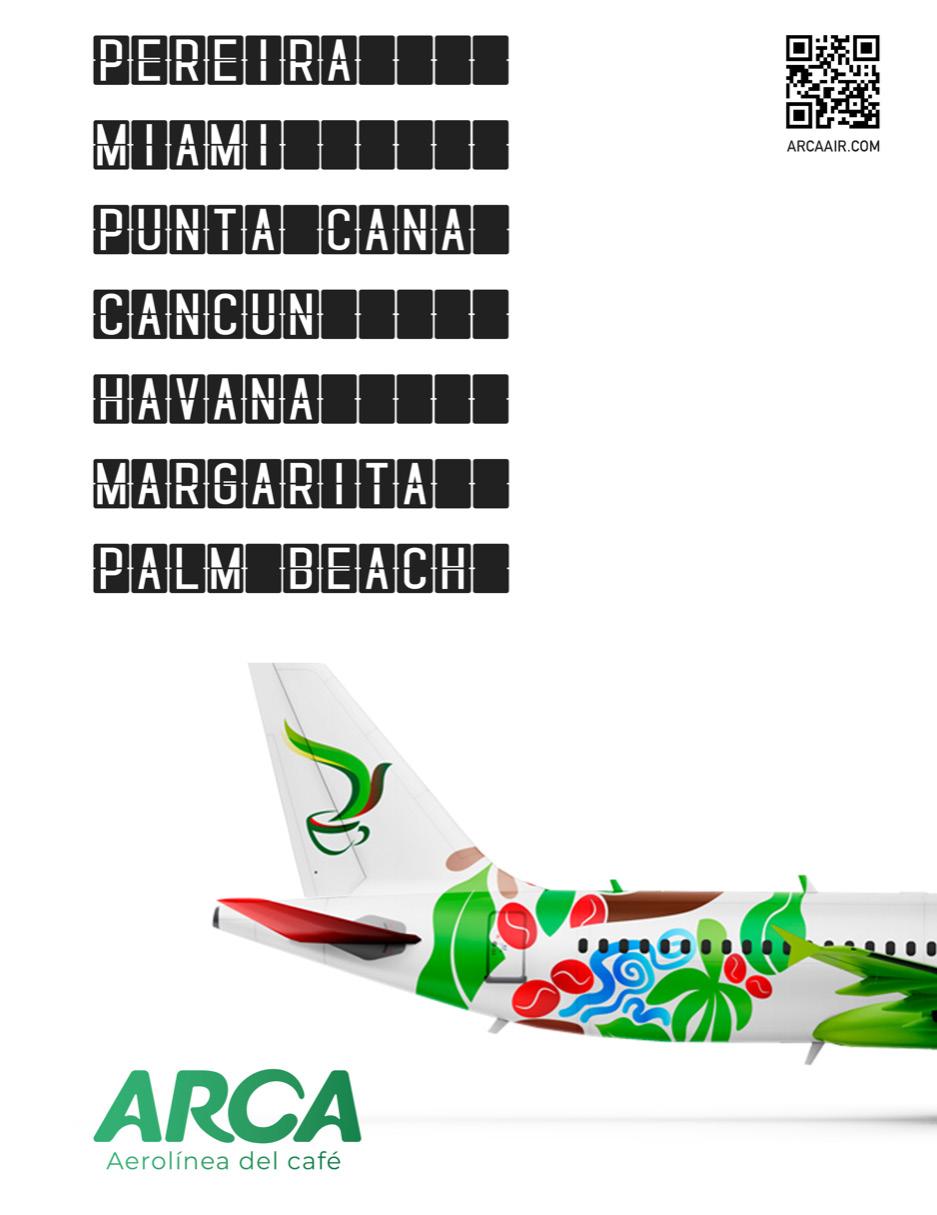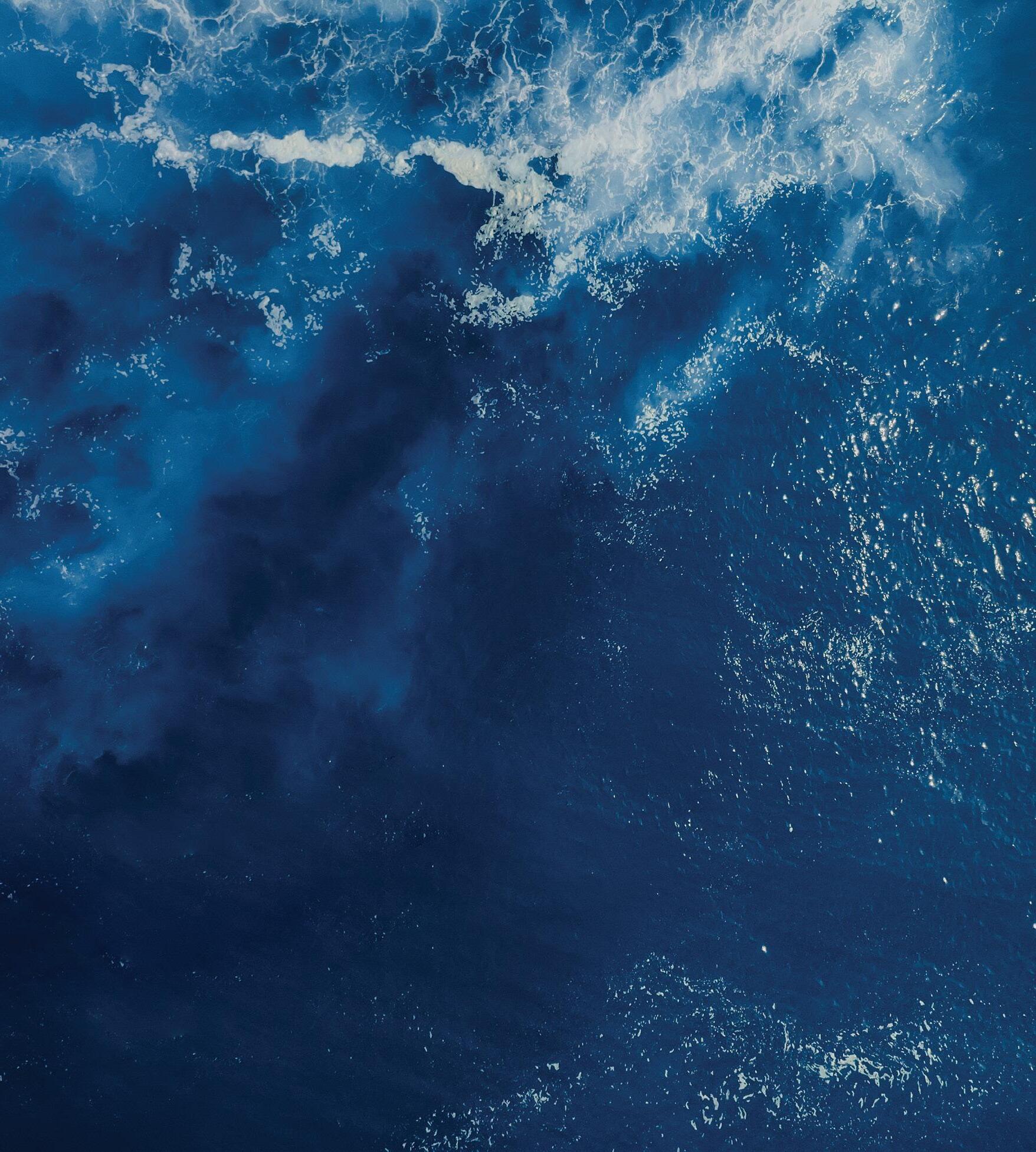GLOBAL MIAMI
Anabel Perez and the Tactics of Fintech
HOW NOVOPAYMENT IS CHANGING THE GAME PLUS: THE ANNUAL TRADE REPORT NEW FLIGHTS TAKEOFF AT MIA

















HOW NOVOPAYMENT IS CHANGING THE GAME PLUS: THE ANNUAL TRADE REPORT NEW FLIGHTS TAKEOFF AT MIA
















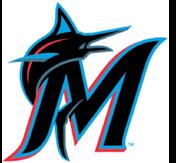
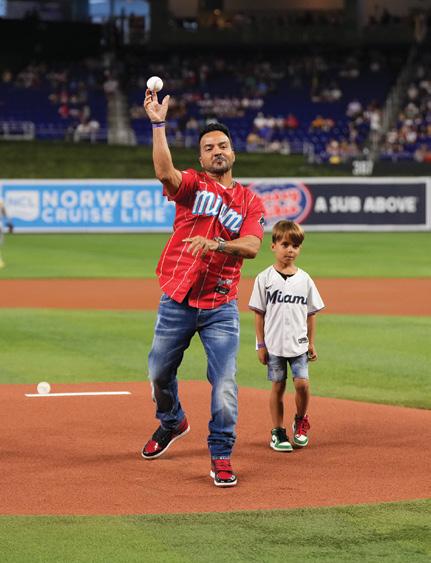 By David Oxfeld, Chief Commercial Officer of The Miami Marlins
By David Oxfeld, Chief Commercial Officer of The Miami Marlins

Miami is hot - and I’m not talking about the weather. The Miami Marlins are on fire, celebrating one of the franchise’s best starts to a season during the organization's 30th Anniversary. The team is performing great - collecting big hits, scoring runs, and striking out opponents. Most importantly, our world class organization is in the hunt for a playoff spot.
We’ve got a lot more baseball to play and the team is ready to compete down the home stretch.
We’re a young team with players making major strides right before our eyes. Records are being set and players have their eyes on a return to the postseason. First-year Manager Skip Schumaker has our squad focused on one job - relentlessly pursuing our win each and every day. Our All-Star players Jorge Soler and Luis Arraez often set the pace, Soler as a powerful designated hitter and Arraez chasing an astonishing .400 batting average not seen since Ted Williams in 1941.
Pitching: Sandy AlcantaraOff the field, the South Florida community continues to rally around their home team. In particular, local businesses are recognizing the value loanDepot park and the Miami Marlins can bring to their culture and their bottom line. It was a pleasure for the Marlins to recently create a special day for FPL’s full staff outing, including a private function where they introduced their new President/ CEO, followed by thousands of their team members attending a game that evening. Our partners at Norwegian Cruise Lines also utilized loanDepot park to make a major corporate announcement: that international recording artist and “Despacito” singer Luis Fonsi was their official new godfather. He even threw out the first pitch in front of a packed house.
Overall, attendance continues to climb significantly for Marlins home games for the second straight season. Especially in our premium PNC Club, which is sold out! These are some of the best seats in

the house, behind home plate, and actually the CLOSEST you can get to home and the catcher from any park in the majors.
Fish fans are also having fun watching the Marlins play from home - wherever they might live. So far this year, ratings for Marlins games broadcast by Bally Sports

are up 14% compared to last season. Plus, streaming of Marlins games in the Bally Sports app is up 77% compared to this same time last year.
loanDepot park’s state of the art retractable roof is a rare luxury for baseball fans. It allows us to avoid rain delays, keeping fans dry - and very cool - in our fully air-conditioned stadium. It’s a perfect location to catch a game or plan a corporate outing at any time throughout the year.
It’s a great time to be a Miami Marlin. I personally invite you to loanDepot park to watch the Marlins in action and let us know how we can help elevate your business. The environment is electric, and the fans are part of the equation that helps the players perform their best. And don’t forget, for our fans up north, you can jump on the Brightline for an easy and fast commute to loanDepot park and have fun with the whole family. Let’s play ball! Visit Marlins.com/tix.
L to R: Marlins Chief Commercial Officer David Oxfeld, FPL Vice President Pam Rauch, FPL COO Christopher Chapel, Mayor Daniella Levine Cava, FPL President Armando Pimentel, Norwegian Cruise Line President David Herrera, Marlins legend Jeff Conine, Marlins President Caroline O'Connor. Hitting: Jazz Chisholm Jr


With the largest multi-modal logistics network in the industry, PayCargo allows for faster release of cargo and improved daily cash flow for all types of freight payments and invoices.

Trade between the Miami Customs District and the world rose by more than $16 billion last year – and the future looks even brighter. In 2022, total trade for the Miami Customs District was valued at $136.6 billion, compared to $120 billion in 2021 and $96.8 billion in 2020.

How Anabel Perez of NovoPayment is helping to transform international payments systems, accelerate bank transactions, and incorporate immigrants into the financial system. The global fintech industry spans a wide range of companies and organizations, including those focused on banks like NovoPayment.
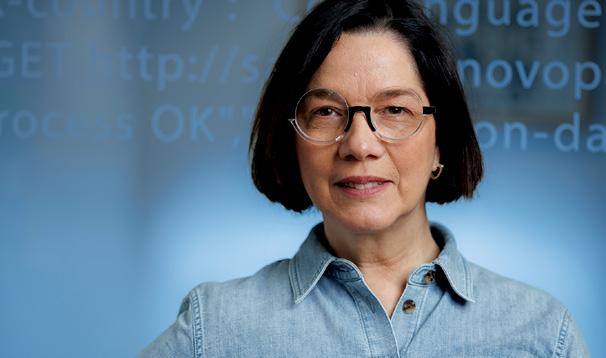
The most difficult area of post-pandemic recovery for airports worldwide has been in the international sector. Commercial flights took a huge dive over the last three years and are only now surpassing 2019 levels. International flights are taking even longer to recover. At Miami International Airport, however, the rehabilitation is almost complete.
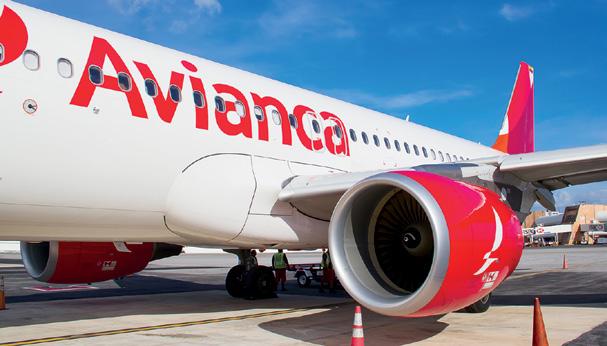

One of the aspects of reporting business news is the mission to cover major trends, highlighting icons in the specific industries covered – the major players, the major numbers, the major markets, the major trends. It goes with the territory.
Nothing is different with this month’s analysis of trade between the Miami Customs District and the world. If you look at the landscape of global trade in the South Florida Market, we are doing incredibly well. Our public and private sectors are “knocking it out of the ballpark.” (For that matter, so are the Marlins. But that’s another story.) Trade between the world and South Florida’s ports and airports rose by more than $16 billion last year, and the future looks even brighter.
We would expect that, as Florida benefits from the amazing migration push from Northeastern and well as Western states. The old adage, “Go West Young Man,” along with Frederick Jackson Turner’s conclusion from the late 1800s that “The Frontier is Closed,” has given rise to, “We’re moving to Florida. It’s a free state.” The point is that the global growth of trade (and business) that came with the incredible migration of corporations and individuals has given rise to new expectations. All is well. We’re more than thriving – we’re exploding with success.
Now, as for my reference to Aaron Copeland’s Fanfare for the Common Man. My origin for this theme goes back to the days when Greater Miami was working hard to get the Free Trade Area of the Americas (FTAA) to move their Secretariat from Latin America to Miami. Given that we had the Summit of the Americas in 1998 here, with President Clinton hosting events (many at the Biltmore Hotel), along with a litany of other world leaders from LATAM – ambassadors, trade consuls, CEOs of multinational firms, bankers, and finance ministers – Miami reinforced its position as the Trade Center of the Americas. So why not form a blue-ribbon panel to define and coordinate the effort to further position us as the strategic hub for this incredible
business? It made sense.
Gov. Jeb Bush clearly saw this as a great opportunity, appointing dozens of business leaders in the private and public sectors to create the Florida FTAA. I was appointed along with others to the board of directors.
One of the missions we defined as a group was to reach out to the local communities of South Florida (i.e. the Miami Customs District) to tell the story of what this global business really meant to the average citizen. You know – your neighbor, the guy who runs the dry cleaner, the office supply folks and so on. Even the pizza guy. Connect the dots for them. Overcome inertia and get a harmony of momentum going in our cities. In short, explain who would benefit from this explosion of business.
My lesson from those years is that it’s the Common Man (a la Copeland) who actually works the jobs created by trade. Working at our ports, airports, logistics companies, etc., in addition to jobs created at our retailers and small businesses. So even the pizza guy does better. We all do. The success of trade means we all rise together.
So, my suggestion? Grab your phone, ask Siri to play Fanfare for the Common Man, think of the “commoners” who make Miami work… and feel encouraged that we’re doing so well.
PUBLISHER
Richard Roffman

EDITOR-IN-CHIEF
J.P. Faber
SENIOR VP INTERNATIONAL
Manny Mencia
DIRECTOR OF OPERATIONS
Monica Del Carpio-Raucci
ASSOCIATE PUBLISHER

Gail Feldman
SALES AND PARTNERSHIPS
Sherry Adams
Amy Donner
Andrew Kardonski
Gail Scott
MANAGING EDITOR
Kylie Wang
ASSOCIATE EDITOR
Yousra Benkirane
WRITERS
Doreen Hemlock
Joe Mann
Katelin Stecz
Harriet Mays Powell
ART DIRECTOR
Jon Braeley
PHOTOGRAPHERS
Rodolfo Benitez
Tiege Dolly
PRODUCTION DIRECTOR
Toni Kirkland
CIRCULATION & DISTRIBUTION
CircIntel
BOARD OF ADVISORS
Ivan Barrios, World Trade Center Miami
Ralph Cutié, Miami International Airport
Gary Goldfarb, Interport
Bill Johnson, Strategic Economic Forum
David Schwartz, FIBA
Bill Talbert
EDITORIAL BOARD
Alice Ancona, World Trade Center Miami
Greg Chin, Miami International Airport
Paul Griebel, Venture for America
Jerry Haar, Florida International University
James Kohnstamm, Beacon Council
John Price, Americas Market Intelligence
TJ Villamil, Enterprise Florida
P.S. I'm pleased to inform you that Global Miami Magazine was voted the CHARLIE AWARD FOR BEST NEW MAGAZINE IN THE STATE OF FLORIDA IN 2022 by the Florida Magazine Association at this year's annual Awards Ceremony held in Sarasota, Florida July 22nd.
Global Miami Magazine is published monthly by Global Cities Media, LLC. 1200 Anastasia Ave., Suite 217, Coral Gables, FL 33134. Telephone: (305) 452-0501. Copyright 2023 by Global Cities Media. All rights reserved. Reproduction in whole or part of any text, photograph, or illustration without o\prior written permission from the publisher is strictly prohibited. Send address changes to subscriptions@ globalmiamimagazine.com. General mailbox email and letters to editor@globalmiamimagazine.com
Let’s think big. No, let’s think global.
Banking should reach any and everywhere you need it to. At Amerant, international banking is one of our specialties. Same personal touch, same focus on your financial goals, but on a global scale.
Let’s talk, and we’ll provide international solutions tailored to your specific needs.
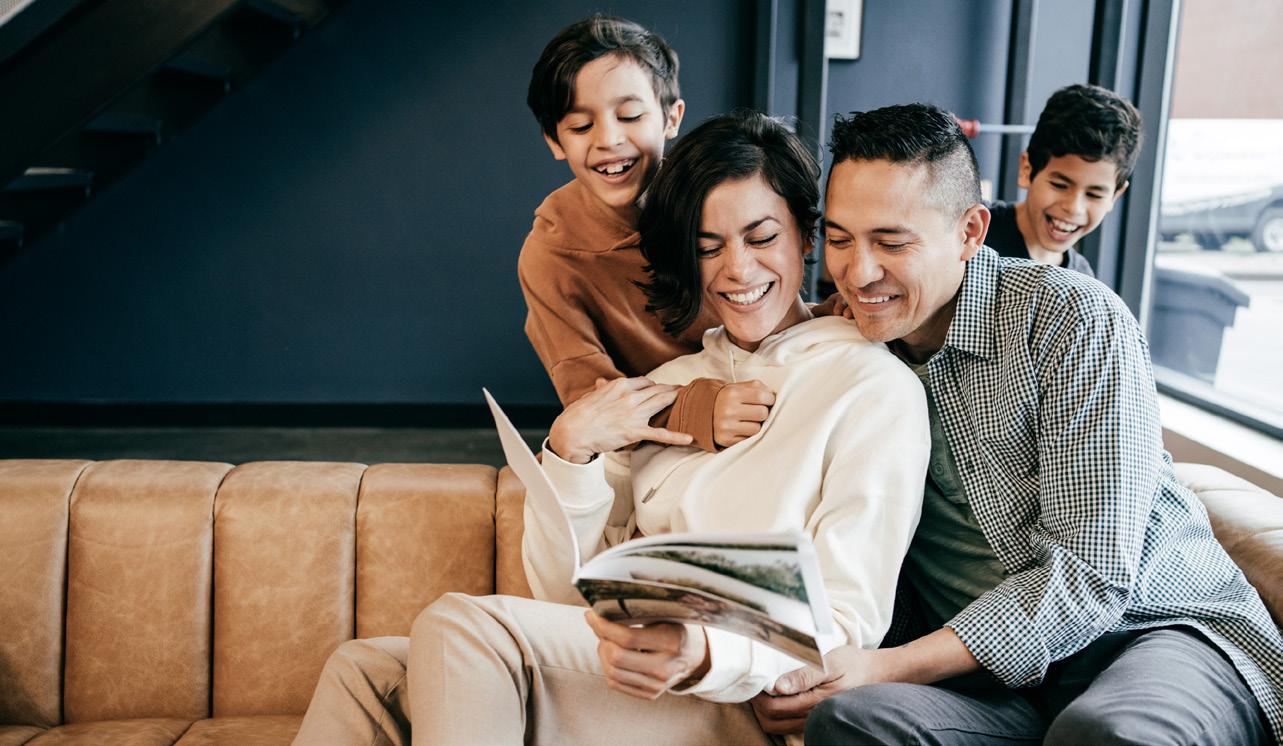 Member FDIC
Member FDIC
The New Testament asserts that the poor will always be with us. Well, so will the rich – and given a choice of residence they will invariably choose Miami rather than Bismarck, North Dakota, or Wet Beaver Creek, Arizona. Wealthy individuals, comprising current residents, new arrivals (including CEOs and top executives), and snowbird tourists, are driving luxury to a new level in Greater Miami. The word luxury is never far from the description of any high-rise or mansion for sale.
BY JERRY HAARWhile “wealth” and “luxury” are invariably intertwined, only the former can be quantified; for “luxury” is subjective, ever-changing, and subject to both short and long product life cycles (a fad for just one season, or enduring). So, who is the luxury consumer, what do they seek, and how do luxury brands respond to (and create) demand?
First, let’s have a look at the luxury market. After a severe contraction in 2020, the luxury market grew back by over 20 percent in 2022, with 95 percent of brands experiencing growth. The market is expected to expand by 50 percent by the end of the decade to $718 billion.
Vuitton bags) while other prefer understatement without signs, like the woven Bottega Veneta handbags. For Millennials, they seek purchases that define their personal values and are twice as likely to purchase from firms with a good ESG track record.
In one recent international study, researchers found that the key factor in making luxury desirable was its power “to impress others, combined with a high price.” Simply stated, shoppers have a psychological need for status and exclusivity. The message? Exhibit the logo and brand yourself. According to Deepak Ohri, CEO of Lebua Hotels and Resorts, “passion and emotional connection” are what drives spending on luxury.
In terms of business strategy, luxury brands are positioning themselves to capitalize on the increasing drift of in-store to online merchandise sales. All indications are that online will be the leading channel for luxury goods, with one-third of the market share followed by monobrand stores such as Acqua di Parma at Brickell City Centre. At the same time, luxury brands are taking control of their own second-hand markets – Rolex’s certified pre-owned program is a prime example. Overall, second-hand luxury has witnessed a 65 percent increase from 2017 to 2021; just look at Burberry’s and Gucci’s arrangements with The RealReal.
Jerry Haar is a professor of international business and executive director for the Americas at Florida International University. He is also a global fellow of the Woodrow Wilson International Center for Scholars in Washington, D.C. And a board member of the World Trade Center Miami
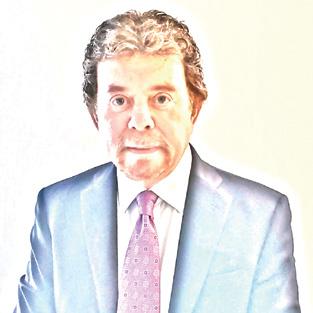
As for who is the luxury consumer, it should come as no surprise that GenY (aka Millennials), GenZ, and the emerging Alpha generation (those born after 2010) are and will continue to be the biggest buyers of luxury. Millennials and GenZ alone accounted for the entire growth of the global luxury market in 2022, and by 2030 Millennials will hold five times as much wealth as they do today.
Today’s consumers are changing how they define luxury and new paths for purchasing are redefining marketing strategy. As pointed out by marketing and branding guru Michael Solomon, luxury consumers are not a monolith. Some prefer visual icons, logos, monograms, and patterns (e.g., Louis
For Dr. Anna Pietraszek, Director of FIU’s Pino Global Entrepreneurship Center, luxury clusters like the Miami Design District can spur economic development adjacent to their locale. The big question is: how does Miami keep the luxury renaissance moving forward? The answer is key, since luxury plays a symbiotic role in our economy with a dynamic relationship between real estate, automobiles, hotels and resorts, restaurants, clothing, footwear, jewelry, and recreational activities. Economic conditions both globally and locally will impact spending patterns, but the luxury-seeking will continue to dine at L'Atelier Joël Robuchon, shop at Bal Harbour Shops, and purchase a Porsche 911 Carrera. For Greater Miami, luxury is self-propelled. For, as the late model and designer L’Wren Scott discerned: “Luxury is a state of mind.” l
One of the drivers of Miami’s growth is its position as a global hub for luxury

plan to increase tourism. The airline is also adding weekly nonstop service to Governor’s Harbor in the Bahamas on Tuesdays and Thursdays starting February 2024, becoming the only U.S. carrier flying nonstop from MIA to Governor’s Harbour. Additionally, in the winter, the airline will increase the number of peak-day departures from MIA to more than 70 destinations in Latin America and the Caribbean, including Liberia, Costa Rica; Cartagena, Colombia; and Tortola, British Virgin Islands.
Saudia Cargo, the Saudi Arabian air freight flag carrier, has joined Pharma.Aero, a cross-industry platform for healthcare logistics. Saudia Cargo hopes to expand and upgrade its pharmaceutical transportation capabilities using the expertise of Pharma.Aero, which was established in 2016 by Miami International Airport and Brussels Airport to enhance pharma handling and quality in the global air cargo market.
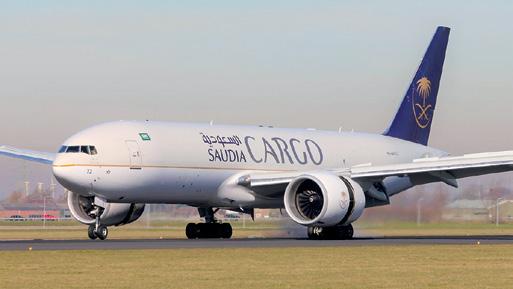
Following Florida’s newly enacted anti-immigration law, which allows authorities to charge someone with human trafficking if they knowingly transport an undocumented migrant across state lines, arbitration practitioners called on the International Chamber of Commerce to move its annual conference out of Miami in protest. The ICC ultimately rejected this request, and the conference will be taking place in Miami from November 12 to 14.
Maurice Jenkins, above center, the chief innovation officer (CIO) of Miami International Airport, was named the 2023 recipient of the Best Airport Innovation Leader Award by Airports Council International World and Amadeus. This award is one of three technology innovation awards given by the international organization to airports for their exceptional use of technology and leadership.

The Miami-Dade Innovation Authority, a nonprofit that encourages collaboration between local government and tech companies to find innovative solutions to raise living standards for area residents, has announced its first public challenge. The nonprofit is looking for sustainable ways to beneficially repurpose sargassum, a type of seaweed known for creating large floating mats that wash up on beaches during the warm summer months. The Miami-Dade Innovation Authority will select at least three technology start-ups in the early-to-growth stages; each will get a $100,000 grant to support more research and development on ecologically friendly ways to process sargassum.

Miami’s most popular summer fashion event, Miami Swim Week 2023, showcased a large variety of international talent. Among the many Latin designers and brands on display were GIANNINA AZAR, a Dominican and Lebanese fashion designer; CHAVEZ, the brand of Guatemalan designer Antonio Chavez; and Pink Melon Swimwear, a brand created by Cuban-born designer Sandra Santana.
American Airlines will establish a second daily nonstop service in December between Miami International Airport and Piarco International Airport in Trinidad. The expansion is part of the island’s
The Miami-Dade County Commission voted unanimously to award a contract to FDR Miami Hotel LLC, the company that received the highest rating throughout the competitive selection process, to construct a new airport hotel connected to Terminal D.

Over the life of the 50-year lease, the FDR project is expected to generate around $240 million in revenue for the county. FDR is a joint venture between The Related Companies, which is chaired by Miami Dolphins owner Stephen Ross and Fontainebleau Development LLC, a Miami-based company led by Jeffrey Soffer.
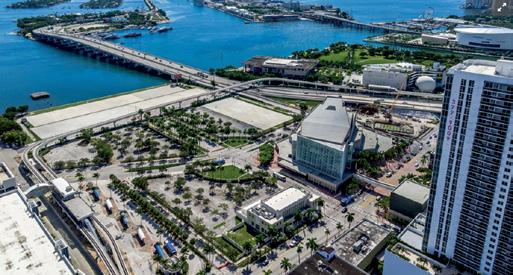
Headquartered in Dania Beach, Florida, pet supply retailer Chewy is expanding to its first market outside the U.S. – Canada. Later this year, the brand will launch in the Greater Toronto area before expanding across the country. Chewy reported $2.8 billion in net sales during Q1 of 2023.
America, Claure had provided funding to several Miami tech firms through SoftBank’s $100 million Miami Initiative, a program that exclusively invests in Miami companies and ventures that relocate to the city.
MyFBAPrep is adding around 70 million-square-feet of warehouse space to its global portfolio, including 17 new facilities in four countries, totaling 85 million-square-feet globally. The Sunrise, Florida-based company provides Fulfillment by Amazon (FBA) services, which helps third-party sellers use the Amazon.com platform to reach consumers. MyFBAPrep’s technology connects sellers with warehouses for e-commerce fulfillment services worldwide. The company now has more than 100 warehouses across the U.S., Canada, Mexico, the United Kingdom, and Germany.

Damac International, based in Dubai, has revealed its plans for a new luxury condominium on the site of Champlain Towers South, the condo which collapsed in 2021, killing 98 people. Damac acquired the 1.88-acre site for $120 million in July 2022 from a court-appointed receivership. The new building will have two connected towers 12 stories high, with 57 units ranging from 4,000 to 15,000-square-feet. The project is being designed by Zaha Hadid Architects, the world-renowned firm founded by the late Zaha Hadid, which designed the striking One Thousand Museum tower in Downtown Miami.

Miami-based startup Cargobot, which specializes in digital logistics solutions, has raised $6 million to enhance its technology. Cargobot’s digital platform is designed to help shippers move cargo more efficiently. Founded in 2016, Cargobot operates with offices in North America, Spain, and Colombia. Cargobot SaaS, its softwareas-a-service arm, is now available in Colombia, Chile, Peru, Saudi Arabia, and Spain. The company, with 80 employees, is supported by $18 million in investor capital.
Billionaire entrepreneur Marcelo Claure (above), the former CEO of Japanese-based SoftBank Group International, has teamed up with former SoftBank managing partner Mwashuma “Shu” Nyatta to create Bicycle Capital, a new private equity firm with initial commitments of about $440 million. Bicycle Capital I, the firm’s fund, will focus on assisting Latin American entrepreneurs to scale their startups; Claure had previously spearheaded the launch of Softbank’s $8 billion Latin American Fund. The new firm is primarily funded by Mubadala Investment Company, an Abu Dhabi-based sovereign investor, and the Claure Group. In addition to Latin
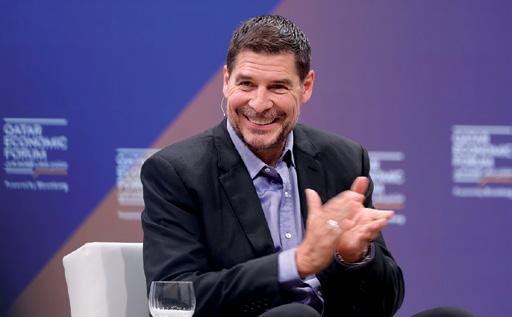
The $1.225 billion sale of the former Miami Herald site in Downtown Miami has been cancelled. The 15.5-acre site was originally purchased in 2011 for $236 million by Malaysia-based Genting Group, which had hoped to develop a casino. That project was blocked by the Florida legislature, which would not allow gambling there. Now zoned for 60 stories and 21 million-square-feet (allowing 7,750 residential units), it was announced in May that the property would be purchased by SmartCity Miami LLC, an investment group led by David Martin, the CEO of Miami-based Terra. SmartCity had asked for changes to the agreement which were rejected by Genting. l
Taiwan does not have a consular office in Miami, but it maintains a diplomatic presence that is roughly equivalent – the Taipei Economic and Cultural Office. The current director is Charles Chi-Yu Chou, who has been in that position since February. He spearheads the relationship
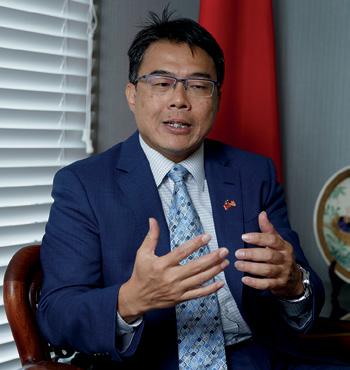

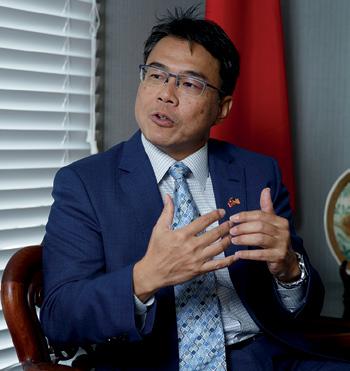
We are the foreign mission of Taiwan for Florida, Puerto Rico, the U.S. Virgin Islands, the Dominican Republic, the Bahamas, Bermuda, and the Turks and Caicos Islands. Since my office was set up here in 1988, the main mission is to promote bilateral economic and cultural ties. My office has all the functions of a Consulate General – we can issue visas and renew passports. The main job, of course, is to promote goodwill between Taiwan and Florida… Our office name is the Taipei Economic and Cultural Office, so actually there are two things. [First,] we focus on promoting trade and economic cooperation with Florida, and the second thing is culture, which also covers education.
There are about 80,000 Taiwanese in Florida, some in Miami but a lot in the Orlando area. There are also quite a lot of Taiwanese companies stationed here. They take [Miami] as a gateway to Latin America, to the Caribbean. Some are renowned companies, like King of Fans, which is actually one of the top three selling fan makers in the United States. You can buy them in Home Depot, even Walmart. Then there is BioTissue, with a focus on stem cell research… [and] ADATA, which focuses on power packs [for cell phones].
When we talk about trade, we need to talk about [direct] investment, which is sometimes related… Not long ago, I contacted Enterprise Florida because one of our Taiwanese companies [that manufactures EV charging stations] wanted to expand to Florida. But Taiwanese companies are facing a tax barrier. Taiwan and the U.S. don’t have an agreement to avoid double taxation, [so] Taiwanese companies need to pay 30 percent withholding taxes whereas Korea, for example, has signed an agreement where they need only pay 10 percent. We should conclude that agreement as soon as possible in order to make the economic relationship between Taiwan and the U.S. even closer.
between Florida and Taiwan, which is the ninth-largest trading partner with the U.S.; total trade between Taiwan and the Miami Customs District is now just shy of $1 billion. We sat with Director General Chou to discuss his vision of Taiwan’s relationship with Miami.
Japan is working on a direct air link to Miami. What about Taiwan?
We have direct flights to Los Angeles, San Francisco, Chicahope we can see our national airline fly here. But the problem is whether they have enough passengers to sustain the route. My idea is to do it like a charter first, flying from Taiwan to Orlando because Orlando is a tourism brand for little kids, and gradually make it a regular flight. And then the next step would be Miami.
PortMiami, actually, has built up a very close relationship with Port Kaohsiung, one of the major harbors in Taiwan. So that’s one reason we are always saying that Taiwan and Florida have a very close relationship, even though we are far apart.
Education for me is a priority. Nowadays, Taiwan has 20,000 students studying in the U.S. But how many study in Florida? Only 400. So, I’m thinking that not many Taiwanese people know that Florida actually has a very good, high quality education system. A challenge for me is that I would like to do more to promote, together with a university here, the higher education system to the young students [in Taiwan].
I would like to express my appreciation for the longtime support from the Florida government and legislature. We highly appreciate all the moral support from our friends [here]; that is very important to Taiwan… Another thing I want to say is that a lot of people know that China does military exercises around Taiwan to make the area dangerous. But, actually, if you have the chance to go to Taiwan, you will find out that life is going on as usual. We’ve been living under this kind of threat for more than 70 years. l
Nichols Architects. Over 55 years shaping communities and inspiring people through remarkable, high-performing architecture.


nicholsarch.com
 Loews, Miami Beach
Loews, Miami Beach
TWENTY YEARS INTO ITS FREE TRADE AGREEMENT WITH THE U.S., CHILEAN COMPANIES ARE NOW USING MIAMI AS THEIR U.S. GATEWAY
BY YOUSRA BENKIRANEDiego Jerez, U.S. country manager at Option, joined the Chilean-based IT development and consulting firm last year when the company decided to expand into the U.S. through Miami. Option specializes in data management and has clients in a dozen countries, mostly in South and Central America, with 180 employees working globally. “We decided to come to the States because we have large clients in South America – one of the largest retail companies, one of the largest airline companies, mining companies…. We were ready to go to the
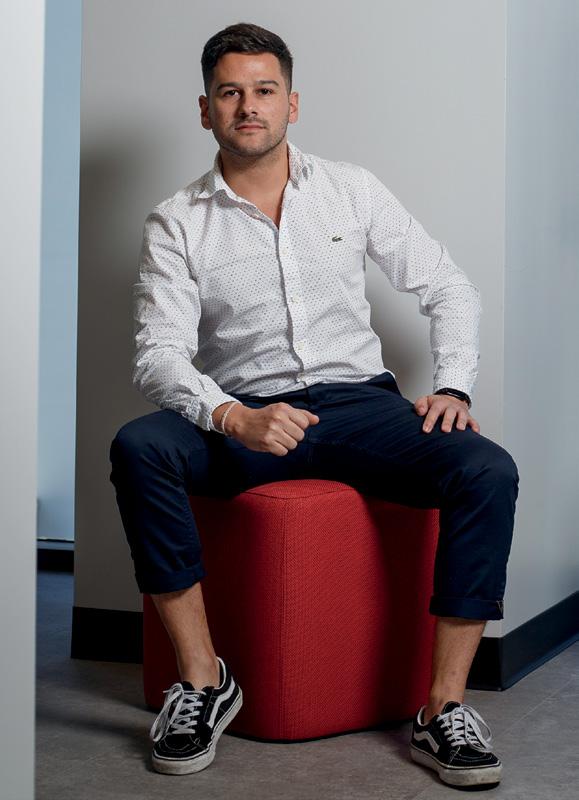
next step,” says Jerez. “There’s a very strong Chilean community in Miami. They talked to us and said, ‘You should come here because there are a lot of business opportunities.’”
This year marks the 200th anniversary of U.S.-Chile diplomatic relations; this June also marked the 20th anniversary of the signing of the United States and Chile bilateral free trade agreement (FTA) in Miami. Since then, Miami has played an important role in maintaining a robust economic relationship with Chile, characterized by trade partnerships and direct investments.
There’s a very strong Chilean community in Miami. They talked to us and said, ‘You should come here because there are a lot of business opportunities...
The U.S. is seen as a strategic market for Chilean companies, which can export their goods and services to the largest economy in the world without paying import tariffs, thanks to the FTA. This has created an incentive for Chilean companies to expand into the U.S. market, often setting up operations in Miami. More recently, Chile’s thriving startup ecosystem and Miami’s growing reputation as a tech hub have led to Chilean tech and medical companies establishing their U.S. footholds in Miami.
Like other Chilean firms that have

ProChile is planning to carry out three programs for Chilean startups interested in entering the U.S. market through Miami during the fourth quarter of 2023.

GO GLOBAL
A soft landing and mentoring program that seeks to support international expansion in the Americas, including the U.S., of Chilean companies that offer a technology-based and sophisticated product with scalability. The program has supported more than 130 Chilean startups in their international expansion process. Ten firms are expected to participate in 2023.
EDTECH IMMERSION WEEK
EdTech Immersion Week is an initiative to introduce Chilean education technology companies to Miami’s business ecosystem through different activities and mentoring sessions. In its first phase in 2022, eight companies were part of the program. An additional eight startups are expected to participate this year.
FINTECH MISSION
A soft-landing program to support the expansion of Chilean fintech companies in the U.S. Eight startups are expected to participate this year.
For more information, contact us.miami@prochile.gob.cl
expanded into Miami, Option turned to ProChile – Chile’s nonprofit trade commission – for support and resources. Through ProChile’s GoGlobal program (see above), Pizarro participated in a soft landing where he was able to network and gain an understanding of the city’s business environment before officially starting work in the metropolis. ProChile also arranged for Option to have a booth at the eMerge Americas conference this year. “We were able to meet other entrepreneurs and potential customers,” says Jerez. “The environment that ProChile has built in Miami is very rich.” In the last two years, ProChile has assisted in bringing 34 tech companies to Florida.
Chilean-based Genosur, a medical device manufacturer, also participated in a soft landing as first-generation GoGlobal participants in 2019. Shortly after the pandemic broke out, Genosur began developing COVID-19 sample collection and transport kits to get results back in hours. Matias Gutierrez, founder of Genosur, worked closely with the Cambridge Innovation Center in Miami, where he was provided lab
space. He brought scientists from Chile to Miami for research and development. They developed a technology called Nona AMP, which allows for a fast turnaround in PCR testing. With this tech in hand, the company set up a Miami lab for COVID testing in late 2020. Gutierrez, who has a PhD in biotechnology, was then engaged to analyze COVID variants for Miami-Dade County. Genosur gained even more credibility after the Chilean government ordered its first COVID sampling kits from them.
Gutierrez credits much of Genosur’s success to working with ProChile. “They helped us a lot,” he says. “Part of the reason that we were able to accomplish what we did was that we had the experience of coming to the U.S., being in Miami, and making the right associations. People make the connection: Miami first, then success.”
ProChile Trade Commissioner Claudia Serrer, who manages the Southeast U.S. market from Miami, emphasizes the synergy between the two regions, noting how Chile and Miami are both business-driven economies, with open environments for collabo-
We are here to be that connector between both markets… developing networks for Chilean companies coming to the market, but also U.S. companies that want to go to Chile.”
CLAUDIA SERRER (ABOVE), PROCHILE TRADE COMMISSIONER, MANAGES THE SOUTHEAST U.S. MARKET FROM MIAMI.
IMPORTS VALUE FROM CHILE: $2.38B
TOP 5 COMMODITIES:
1. Fish Fillets: $1.82B
2. Unspecified Commodities: $340M
3. Fresh Fish: $130M
4. Fruits: $50.9M
5. Dried, smoked, salted, in brine fish: $44.9M
ration and innovation. Both have a growing startup ecosystem, both are emerging as tech and innovation hubs, and both have a large population of Spanish speakers. It’s a natural partnership that continues to grow. “We want to be talking about innovation. We want to talk about technology. And we have different industries and sectors that we can emphasize to develop our relationship and the business we can do together,” says Serrer. “We are here to be that connector between both markets… developing networks for Chilean companies coming to the market, but also U.S. companies that want to go to Chile.”
Serrer works in Brickell, Miami’s financial district, and finds it similar to the financial district in Chile’s capital Santiago. She says both Miamians and Chileans are very straightforward. “We believe in trust. When you do business with Chile, you know that it’s a country you can trust.”
The economic ties between Chile and Miami go back to the early 19th century when merchants from the U.S. began trading with Chilean ports. Chile remains a top trade partner for the Miami Customs District, with bilateral trade totaling $7.45B in 2022. Top exports to Chile included aircraft parts ($665M), computers ($388M), and
EXPORTS VALUE TO CHILE: $4.62B
TOP 5 COMMODITIES:
1. Aircraft parts: $665M
2. Computers: $388M
3. Telephones: $364M
4. Excavation Machinery: $205M
5. Gas turbines: $162M
Source: U.S. Customs, State Department
telephones ($364M). The top imports from Chile were fish fillets ($1.82B), unspecified commodities (largely copper and copper ore, $340M), and fresh fish ($130M).
LATAM Airlines Group, and more specifically its cargo division, has been a major facilitator of trade between the two regions. LATAM Airlines initially began as a Chilean cargo carrier and has evolved into the largest airline group in South America. Historically, Miami has been the main point of entry into the U.S. market for air freight, which is why the airline’s cargo headquarters are in the city. “The geography is unbeatable. You can pretty much access the rest of the U.S.,” says Andres Bianchi, CEO of LATAM Cargo. “Miami is also the main export gateway from the U.S. into South America and Chile.”
Cargo from the Midwest usually gets trucked to Miami and then distributed to South America from Miami International Airport. In the opposite direction, LATAM uses its fleet of Boeing 767 freighters to carry perishables from Chile to North America, such as salmon and seasonal fruits. LATAM is the largest carrier of Chilean salmon coming to the U.S.

The preponderance of Miami’s current
exports to Chile are high-tech products. That trend may see some shift, says Bianchi, as the production of high-tech goods relocates to the Americas following recent disruptions in the global supply chain, which has encouraged source diversification and nearshoring. “Products that are now manufactured in certain Asian countries may move to other countries, like Mexico,” he says. “And air freight has a higher share of the transportation of those products, so air freight may change to some extent.”
Regardless of shifting trade patterns, as Chile continues to position itself as a trade hub for Latin America, Miami will continue to play a vital role as its Gateway to the Americas. “We’re celebrating 20 years, so we look at what we’ve done in the last 20 years,” says ProChile’s Serrer. “But for me, it’s ‘What are we going to do in the next 20 years?’ We want Chile to keep being a strategic partner but also keep being part of the changes that are taking place in Miami.” l


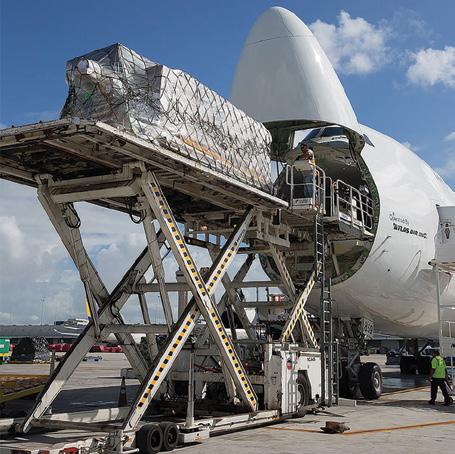
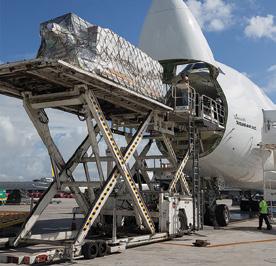
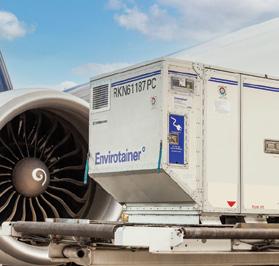
CEO Luis Arguello Jr. faces a paradox at work every day. His family’s South Florida manufacturing company Demetech exports to 135 countries around the world, but finds it hard to sell inside the United States.

Demetech makes surgical sutures and other medical supplies, employing some 500 people in a sprawling factory, warehouse, and office complex in Miami Lakes. Arguello says buyers overseas snap up Demetech’s sutures and surgical goods, perceiving the “Made in the USA” label as a symbol of quality and worthy of a premium because of its American origin. Yet U.S. hospitals for years have been buying the bulk of their supplies from overseas, seeking to keep costs down and making it tough for smaller producers like Demetech to sell domestically.
“To break into the U.S. healthcare market was quite difficult for us, so we’ve focused on the international market,” says Arguello, whose Nicaraguan immigrant family developed Demetech in the 1990s. Indeed, many of the company's competitors have moved production from the U.S. to Mexico, he laments.
COVID-19 changed things temporarily. The pandemic disrupted global supply chains, leaving many U.S. hospitals scrambling for supplies, especially surgical masks. Demetech scaled up in 2020 to make masks for U.S. customers, employing more than 2,000 workers on three shifts at peak production.
“We went from never making a mask to becoming the largest mask factory in the U.S. in about 90 days,” says Arguello. “Why? Because we had the manufacturing infrastructure for producing in this country, and we had skilled workforce in terms of engineering, regulatory, and production processes.”
But even that emergency effort met obstacles, Arguello says. While the U.S. government encouraged domestic production, many U.S. buyers did not finalize purchases expediently, leaving Demetech with millions of masks on its shelves for months waiting for orders to come through.

Now, Demetech is building on its COVID experience to encourage U.S. hospitals to “re-shore” supplies longer-term, provided that orders are signed in advance. Arguello says it makes business sense for the hospitals to buy American, so they’re not caught flat-footed should another pandemic take place.
Arguello says U.S.-made goods can compete with overseas supplies, even when labor costs are lower abroad, for several reasons. First, labor is just one component in the cost of medical supplies. Shipping and logistics often make up as much as 35 percent of total cost, so eliminating the need for transport from Asia or other distant locales means significant savings. Also, time is money, and producing domestically can slash delivery time, allowing companies to use “just-in-time” arrivals and trim inventory costs.
Then there’s what Arguello calls the “security” issue. COVID showed that hospitals pay a price for relying on a $1 item from China. “With the pandemic, hospitals ended up paying $5 or $8 for
SOUTH FLORIDA MANUFACTURING IS MORE ROBUST THAN YOU THINK. JUST ASK DEMETECH.
We went from never making a mask to becoming the largest mask factory in the U.S. in about 90 days.
LUIS ARGUELLO, ABOVE, CEO OF DEMETECH, MIAMI BASED MANUFACTURER OF MEDICAL SUPPLIES.
ABOVE: DEMETECH WAREHOUSE WITH ORDERS READY FOR SHIPPING TO VIETNAM
that $1 product. And they sometimes paid high prices for products that didn’t even work, just to get them. Some created huge inventories to not run out,” he says. “What we need is to support domestic production long-term.”
With all the talk of “offshoring” and the buzz over tech jobs these days, it’s easy to underestimate the strength of U.S. manufacturing. Yet Demetech’s 500 jobs and its ample sales to Italy, Vietnam, the United Arab Emirates, and another 130-plus countries shows that manufacturing remains a South Florida staple.
Miami-Dade, Broward, and Palm Beach counties are now home to some 5,000 manufacturing firms, most employing 50 or less people. Miami-Dade alone has some 40,000 people working in manufacturing, many in medical, pharmaceutical, and aviation fields that employ skilled staff, says Matthew Rocco, president of the South Florida Manufacturers Association, based in Fort Lauderdale.
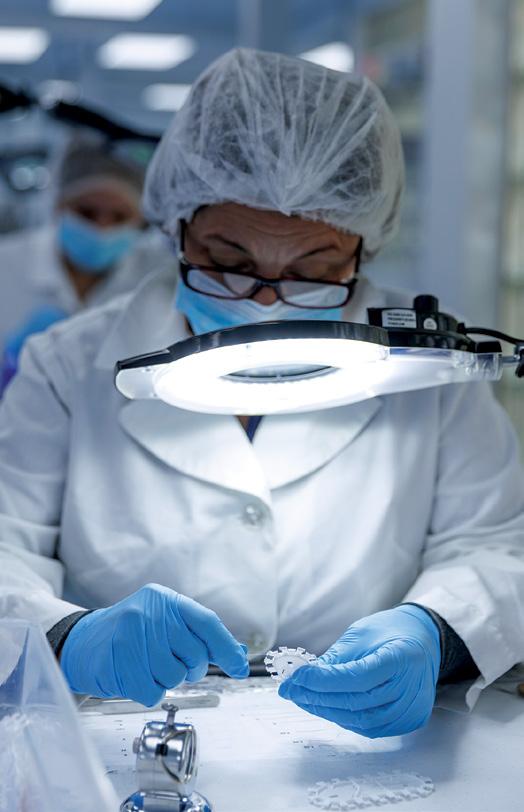
“People tend to think of manufacturing as a blue-collar industry, but there’s a lot of technology and clean-room environments involved in South Florida these days,” says Rocco. “The jobs are not just [for] machine operators anymore. It’s often an engineer, for example, who earns high pay.”
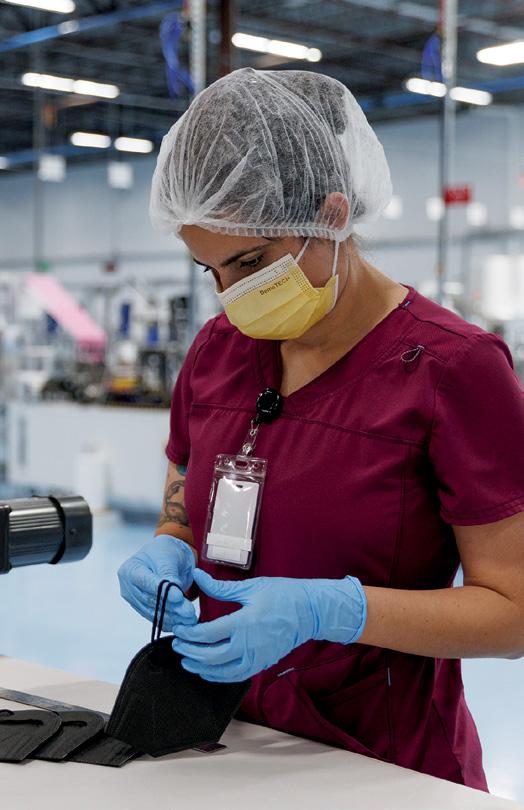
To be sure, South Florida manufacturers face challenges from rising costs for land, rent, and salaries. Yet there are many resources
to help producers move up the value chain, automating more tasks and employing more skilled labor. For example, the Manufacturing Extension Partnership Center for Florida and its Florida Makes program offer help with training, mentoring, and other services. And both the state and federal governments have programs to help manufacturers boost exports.
Demetech has developed its overseas sales, partly through programs from the U.S. Commerce Department and U.S. Export-Import Bank. The Ex-Im Bank provides insurance that helps companies get credit lines from banks to give overseas buyers more time to pay. Demetech has also participated in numerous Commerce Department missions overseas, which include matchmaking sessions with potential customers. Commerce selected Demetech for one of its top national export awards in 2010, an honor for the family that relocated from Nicaragua.
“We, as immigrants. are very big on the American dream,” says Arguello, who holds a degree in economics and politics from Notre Dame University. “And we believe in making things here in this country.” l
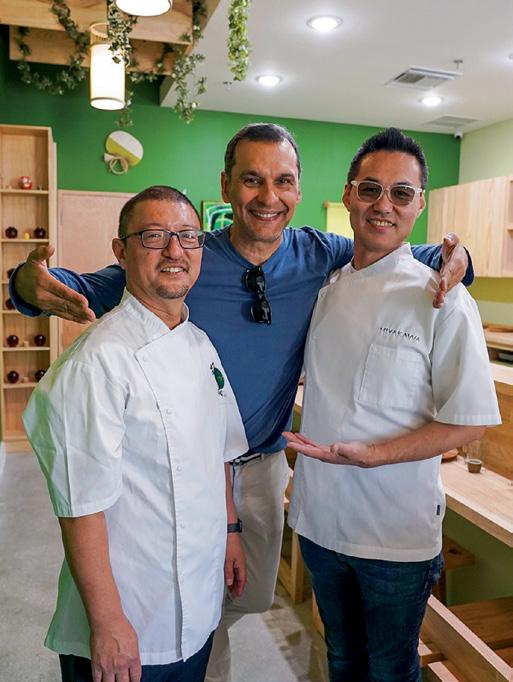 THE ROUNDABOUT
THE ROUNDABOUT
 ALVARO PEREZ MIRANDA
BY GUISELLE ARCINIEGA GOMEZ/COMMUNITYWIRE.MIAMI
ALVARO PEREZ MIRANDA
BY GUISELLE ARCINIEGA GOMEZ/COMMUNITYWIRE.MIAMI
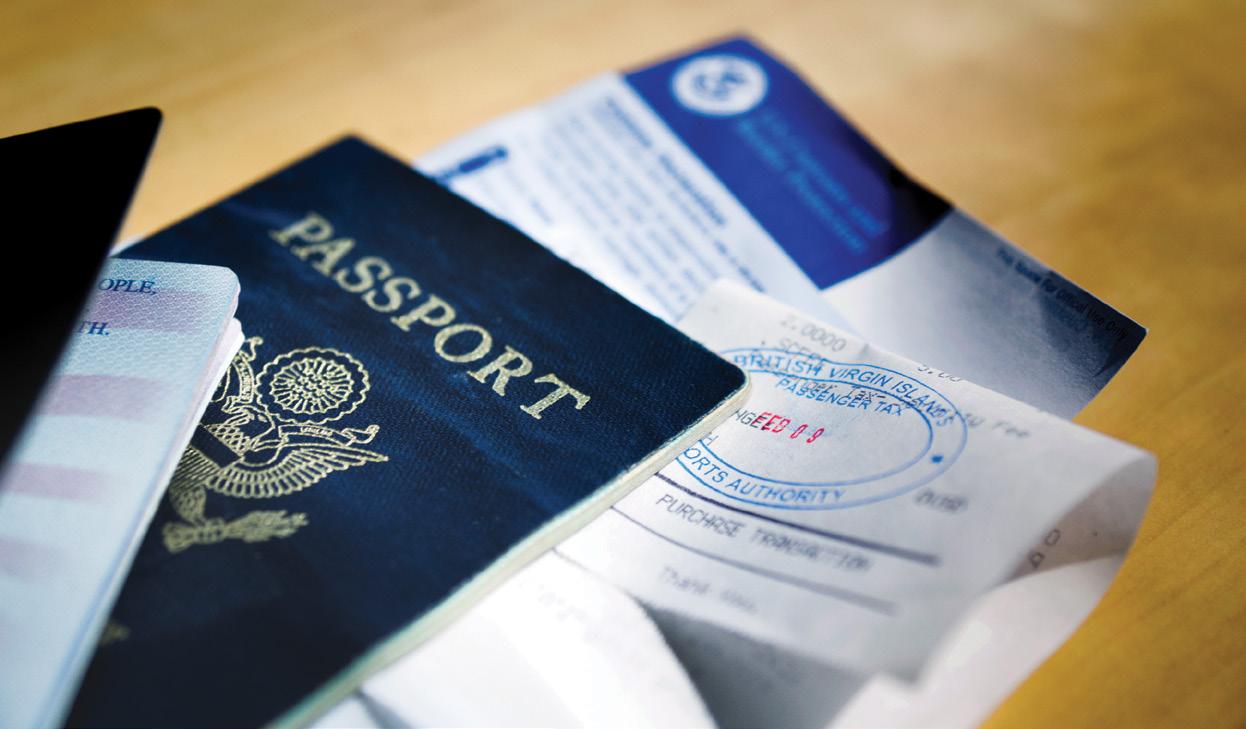
With South Florida hosting the largest concentration of Venezuelans in the United States, one might easily guess why Alvaro Perez Miranda migrated to the area in 2015. Hailing from Valencia, the country’s third-largest city, the veteran restaurateur and art dealer found he could be culturally comfortable in Miami, where Spanish is commonplace and the local cuisine encompasses arepas, tequeños, and tostones.
But that was not his inspiration for coming to Miami, nor his mission here. Perez Miranda’s global travels – including stints in Italy, California, and 15 years in Japan – provided the experience and incentive to promote a different cultural and culinary vibe in his new hometown. “I chose Miami because it was a virgin market for what I wanted to do – bring the authenticity of Japanese cuisine to a Latin American market,” the restaurateur says.
Now Perez Miranda is tempting local palates with iconic Japanese staples like donburi (rice bowls), ramen (egg noodles), and sushi at his three local restaurants, each of which serves authentic Japanese cuisine. Wanting to improve the “good” but not sensational sushi offerings at South Florida restaurants, Perez Miranda opened Wabi Sabi in 2018 on Northeast 79th Street. Next, the more ambitious and dramatic looking Hiyakawa (the interior is framed by undulated wooden beams) debuted in edgy Wynwood in 2020, followed by the newly opened Midorie on Main Highway in downtown Coconut Grove. Ogawa, an omakase eatery, is set to open later this year in the Little River area.
“We bring the fish from Japan,” says Perez Miranda, president and owner of Japan Authentic Food Systems LLC, referring to the seafood brought daily from Tokyo’s Toyosu Fish Market, one of the largest wholesale fish markets in the world. “My concept is about quality versus quantity.” Master sushi chefs are also part of the authentic Japanese cuisine experience.”
Growing up wanting to become an artist, the entrepreneur did not know that his pursuit of a career in art would lead to the restaurant industry. He attended art school in Italy, where he became immersed in the country’s regional cuisines and wines. He continued his education in Los Angeles but went down a different career path when the opportunity arose to work for Royal Host, a food and beverage company with 400 restaurants in Japan. Perez Miranda spend a decade and a half in Japan, helping the firm open an Il Forno Trattoria and other restaurants there.
From Japan, Perez Miranda moved to Miami, where he fused his passion for art with his new knowledge of the restaurant business, opening Black Ship Art Gallery adjacent to Wabi Sabi. Showcasing mostly Japanese works, the gallery supplies the pieces
he uses to decorate his restaurants.
Perez Miranda’s efforts to promote authentic Japanese cuisine and culture in Miami did not go unnoticed by his former host country. In February, Japan’s Ministry of Agriculture, Forestry, and Fisheries appointed Perez Miranda a “Goodwill Ambassador for Japanese Cuisine.”
He is the first Latino to receive the honor since the award was established in 2015, and says he was humbled (in true Japanese tradition) by the recognition. Predicting growing global interest in all things Japanese, he pledges to keep the momentum going. “Now, with the title of goodwill ambassador, I will definitely keep promoting Japanese culture and Japanese cuisine through my gallery and through my restaurants,” says Perez Miranda. Meshiagare! l





In 2014, when Alejandro Russo was lounging by his poolside bar in Punta Cana, he tried mamajuana for the first time. Like so many other tourists, he fell in love with the drink and then spent the rest of his vacation hopping from bar to bar, trying each one’s special recipe of mamajuana.
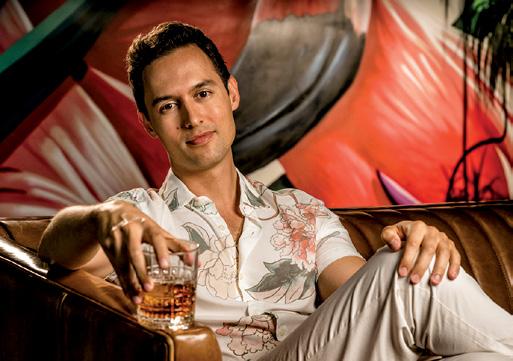
As he sampled every version in a three-mile radius of his hotel, a pattern emerged. At every bar, the bartender pulled out a plastic bottle full of murky liquid and tree bark and said the same thing: “This is my family’s recipe. This is the best mamajuana on the island.” Russo quickly discovered that most of them were wrong. Most samples reminded him more of pumpkin-scented hand sanitizer than rum. However, the truly “best mamajuanas” stuck in his mind.
After leaving the Dominican Republic, Russo tried to find where he could buy mamajuana commercially. He couldn’t, because it didn’t exist. “I had kind of an ‘aha’ moment, this eureka moment. I said, ‘Why don’t I make it? Why don’t I create the first brand that makes this type of rum that millions of people are drinking every single year, but nobody’s actually commercialized before?’” says Russo, the founder and CEO of Miami-based Candela Mamajuana.
Candela Mamajuana was officially born in 2016. The company started selling in the U.S. in 2018 and in the Dominican Republic in 2019. Now, Candela Mamajuana supplies Hard Rock Hotel & Resort, Hilton Hotels, Hyatt, and other major hotel groups in the Dominican Republic, and is carried by Publix, ABC Fine Wine & Spirits, and Total Wine in the U.S.

“2019 was a major inflection point in our brand’s history because once we started selling in the Dominican Republic, [there were] tens of thousands of Americans that were trying our product every single week. Then, they would come back to the U.S. and Google our product,” says Russo. “On any given month, we’re getting between 50,000 to 100,000 Google searches in the U.S. for our product.”
Candela Mamajuana’s popularity in the DR has only grown,
ALEJANDRO RUSSO,FOUNDER AND CEO, CANDELA MAMAJUANATOP:
MAMAJUANA AGING IN BOURBON CASKS
and in 2022, it was named “The Unofficial Drink of the Dominican Republic’’ by Fodor’s Travel. “It’s a very fun and approachable rum. It’s a rum for people that would have never thought that they like rum, or even spirits for that matter,” says Russo. Aside from being the only premium mamajuana on the market, Russo also boasts that Candela is the most sustainable rum out there.
Candela Mamajuana first starts with premium rum distilled from fresh sugarcane juice. Then, the leftover pulp from the sugarcane is transformed into biofuel that’s used to power its Dominican distillery. Once distilled, the rum is infused with locally sourced herbs and spices and aged for at least one year in bourbon casks.
Throughout its journey from sugarcane to mamajuana, Candela’s production uses minimal electricity and relies heavily on renewable energy. The company employs natural sunlight lamps and uses “smart” building materials to keep its warehouse cool without A/C. Most water used in Candela’s production is purified rainwater.
Outside of the Dominican Republic and Florida, Candela Mamajuana can be found in New York, New Jersey, and California, or online at drinkcandela.com. l
I had kind of an ‘aha’ moment, this eureka moment. I said, ‘Why don’t I make it?'


To be at the forefront takes vision and sometimes guts. However, the reward is worth the risk. At Pacific National Bank, we believe in those always striving to break the mold. It’s part of your DNA to be a leader. We admire you for doing things differently. We’ve been doing it for years in our own industry, creating unique solutions to fit our clients’ distinct needs. Drop by and experience banking like you never have before.

As an interior designer, Steven Burgos likes to honor the history of the spaces he crafts. So, when global architecture and design firm HOK was opening its studio in Coral Gables, he sought to pay tribute to the building’s past (previously home to the Church of Scientology) and its location (South Florida). An office meeting room now displays portraits of two icons with similar names: actor Tom Cruise, the Scientology advocate, and singer Celia Cruz, the Cuban-American performer beloved in the Miami area.
“We like to add some storytelling in our designs,” chuckles Burgos, HOK’s director of design for Florida, sitting by the Cruz portrait in the room that also features art declaring, “Welcome to Little Havana.”
For people outside design circles, HOK might not be a familiar name. But if you’ve visited South Florida’s renovated Hard Rock Stadium or Florida International University’s Frost Art Museum, then you know some of the firm’s local work. HOK is also de-
signing the new Miami-Dade County Civil Courthouse and co-designing the University of Miami’s new football operations center.
The firm has been so busy in South Florida recently that it opened its first office in the area this March, opting for Coral Gables, the leafy Miami-Dade city that’s home to the University of Miami and a cluster of top international design firms.
Founded in 1955 in St. Louis by three principals whose last names began with the letters H, O, and K, the firm first expanded to San Francisco, New York, Dallas, and Washington, D.C., before jumping overseas to Hong Kong in 1984. The HOK firm today employs some 1,600 people in 26 offices worldwide, most in the U.S. but also in London, Canada, Beijing, Shanghai, India, and the United Arab Emirates. Its project list includes a long list of large-scale works, including the Mercedes-Benz Stadium in Atlanta, BBC’s headquarters in London, and LG Science Park in Seoul, South Korea.
In Coral Gables, HOK now employs
The conversation has shifted to creating a unique experience, whether it’s for employees, guests or visitors. We’re having to be more creative.
STEVEN BURGOS, HOK DIRECTOR OF DESIGN FOR FLORIDA
about a dozen staffers. Its studio reflects the firm’s design philosophy, combining function, beauty, branding, and storytelling. The office offers airy, flexible spaces and “huddle rooms” for a team that also works from home. On a large window overlooking Giralda, there’s also a sign and a QR code to help engage more with the local community.
For design firms, doing business in South Florida has its particularities, Burgos says. For one, the market is highly competitive, with developers and companies contracting top firms to make their buildings and offices


1. MIAMI DADE CIVIL COURTHOUSE CONSTRUCTION STARTS 2023
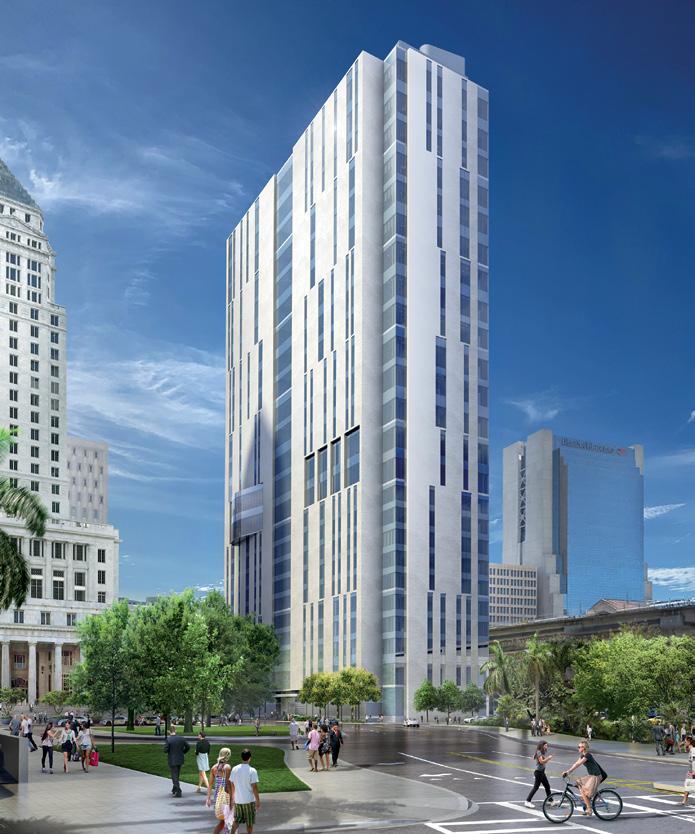
2. UNIVERSITY OF MIAMI ON-CAMPUS FOOTBALL OPERATIONS CENTER
3. BBC HQ, LONDON, 2015

4. LG SCIENCE PARK, SEOUL, 2018
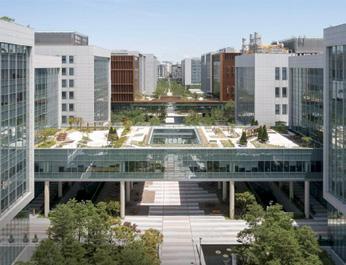
5. SAMSUNG'S R&D FACILITY, SOUTH KOREA, 2005
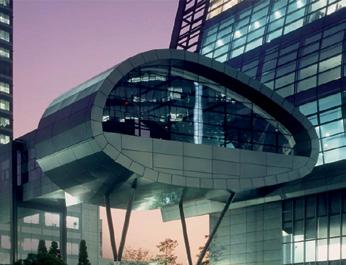
stand out. “The conversation has shifted to creating a unique experience, whether it’s for employees, guests, or visitors,” says Burgos. “We’re having to be more creative.”
The environment plays a major role too. Designers often opt for large windows to let in the abundant sunlight. Yet they also need to consider “the quality of the light,” says Burgos. In picking paint for walls, designers must look at the paint color in sunlight and not just indoor light, because with sun streaming in, “some whites will look pink or blue,” says Burgos. Also, with climate change a growing concern, professionals increasingly “design for resiliency,” sometimes elevating structures for potential storm surge and sea-level rise.

Business culture differs in Miami too, even from Tampa – where HOK has an office employing some 35 people. “In Miami-Dade, it’s more relationship driven and personal,” says Burgos, who's been in South Florida for nine years and hails from New Jersey. “Here, you meet a client and give a warm hug, a kiss on the cheek, and have a cafecito. The way of doing business or getting to know somebody is definitely driven more by what you see in Latin America.”

HOK sees opportunity for growth in South Florida, as corporations set up new offices and universities expand to serve the fast-growing market. The University of Miami is a repeat client. It chose HOK for its new football operations complex because of the firm’s “nationwide university sports-specialty experience,” says Mike Sardiñas, senior architect at the Office of the University Architect. The seven-story building “will support student athletes and the U’s goal of recruiting the best talent in the nation.”
At the football building, HOK and co-designing architecture firm Arquitectonica plan to highlight the history of UM football, partly through traditional displays of trophies and memorabilia but also with fun elements like an immersive digital experience, as well as graphics and murals. The design will also offer surprise “Easter Eggs” in different spots, says Burgos, to share the idea of UM as “Forever Home.” l
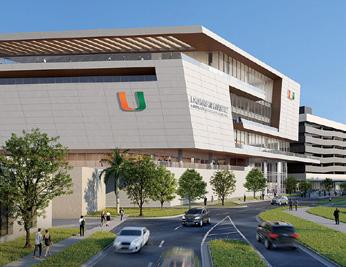

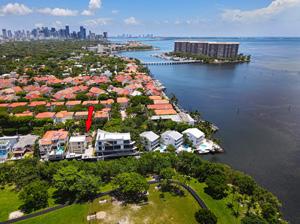


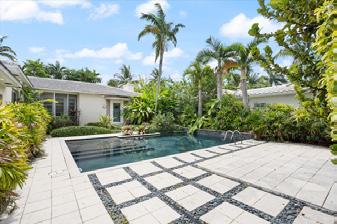


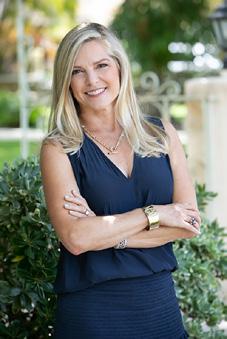

Travel guru Felix Brambilla founded the Miami-based Overseas Network (ON) back in 2000. Today, his luxury travel empire has 47 offices in 38 countries and boasts a vast web of local contacts and experts, ranging from ranchers in Montana, to ice fishing guides in Minnesota, to villa owners in Tuscany and Tulum. Recently, we paid him a visit at the firm’s North American headquarters in Miami’s suburb of Coral Gables.
Half Italian and half Scottish, Brambilla was born in the south of France, but he tells me that South Florida is the place where he now feels at home. “When you return to Miami, you’re coming back to an ongoing fiesta,” he says. Along with its Miami headquarters, Overseas Network has four other regional HQs that together encompass the globe: São Paulo serves Latin America, Cape Town is the hub for Africa, Geneva handles the European market, and Hong Kong oversees all of Asia. Another 40-plus offices worldwide are either solely owned by ON, are a partnership with an existing upscale agency, or exist as a franchise.
The company’s mission is simple: to create bespoke travel experiences for high-end clients around the world. There is no brochure – everything is a la carte – and itineraries are seldom repeated.
Brambilla explains that he and his team are not travel agents but “destination specialists.” Much of a travel agent’s job ends at baggage claim, whereas Overseas Network’s task is to plan and oversee everything. “We take full responsibility for the trip,” says Brambilla. “So, we go from design all the way to delivery and support at the destination.”
Overseas Network targets the rarified upper echelons of the travel market. For example, by providing 24/7 concierge service in 11 languages. Brambilla explains that he can only do this for the people who can afford to pay, and that having to deal with demanding wealthy clients is just an inevitable part of the job. Before the pandemic, around 70 percent of ON’s customers were heading to Europe. But lately, the United States has become the favored destination, followed by Sub-Saharan Africa, where glamorous safaris are increasingly popular and lucrative.
Brambilla prides himself on being able to handle and execute even the toughest assignments. One of his most challenging projects to date, he says, was at the 2022 World Cup soccer tournament in Qatar. At the last minute, the Qatari government reached out and asked him to organize special experiences for all of its state guests.

We take full responsibility for the trip. So, we go from design all the way to delivery and support at the destination...FELIX BRAMBILLA, FOUNDER, OVERSEAS NETWORK, PICTURED ABOVE IN THE QATAR DESERT
He and his team rapidly constructed two luxury Bedouin camps, pitched in the desert, where 150 World Cup VIPs could relax between matches. They also outfitted traditional dhows, masted ships used in the Indian Ocean, with opulent bells and whistles for cruises on the Arabian Gulf. Given the success of their mission at the World Cup, Overseas Network has recently opened a permanent office in Doha. Collaborations are expected to continue with the Qatari government, as well as with FIFA, soccer’s global governing body.
So, what was his most demanding project ever? A high-networth client of a Swiss agency wanted to create an Electronic Dance Music festival in an exotic location. ON successfully staged a five-day event in the middle of the Nicaraguan jungle. Brambilla’s most otherworldly experience, though, has been to send a client to the International Space Station (spacewalk included), an odyssey that required 14 months of pre-flight training. A more typical ON excursion, on solid ground and within the contiguous Lower 48, is
LEFT: TRAVELING UP THE RIO NEGRO RIVER IN STYLE
TOP: TAKING AFTERNOON HIGH TEA IN THE ARABIAN DESERT ABOVE: EXPLORE THE (WILD) WEST ON HORSEBACK AT YOUR OWN PACE

an extended family vacation at an authentic 19th-century town in Colorado. The charge for sole use of the town for a week extends into seven figures, but Brambilla assures me that it’s an unforgettable experience of Americana worth every cent.
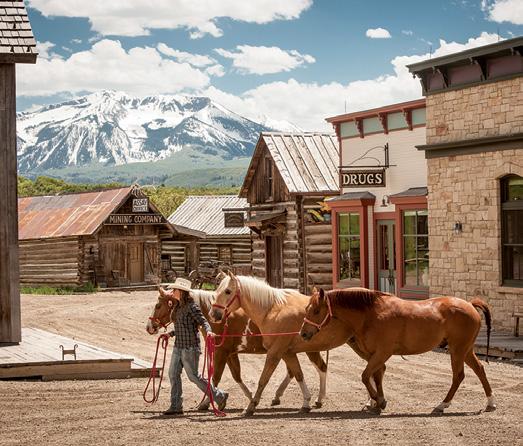
My favorite Brambilla trip would have been a voyage aboard a 15-cabin boat down the Rio Negro, one of the largest tributaries to the Amazon in Brazil. The journey included a two-star Michelin chef and a mixologist flown in from Italy, and each guest cabin came with its own speedboat and private guide.
So where does Brambilla see the next travel hot spot? Saudi Arabia, he says, as the country is investing massively in a concerted attempt to show a friendlier face to the world. As for Brambilla himself, he intends on taking things a bit more slowly in the future. Under pressure from his wife, who insists that he has a family as well as a career, he says he’s decided to reduce his annual travel days from 250 to a mere 115. Just a third of the year on the road… such is the price of domestic happiness. l

Despite economic tumult, Latin America’s middle class currently represents about 33 percent of the region’s total population of more than 655 million people, according to the World Bank. But whereas wealthy Latin Americans have always been able to invest overseas to avoid losing the value of their savings to inflation, devaluation, and confiscatory taxes, safe overseas investments have not been readily available to a huge portion of the region’s middle-income families.
BCP Global is working to change that. The Miami-based firm has combined financial expertise, easy-to-use technology, and international partnerships to provide U.S. investment options to millions of middle class Latin Americans, from Mexico to Chile, via an all-in-one app. “We spent years gaining an understanding of the laws, regulations, and overall confusion preventing middle class Latin Americans from finding financial freedom,” says Mauricio Armando, CEO and co-founder of BCP Global. “This is a massively under-addressed market.”
Armando established BCP Global in 2017 with two partners, Santiago Maggi, BCP’s COO, and BCP board member Pedro Fernandez de los Muros, both with years of experience in international finance. The idea was to partner with major financial service providers and offer those services to clients via its mobile app.
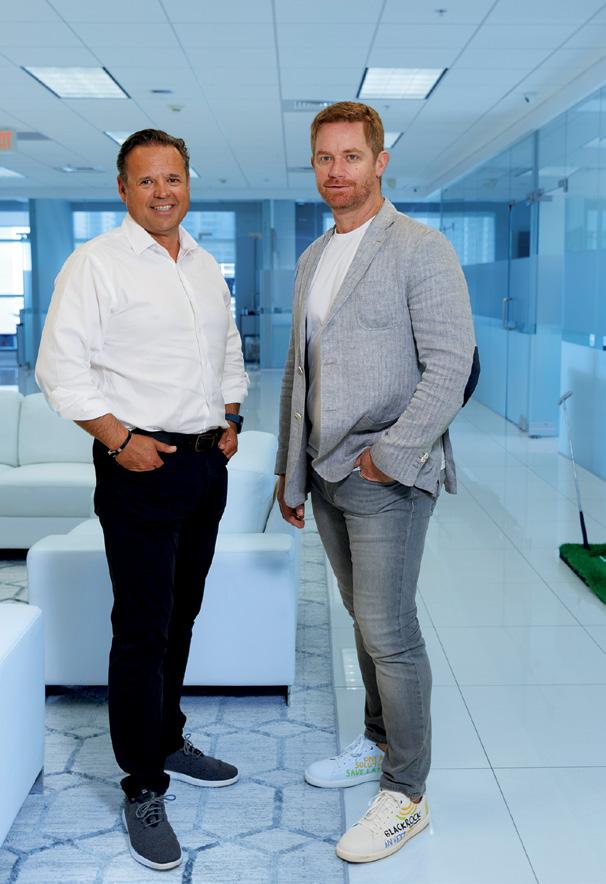
BCP (which stands for Blue Capital Partners) partnered with BlackRock, the world’s largest asset manager, to offer investment portfolios; it partnered with Interactive Brokers LLC (IBKR), a U.S.-based securities trading firm that operates on 150 global markets, to carry out trades for its clients; and it partnered with Olé, a continent-wide insurance company, to offer life insurance policies.
This is how BCP works: The ONE APP software the company developed is sold to banks and other financial firms in Latin America, who then offer BCP services to their customers. These customers apply for an account with BCP, download the app, and wire funds to open an account. Each client then receives instructions on how to choose a personally tailored investment portfolio from BlackRock’s huge selection of options; how to buy or sell their own stocks or funds via a simple trading solution; and how to invest in short-term U.S. Treasury Bills. BCP clients can also purchase life insurance through their partner, the Olé group, which can issue a U.S. issue term policy for up to $1 million in less than 48 hours without a medical exam. The client can also receive investment insights from BCP Advisors, with information on investment instruments, risk, volatility, and planning.
“Millions of Latin Americans do not have access to the financial products that American consumers can take advantage of, such as brokerage accounts and IRAs,” says Armando. Most regional financial institutions in Latin America are not equipped with the technology or the knowledge of compliance rules to be able to effectively provide these products to customers, he says. “BCP Global
simplifies everything.”
BCP’s B2B partners who offer their services to clients include independent financial advisors, mid-size broker-dealers, and registered investment advisers (RIAs), some of them the largest financial institutions in Latin America. For example, in Colombia, BCP works with Davivienda, Alianza Fiduciaria, and Credicorp. In Mexico, their partners are Monex, GBM, and Banorte. In Brazil, they are signed with Banco Bradesco S.A., Brazil’s second-largest bank and a shareholder in BCP.
“We think it is not only important but crucial for families in these countries to invest some of their savings in U.S. dollars, here in the U.S.,” says Armando. “Financial literacy is also a must. We want our clients to understand how and why they invest with us and compare that with other offerings.” At the end of 2022, BCP had assets of more than $168 million under management. l
Millions of Latin Americans do not have access to the financial products that American consumers can take advantage of, such as brokerage accounts and IRAs...MAURICIO ARMANDO, CEO AND CO-FOUNDER OF BCP GLOBAL (ABOVE RIGHT, WITH PARTNER SANTIAGO MAGGI) Photo by Rodolfo Benitez
Our personal injury law firm has obtained in excess of a billion dollars in verdicts and recoveries for clients and is recognized as a leader in plaintiffs’ personal injury and wrongful death, class actions, mass torts, and other areas of litigation

Colson Hicks Eidson, one of Miami’s oldest and most accomplished law firms, is considered among the top trial firms in the United States, having won hundreds of multi-million dollar verdicts and settlements for its clients.


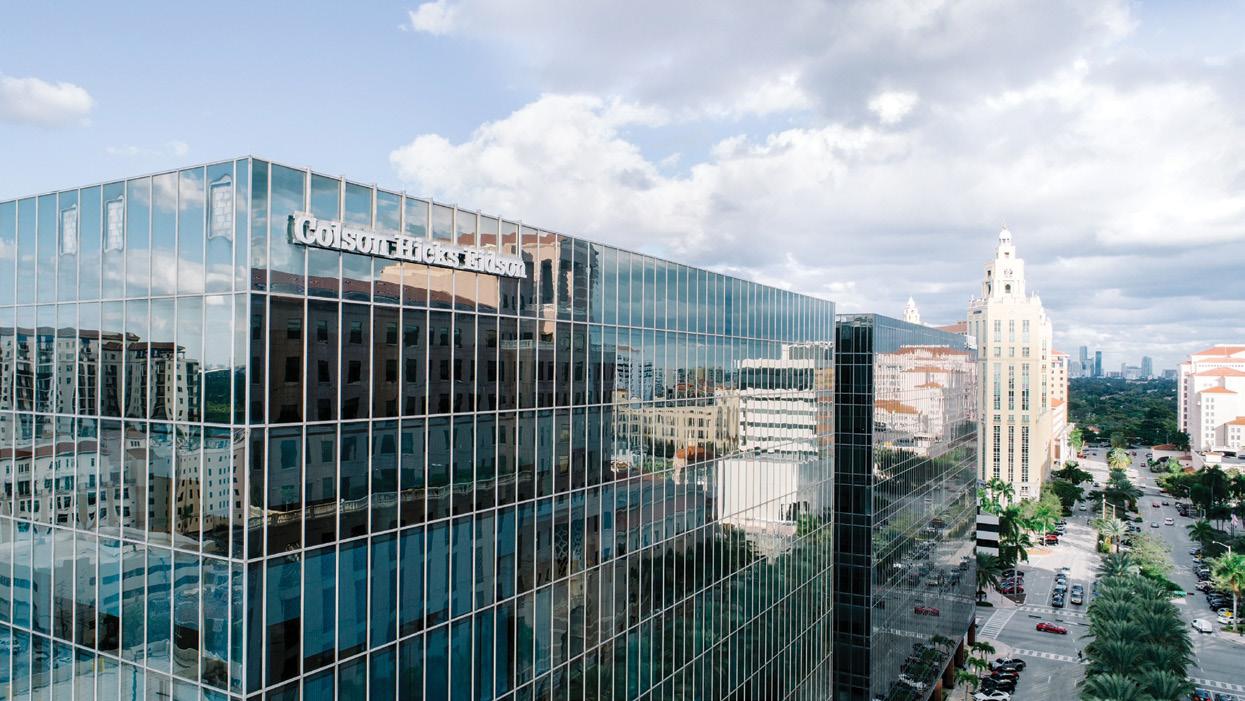
Our personal injury lawyers have a long history of serving individuals, groups of individuals and businesses in a wide range of lawsuits. Our trial attorneys are highly regarded for their depth of legal experience, responsiveness to client concerns and ethical tactics, both inside and outside of the courtroom. Our law firm receives respect throughout the legal community, which recognizes Colson Hicks Eidson for its various distinguished achievements.
We are or have been actively engaged in the following and many other cases:
• Takata Airbags MDL
• Champlain Plaza
• Allergan Biocell MDL
• Monat Marketing MDL
• Parkland Shootings
• Elmiron Eye Injury MDL
• 3M Combat Earplugs MDL
• BP Deepwater Horizon Oil Spill
• Ford Firestone MDL
• Toyota Sudden Acceleration MDL
• Zantac MDL
• Camp LeJeune Contamination Claims
Few industry sectors were as hard hit by the pandemic as global tourism, taking a deep dive in 2020. According to market research firm Statista, 2019’s record $2.201 trillion in tourist spending fell to $1.3 billion in 2020.
The good news is that this year, global tourism is predicted to exceed pre-pandemic levels and reach $2.285 trillion. Leading that recovery are international travelers to and from North America. According to the International Air Transport Association (IATA), which tracks airline passenger loads, North American carriers have already recovered their international passenger traffic; as of May, revenue from international travelers to and from North America was 17 percent above pre-pandemic levels.
This rise was not lost on the UK-based Gray Dawes Group, which, in April, acquired Miami’s largest travel agency in a bid to expand its North American footprint. Following a Gray Dawes acquisition of an Australian travel company in January, the latest buy completes the firm’s “Always On” strategy, wherein a travel firm staffer is available 24 hours a day.
The firm acquired – Express Travel – is not only Florida’s largest travel agency, but also one of the largest Hispanic-owned companies in the U.S. and among the biggest women-owned businesses in the state. With 30 employees, last year Express Travel billed $33 million.
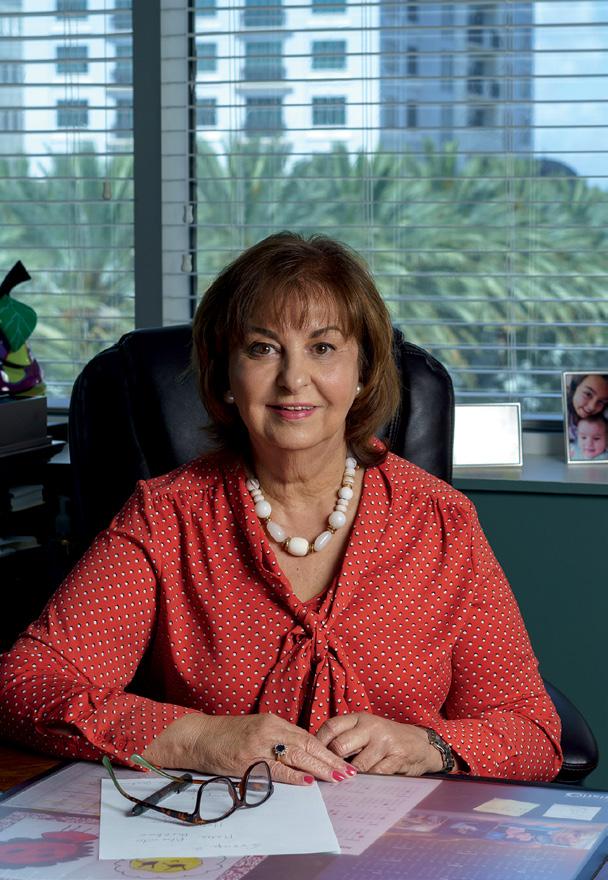
“They want to enter the U.S. market, so they are doing it through us,” says Express Travel CEO Olga Ramudo. “We will be their U.S. headquarters” – as well as a gateway to the Latin American market.
“Our focus is on driving our global operations and implementing our ‘Always On’ service delivery,” says Suzanne Horner, Gray Dawes Group’s chief executive. “That means aligning our UK, USA and Australia bases and implementing a shared technology platform across the entire operation. We want to be there for our clients, when and where they need us.”
Last year, the travel division of Gray Dawes billed $327 million, a figure that is expected to reach more than $450 million this year with its new acquisitions and the explosion in post-pandemic travel demand.
Horner says that their choice of Express Travel for expansion to the U.S. was based as much on shared corporate values as it was on location and numbers. “Primarily it’s about the company, not the location – though Miami does afford us some fantastic opportunities to develop the Latin American market,” says Horner. “I have long admired the business that Olga Ramudo, Cristina Jacomino [Ramudo’s sister and partner] and their team have built.”
That sentiment was equally important for Express Travel. “What’s great about [Gray Dawes] and why we are so happy about this company is that they are family-owned, the same family for 100 years,” says Ramudo. “They are also women-led, something close and dear to my heart, and they are based on relationships and
service. So, they are basically what we are all about.”
While the advent of the internet has obviated many of the services provided by traditional travel agencies, companies such as Travel Express have still performed well by serving the corporate market (more than 70 percent of their business), providing corporate compliance, contracting, and negotiations with airlines, hotels, and car companies, etc. “We can get better deals according to the volume we do,” notes Ramudo. For Express and Ramudo – now Gray Dawe's senior VP for Florida and Latin America, with sister Jacomino taking on the role of luxury travel director – the difference is the new reach and additional resources that Gray Dawes brings. “This is exciting for us, because now we are a global company,” says Ramudo. l
What’s great about Gray Dawes and why we are so happy about this company is that they are family-owned, the same family for 100 years. They are also women-led, something close and dear to my heart ...OLGA RAMUDO, FORMER CEO OF EXPRESS TRAVEL, FLORIDA’S LARGEST TRAVEL AGENCY, AND CURRENT SVP FOR FLORIDA AND LATIN AMERICA AT GRAY DAWES
Journey to Zambia with the Tony Robbins Platinum Partner
I am Giovanna Guzman, the CEO and Broker of International Realty Group, and I am thrilled to share with you a glimpse of our life-changing trip to Zambia, accompanied by the Tony Robbins Platinum Partner. It was an incredible adventure filled with remarkable experiences, and one that left an indelible mark on my heart.
As a real estate professional, my passion extends beyond the world of business. I believe in the power of giving back and making a positive impact in the lives of others. That is why the Contribution Day during our trip to Zambia was so meaningful to me. Witnessing the impact of our mission firsthand was truly awe-inspiring. We were able to provide over 250 beautiful soccer jerseys and more than 30 soccer balls to the children of Mukuni Village & Primary School, igniting an undeniable spark of joy and excitement in their eyes. It served as a powerful reminder of the transformative power we hold in our hands.
But our mission doesn’t stop there. We are committed to making an even greater impact, and for that, we need your support. Your generous donations can help us continue our work in Zambia and beyond, empowering these children with the clothing, coaching, and care they need to thrive. By contributing, you become an integral part of the Unbreakable Threads family, directly changing the lives of these incredible children.
I invite you to visit our website at TheUnbreakables.com and make a donation today. Every dollar counts and brings us closer to realizing our vision of a world where all children have the opportunity to live successful and fulfilling lives. Join me on this incredible journey, and let’s create an unbreakable bond of support and love for these remarkable children.

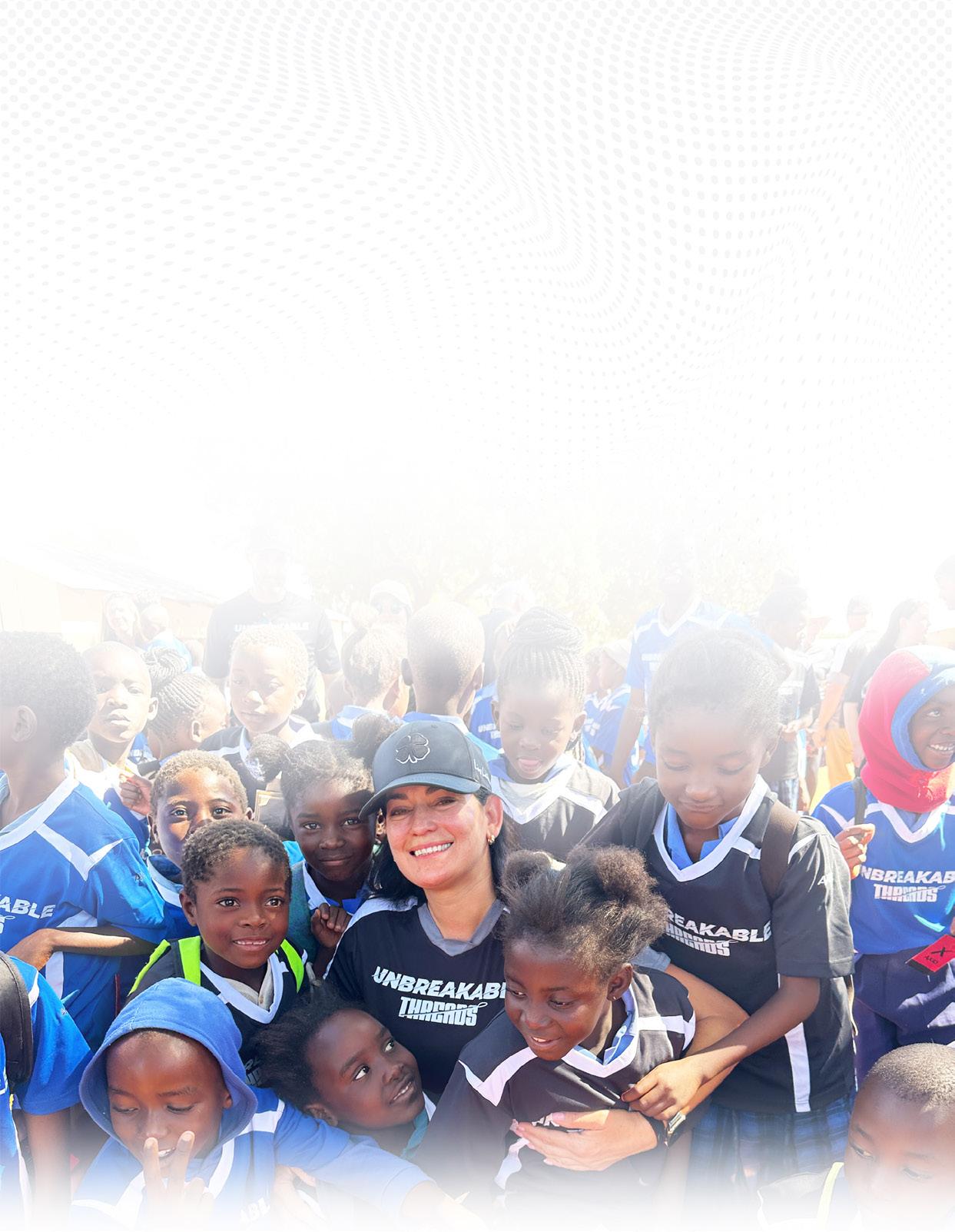
I want to express my deepest gratitude for your compassion, generosity, and for being a part of our mission. Together, we are truly making a difference that will resonate in their lives and beyond.
Giovanna Guzman CEO and Broker, International Realty Group Co-founder, Unbreakable ThreadsWhen the COVID-19 pandemic broke out, much of the world began working from home in what appeared to be a temporary solution. Fast-forward three years later: 16 percent of companies are still fully remote, and 40 percent allow a hybrid structure. Following this paradigm shift, where companies have become comfortable using remote workers, Pierce Brehm saw an opportunity.
Brehm is the CEO and founder of Magellan AI, an AI-powered marketplace for HR tech and service solutions. What Magellan AI does is help domestic companies locate overseas talent they can remotely employ.
Brehm initially began his career working for HR tech giant ADP. After ten years there, he used his HR experience to launch consulting firm Hollyn Growth Advisors in April 2021. Hollyn’s mission was to pair domestic firms that wanted to expand into new global markets with foreign technology vendors that could help facilitate that growth.
Looking to become more scalable, Brehm turned to technology to expand the business. He created an AI-powered platform to act as a sort of matchmaker for
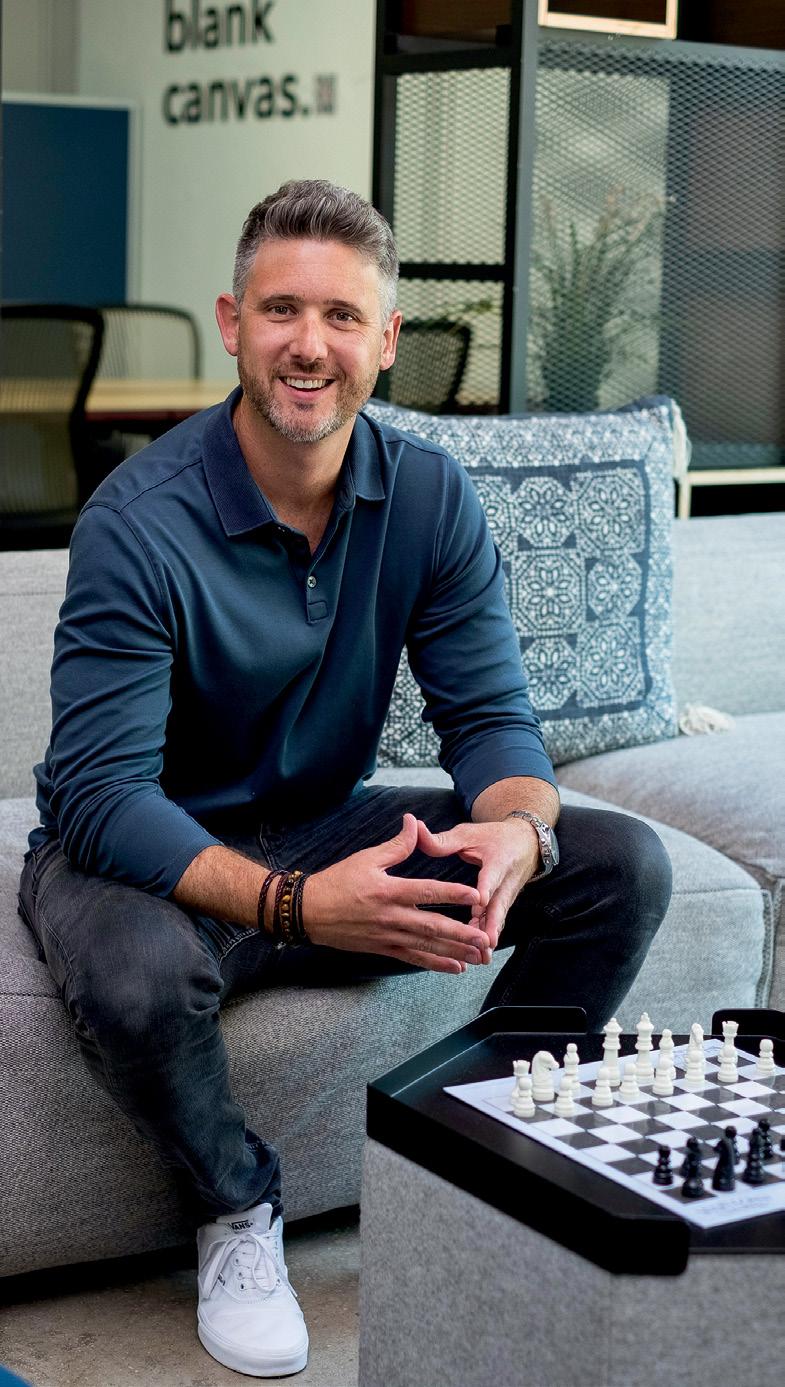
companies and overseas tech providers, and voila — Magellan AI was born in March of this year, servicing 185 countries with four employees based in Miami, one in Atlanta, and one in Nebraska.
Listo Global, an international HR tech provider based in Utah, partnered with Magellan AI earlier this year. “Magellan AI is providing a tool where companies, regardless of their size or resources, can find and connect with the right vendors to help them navigate their global expansion journey,” says Freddie Ashby, CEO and co-founder of Listo Global. “It’s a real game-changer for businesses, eliminating the painstaking process of manually finding and vetting vendors.”
Magellan AI takes Brehm’s Hollyn model beyond just pairing domestic firms with overseas vendors, however. It drills down to potential employees who can work remotely – as in thousands of miles remotely. Through their AI platform, the company captures data about the staffing needs of the client, such as the type of role, the required availability and country, and the necessary skills. With this information, Magellan AI helps find the best employees for a client’s unique scenario, while at the same time educating them on the risks, benefits, and strategies of global hiring.
Brehm lists several reasons why you might want to hire talent overseas. For one, you get to widen the talent pool. Secondly, you have access to potentially lower-cost talent. And, of course, diversity of thought; as companies look to diversify and expand, having a global perspective becomes more valuable. “But there’s a lot of risks involved. For instance, if you misclassify one of your employees as a contractor versus an employee, in certain countries that’s not a big deal. But in some countries, it is,” says Brehm. In Germany, if a company is found guilty of misclassifying an employee, it may be fined up to $500,000. In France, those found guilty can actually be sentenced to jail time.
Magellan AI’s services are available on a
subscription or fee basis. For $499 annually, clients become premium subscribers and have access to the vendors that Magellan Ai partners with. For a pre-negotiated fee, clients also have access to a broader HR technology marketplace that includes all HR tech solutions. Magellan's platform provides information resources, like country insights, for free.
“We’re adding a talent portal, which I’m really excited about and super proud of,” says Brehm. “Essentially, just like we play matchmaker between companies and technology vendors to help them realize their global expansion goals, we’re also doing the same thing with talent in emerging markets.”
The company is now partnering with higher-education institutions in Africa and Latin America to create a connection between people in those regions looking for jobs and companies looking for remote talent. The institutions are essentially training workers in these continents to take on tech roles. “A lot of these individuals have largely been eliminated, dismissed, or just totally ignored in the global economic conversation. By way of these partnerships, we’re taking all the graduates of their programs and putting them into a talent database,” says Brehm. “Our clients will now be able to go into our talent portal, create a job requisition, and then be matched using AI technology to the bestfit candidate in Kenya, Nigeria, Argentina, or even Chile that has been upskilled and is now ready to enter the global workforce.”
The portal is expected to launch by the end of August, with more than 10,000 candidates in their database. “And we have a goal in the next five years to create 100,000 jobs in these emerging markets,” says the CEO. Magellan AI will charge a placement fee for any hires made on the platform; half of that placement fee will go back to the institution that trained the individual to foster more talent for its clients to dip into. Premium subscribers will have access to the full talent database, from entry to senior level, while free users will only have access to entry-level candidates.
Says Brehm, “The fact that we have more of a social mission to what we’re doing – in addition to trying to be more inclusive of talent in emerging markets that haven’t had that access – I think is something that makes us makes us unique.” l
Essentially, just like we play matchmaker between companies and technology vendors to help them realize their global expansion goals, we’re also doing the same thing with talent in emerging markets.
Our clients will now be able to go into our talent portal, create a job requisition, and then be matched using AI technology...PIERCE BREHM, CEO AND FOUNDER OF MAGELLAN AI, AN AI-POWERED MARKETPLACE FOR HR TECH AND SERVICE SOLUTIONS. PIERCE BREHM, ON AN UPSKILLED CANDIDATE THAT IS NOW READY TO ENTER THE GLOBAL WORKFORCE.
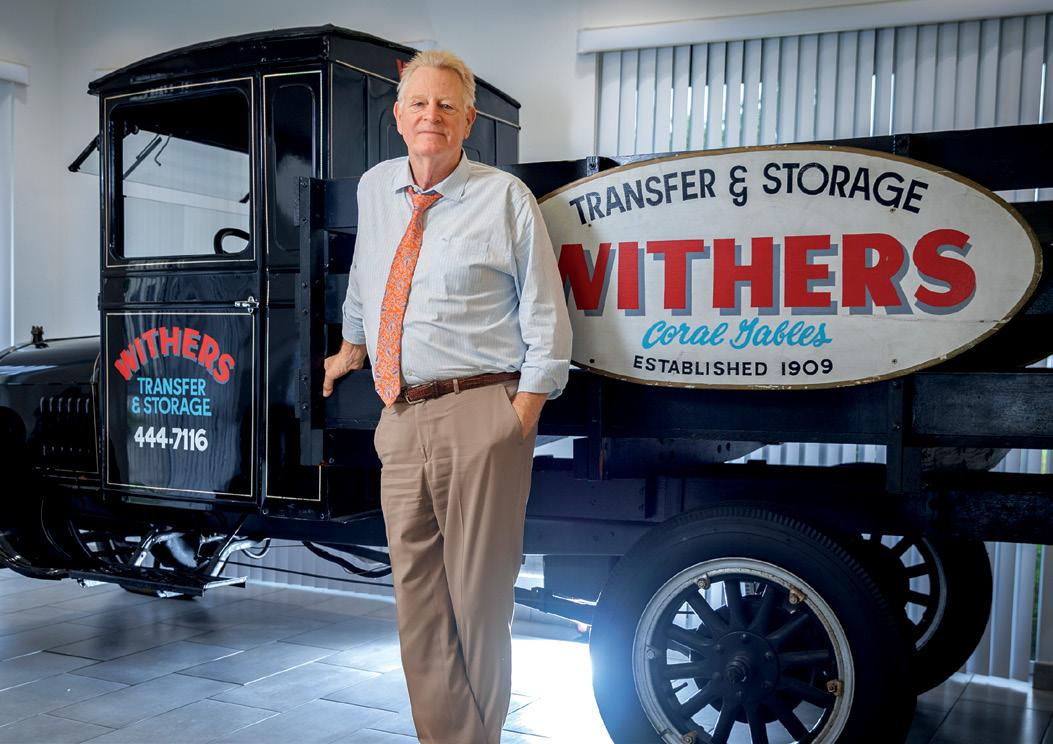
In 1909, the Withers family immigrated from Minnesota to South Florida to try their hand at farming potatoes in a warmer climate. The problem? Their wooden plows couldn’t handle the rocky terrain. So, they decided to head back to Minnesota.
At the train station where they were looking to sell their horse and dray (a large wagon used for heavy deliveries), they met employees of the Flagler Group, who hired the family on the spot to help move their trunks from the station to their hotel (the Royal Palm Hotel, where the Kimpton EPIC now stands on the Miami River). This was the humble beginning of Withers Worldwide – today a global leader in transportation solutions for the hospitality industry.
Chip Withers, a SVP of Withers Transportation Systems and the greatgrandson of Johnny Withers (he of the orig-
BY KYLIE WANGinal horse and dray), entered the business in the mid-1970s, back when it was mostly focused on dry goods and warehousing. But with the federal government deregulating the airline and trucking industries, and other transportation firms moving into the market, Withers knew the company had to make changes if it was going to thrive, let alone survive. The decision was to specialize.
“It was really quite a transition for us,” says Withers. “We went all in in the early ‘80s, into hospitality… from only warehousing to domestic and international freight, warehousing, and setup.” This became the company’s “three-legged stool,” encompassing transportation, storage, and installation, principally for hotels. Withers Worldwide might move just one product to three or four different locations across the globe for manufacturing and assem-
It was really quite a transition for us. We went all in in the early ‘80s, into hospitality… from only warehousing to domestic and international freight, warehousing, and setup.
bly before installing it. “We’ve moved raw fabric from Korea to France to be dyed and printed, then to the United States to be flame-coated, and then back to a factory in China or Vietnam to be made into a piece of furniture,” Withers says. “Then we move that piece of furniture into the lobby of the Kapalua Ritz-Carlton [in Hawaii].” Today, the company’s clients include prominent hotel chains like Hilton and Marriott, with locations from Seoul, Korea to Copenhagen, Denmark. “If you were to take a hotel and turn it on its end, everything that fell out of it is basically what we handle,” Withers says. This broad, beginning-to-end approach forced the company to focus on details. “Some of these hotels can have 20,000 line items, when you look at everything from the demitasse spoons to the throw rugs in the bathroom,” Withers says. That’s not even considering some more specific handcrafted items, which are often “shipped” using non-traditional methods – like horses, which have been part of the Withers Worldwide experience since 1909, you’ll remember. Or perishables, which often require some sort of refrigerated storage. “We’ve flown fish from the Pacific Rim into Atlantis in the Bahamas. We’ve moved sea
lions. We’ve moved truckloads full of carpet. We do the maître d’ stands, the uniforms that people wear, the ladders that the maintenance guy uses to change a light bulb,” says Withers.
The company currently employs about 50 people, including a wide range of third-party contract employees, and moves around $300 million to $600 million worth of products in a year. It doesn’t own its own warehouses, vessels, trucks, or airplanes, but simply rents or hires them. “Instead of tying the money up in hard assets like that, it was easier to use it for operating capital and to build on the IT side,” Withers explains –which is how the firm developed Withers Management Solutions service, a set of protocols and software that optimize savings and maximize time efficiency. Its cross-platform tracking system compiles data in real-time to allow clients to make changes quickly and on-the-go, tracking purchase orders that can span hundreds of items, not all of which are shipped together at once. Getting those hundreds of specific items into the correct hotel suites is yet another complication. “We know the industry. We know that if a fabric isn’t shipped in time to be made into a chair 20 weeks before






We’ve flown fish from the Pacific Rim into Atlantis in the Bahamas. We’ve moved sea lions. We’ve moved truckloads full of carpet...
 CHIP WITHERS
CHIP WITHERS
the hotel opens, it can affect room sales when they’re ready to open,” the company president says.
So, what’s next? With nine out of 10 of the company’s customers being either return clients or new ones brought on by personal references, all that really matters to Withers Worldwide is quality. “We’ve always felt that if we could just keep our heads forward and do the best that we can, we can enjoy an eight to 10 percent [annual] growth,” Withers says. “And that’s pretty much where we’ve been over the last 40 years. It’s keeping our current clients happy and taking on the clients that we’re looking forward to working with. Our main competitor is ourselves." l

It’s no secret that South Florida has become one of the hottest new entrepreneurial epicenters in the U.S. The reasons why have been expounded by numerous organizations and publications, including this one. But where these immigrant techies are coming from, and for what reasons, is a different story.
Endeavor Miami, the local affiliate of global nonprofit Endeavor, recently conducted a study on entrepreneurial migration to South Florida to drill down on these questions. Endeavor, which began operations in Chile and Argentina in 1998, is now based in New York with offices in dozens of nations in Africa, Asia, Latin America, the Middle East, Canada, and the U.S. Its mission: to build entrepreneurial ecosystems in emerging markets – and to understand what makes them grow.
“Local and global media have highlighted the phenomenon of this entrepreneurial migration [to Miami], yet its underlying
reasons and its impact on the region have not been adequately investigated,” said Endeavor Miami CEO Claudia Duran in the report’s introduction. “For this reason, we thought it would be important to conduct this research and share the data and findings.”
The report identifies four types of migration to South Florida: domestic migration, the most common type, where U.S.-based entrepreneurs move their companies here; CEO migration, where a startup CEO moves while operating their company remotely; foreign founders, where a non-American moves here from outside the U.S. to start their business; and international expansion, where an individual based abroad moves to South Florida to expand their company’s operations in the U.S.
Much of this migration is credited to the emerging tech industry in Miami, where, Endeavor posits, over 17,000 tech jobs have landed in the last five years. In 2022 alone,
5,166 tech jobs were added. The majority of the companies creating these jobs, as mapped in the study, were in some sort of tech field, with software and IT at the top (28%), closely followed by fintech (22%).
Having identified 300 firms and surveyed 50 migrant entrepreneurs, Endeavor found that South Florida migrants were overwhelmingly male (88%) with over 15 years of work experience. Most came from the U.S. (31%), followed by Mexico (8%), Argentina (8%), and Venezuela (6%). Additionally, the average age (at company founding) of these South Florida migrants was 34 years, which is older than the average age in entrepreneurial ecosystems around the world.
Both personal and business reasons were considered driving factors in these migrants’ moves, with a slightly higher number choosing personal reasons (76%) over business reasons (71%). One huge business

AN ENDEAVOR MIAMI STUDY DISCOVERS WHAT KIND OF ENTREPRENEURS ARE COMING TO MIAMI – AND FROM WHERE
advantage was South Florida’s access to global markets, specifically those of Latin America. However, respondents also cited access to early-stage venture capital (63%), a new community (78%), and a network of entrepreneurs (66%) as benefits. South Florida’s lower taxes and regulation were also highly valued, more so by Americans than foreigners; but the relative safeness of the city – which has lower crime rates than other tech hubs in the U.S. and LatAm –was valued higher by non-Americans.
Major obstacles were also included, with the cost of living cited as a major challenge for 41 percent of respondents –
only four percent of those surveyed own their own offices. Another issue cited was the lack of local tech talent. Though many universities in South Florida are taking up initiatives to bring more STEM talent into the workforce, this is a slow process. Thirty-one percent of the surveyed entrepreneurs identified this as a major obstacle. Still, the biggest issue was for non-Americans who face challenges when immigrating: 68 percent of foreigners said that getting visas was one of their biggest hurdles.
As a result, Endeavor Miami recommends a three-pronged approach: 1) increase connectivity between players within the South Florida entrepreneurial ecosystem; 2) invest in talent on all levels, ensuring sufficient funding for education and making it easier for international talent to immigrate; and 3) ensure representation by supporting founders and talent from underrepresented backgrounds.
“At Endeavor, we are already feeling the positive change in the local entrepreneurial ecosystem, where there is a larger concentration of venture capital funds, startups, tech talent, and multinationals than ever before,” says Duran. “We could not be more excited to continue supporting founders in building their companies, and create a thriving community that continues to grow and attract successful entrepreneurs from around the world.” l

Local and global media have highlighted the phenomenon of this entrepreneurial migration to Miami, yet its underlying reasons and its impact on the region have not been adequately investigated...
CLAUDIA DURAN, CEO OF ENDEAVOR MIAMI
On a Tuesday morning in June, a cargo truck pulls up to the entry gate of PortMiami’s cargo yards. A few years ago, the driver would have had to submit a sheaf of paperwork, after which he would park and wait for his container to be located. Today, his RFID tag is scanned electronically, and he is directed to the cargo's location where a crane will already have unloaded the container. In a matter of minutes, his truck is laden with its cargo, and he is on his way to his destination.
When it comes to the business of loading and unloading vessels in any seaport, time is of the essence. The longer a ship spends dockside, the more it costs. So, any equipment – any technology – that can speed things along is vital. At PortMiami, that idea has been embraced.
“Technology is a significant part of all the infrastructure that goes into the port, and there’s a good amount of funding that goes towards that,” says Hydi Webb, director and CEO of PortMiami.
“It’s extremely important because the faster we can move product on and off the port, the more efficient we are… whether it’s cargo containers or cruise passengers. The goal is to move them as efficiently and as quickly as possible.”
In the past several years, PortMiami has dramatically upped its high-tech ante, employing state-of-the-art devices and software to accelerate the movement of people and products.
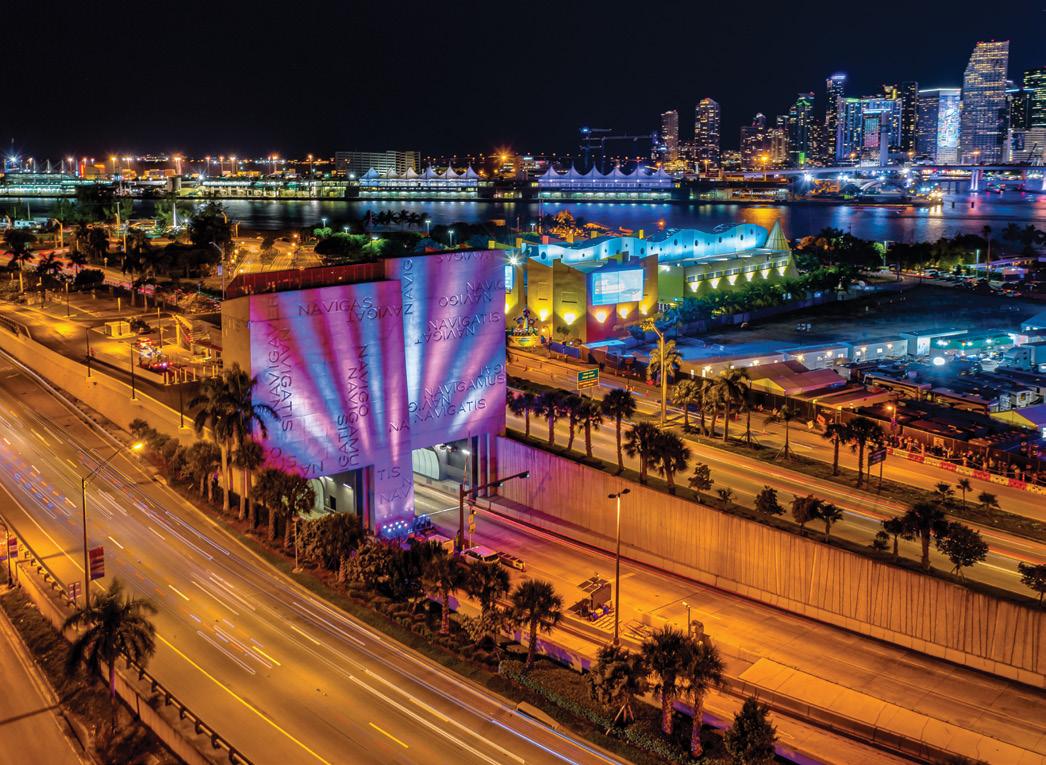
On the cargo side, the port is now reaping the rewards of its RFID tag system, with almost 5,000 smart RFID (Radio Frequency Identification) tags distributed to trucks that deliver containers to, and remove containers from, dockside.
“We are really at the point where we will start getting great use out of [RFID],” says Deputy Port Director and CFO Andy Hecker. “The reader can tell you what truck, who's driving it, the license plate – all that kind of information. Then you can assign the container to that truck. We plan to extend this to the tunnel. The system has the capability to dermine that truck ‘1234’ is here to pick up container ‘ABCD.’” As the system becomes more intelligent, it will be able to direct crane operators in real time to pluck a container from its location to the point of the vehicle’s arrival.
The result so far? “Typically, most ports can unload 25 boxes [containers] in an hour. We run in the high 30s,” says Hecker. That number is critically important when you consider that a given ship
THE HIGH-TECH PORT:

RFID TAGS FOR CONTAINER TRUCKS
POWER HOOKUPS FOR CRUISE SHIPS
ELECTRIC GANTRY CRANES
FACIAL RECOGNITION TECHNOLOGY
INFRARED & CARBON SENSORS
OPERATIONS SOFTWARE
may carry between 5,000 and 15,000 containers.
Even the gantry cranes that place and remove the containers have high-tech elements. At PortMiami, they use the SPYDER software system, which employs sensors to monitor things like location and operating temperatures. “The system constantly measures the performance of all the cranes to keep them maintained and running,” says Hecker. The cranes themselves are now also electrically powered, rather than diesel driven, to reduce emissions at the port. This meets another goal of the port’s new technologies: sustainability.
“It’s all about saving time in a sustainable manner,” says Webb. “The RFID, for example, really speeds up the processing of the trucks, which saves the idling time sitting here on the port, which saves time being processed through the yard, so emissions are being reduced.” This falls in line with the priorities of Miami-Dade County Mayor Daniella Levine Cava, whose goal is to reduce county carbon emissions by 30 percent by 2050.
Another initiative to accelerate sustainability and resiliency is shore power. Mayor Cava has signed an MOU with the port’s six leading cruise lines as well as FPL to initiate a system where the ships use power from electric hookups rather than burning fuel to run their onboard generators. FPL is building the infrastructure – an expanded substation at the port – while the cruise lines are outfitting their vessels to accommodate the hookup. By year’s end, the port will have plugins at four
terminals, with a fifth – at the new MSC terminal – ready next year.
“Right now, when the cruise ships come in, they’re burning their generators right on the ship. So, this is literally like plugging in, where they’re going to connect to our electrical grid. A cruise ship is like a floating city, so you’re plugging in that floating city – three of them at one time – into our electric grid,” says Webb. “It’s a really big win for the entire community.” The port also has the ability to service vessels powered by LNG (Liquified Natural Gas), which reduces emissions; Carnival on the cruise side and Seaboard Marine on the cargo side already have vessels that use LNG.
Another high-tech initiative on the cruise line side is facial recognition equipment, implemented in conjunction with U.S. Customs and Border Protection. When passengers disembark after a voyage, they are technically coming from outside the country, so “they need to be processed,” says Webb, “and this cuts down time.” A passenger vessel with 6,000 passengers can now be unloaded in the same time it used to take with a 3,000 passenger vessel. The new cruise terminals being built at the port are also required to be LEED certified, which means
Technology is a significant part of all the infrastructure that goes into the port, and there’s a good amount of funding that goes towards that...HYDI WEBB (ABOVE),
DIRECTOROF PORTMIAMI Photo by Rodolfo Benitez
The reader can tell you what truck, whose driving it, the license plate – all of that kind of information. Then you can assign the container to that truck. You come out of the tunnel, it reads that truck ‘1234’ is here to pick up container ‘ABCD.
ANDY HECKER, DIRECTOR ANDthey are built to save energy.
Perhaps no other infrastructure advance at PortMiami can, however, match the scope, size, and impact of the Port of Miami Tunnel, a $1 billion project completed in 2014. That tunnel, which was bored under Biscayne Bay, allows trucks to bypass the (then) snarling traffic in Downtown Miami by travelling directly from the MacArthur Causeway to the port.
The tunnel is actually split into two roads, going to and from the port, which are connected by a series of passageways should one need to be evacuated. “We dug separate escape routes into the other tunnel,” says Chris Hodgkins, chairman of the board of Miami Tunnel, which operates the facility for the Florida Department of Transportation. “We have vibration sensors, carbon sensors, infrared sensors, [and] more than 100 cameras that keep our eye on everything that happens in the tunnel.” Should there be a breakdown, the tunnel authority’s vehicles – including a huge Peterbilt capable of pulling an 18 wheeler –can clear the tunnel in short order. Miami Tunnel is, in fact, contracted
to clear any vehicle within 25 minutes, or face huge fines. “We are paid to keep that tunnel open,” says Hodgkins.
The tunnel is also designed to deal with the worst two disasters it might face: fire and flooding. Should a fire break out, it has a closed water extinguishing system, along with 44 fans the size of jet engines that can clear the smoke. “We don’t have a sprinkler system, we have a deluge system, where the water comes down so intensely that it suffocates the fire,” says Hodgkins. The water drains into a cistern and then gets pumped back into containers above the tunnel, sealed from the Bay.
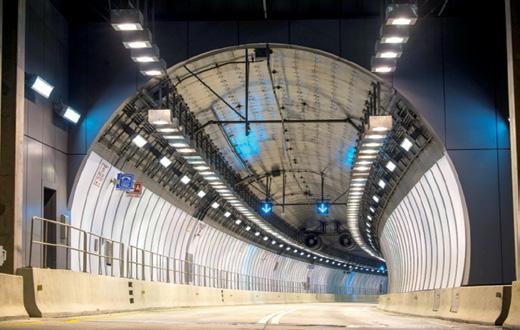
For floods, the tunnel is protected by 55-ton gates with gaskets, which are lowered to seal the tunnel tight. “Last year we lowered the gate six separate times, every time we faced a hurricane,” says Hodgkins. “Our assets are underground, so they have to be protected.”
Like other advances in the port’s technology and infrastructure, the tunnel is all about speed, as well as safety. “In the state of Florida, there are no ships out at sea [waiting to be serviced],” says Webb. “It's all about making our supply chain successful. It’s on and off port. It’s from the time a ship is out at sea, pulls along our dock, gets processed at our facilities, and then is on to its final destination. We’re all about speeding that up.”

Adds Hecker: “We are one of the most efficient ports in the country.” l

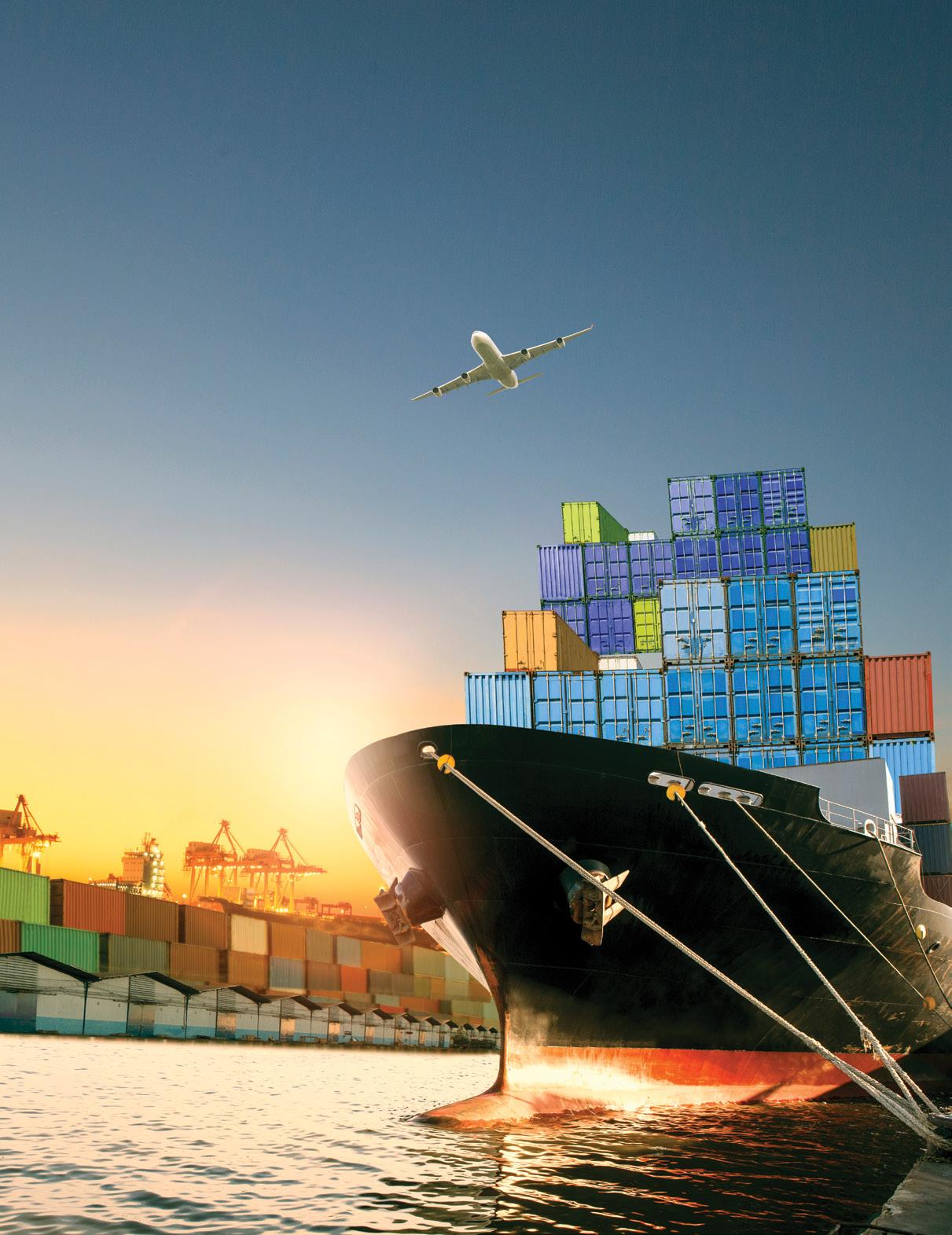
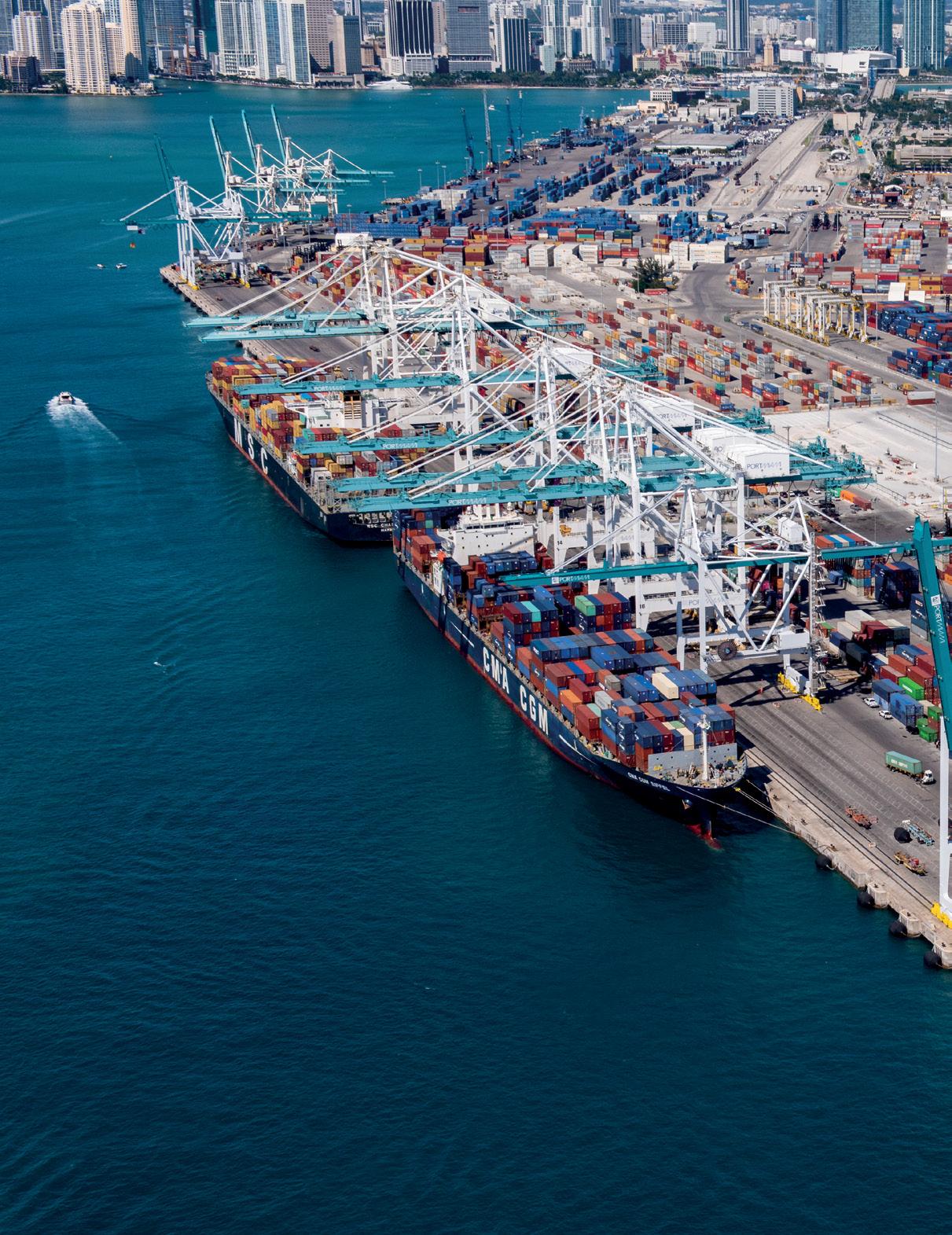 BY YOUSRA BENKIRANE
BY YOUSRA BENKIRANE
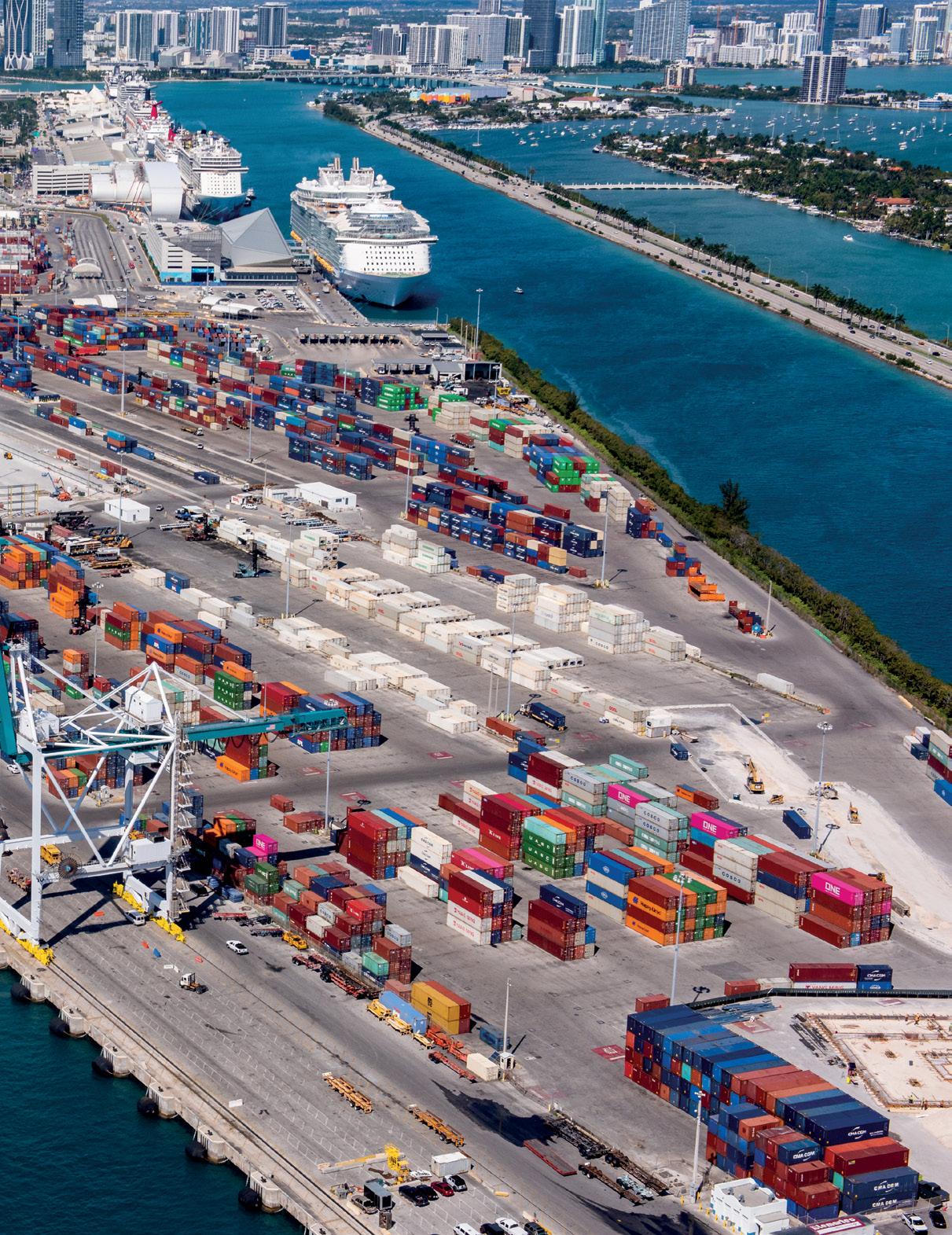
The past few years have been full of both challenges and opportunities impacting international trade. While the pandemic sped up certain trends that reimagined the future of the global economy, like the rapid expansion of digitalization, it also revealed our vulnerability to disruptions in the global supply chain – something the Miami Customs District is now well-aware of.
In the wake of the pandemic, trade took a substantial hit. In the second quarter of 2020, exports from the District – which includes all of South Florida – fell a whopping 32.2 percent, while imports dropped 28.3 percent. But the District quickly bounced back. In Q2 of the following year, exports grew 56.1 percent and imports rose 57.4 percent; another year later (2022), exports grew an additional 20.9 percent, with imports rising 17.6 percent, leading to optimism about a future that had been in doubt.
“The pandemic is something that should have hurt Florida the hardest, much like the global recession did in 2007,” says TJ Villamil, senior vice president of international trade & development at Enterprise Florida, the state’s commerce department. “Instead, we’ve seen the opposite effect take place, where Miami and the state are a lot more resilient than the rest of the country in the face of all the headwinds taking place around the world.”
Andy Hecker, assistant port director and CFO at PortMiami, says that cargo demand peaked to an all-time high in 2021, as home-bound consumers ordered record levels of products – something which helped snap supply chains across the world, especially those between Asia and the U.S.
Not surprisingly, last year’s post-pandemic cargo volumes were slightly down, due to everything from inflationary and interest rate pressures to an over-abundance of inventory from the previous year.
1. BRAZIL
EXPORT VALUE: $13.5B
2. COLOMBIA
EXPORT VALUE: $5.25B
3. CHILE
EXPORT VALUE: $4.62B
TOP COMMODITIES
1. AIRCRAFT PARTS: $4.22B
2. INTEGRATED CIRCUITS: $1.1B
3. TELEPHONES: $649M
1. AIRCRAFT PARTS: $562M
2. TELEPHONES: $360M
3. COMPUTERS: $255M
1. AIRCRAFT PARTS: $665M
2. COMPUTERS: $388M
3. TELEPHONES: $364M
4. DOMINICAN REPUBLIC
EXPORT VALUE: $4.17B 1. CARS: $454M
2. PURE COTTON YARN: $310M
3. MEDICAL INSTRUMENTS: $175M
5. ARGENTINA
EXPORT VALUE: $3.57B
1. COMPUTERS: $652M
2. VACCINES, BLOOD, ANTISERA, TOXINS, AND CULTURES: $337M
3. AIRCRAFT PARTS: $295M
6. UNITED KINGDOM
EXPORT VALUE: $2.99B
1. PACKAGED MEDICATIONS: $2.27B
2. AIRCRAFT PARTS: $202M
3. PAINTINGS: $85.1M
7. COSTA RICA
EXPORT VALUE: $2.89B
1. AIRCRAFT PARTS: $4.22B
2. INTEGRATED CIRCUITS: $1.1B
3. TELEPHONES: $649M
8. PERU
EXPORT VALUE: $2.65B
1. AIRCRAFT PARTS: $330M
2. COMPUTERS: $196M
3. EXCAVATION MACHINERY: $125M
9. HONDURAS
EXPORT VALUE: $2.27B
1. PURE COTTON YARN: $413M
2. SYNTHETIC STAPLE FIBERS: $228M
3. TELEPHONES: $101M
10. PANAMA
EXPORT VALUE: $2.06B
1. AIRCRAFT PARTS: $213M
2. TELEPHONES: $114M
3. COMPUTERS: $86.8M
The positive news is that volumes fell less in South Florida than elsewhere in the U.S., and the dollar value of goods actually rose. At PortMiami, says Hecker, “volumes were a little soft, and for us that is a seven or eight percent down turn after reaching an all-time high in 2021… other ports around the country saw a 10 to 18 percent softening, so we were a fraction of that.”
In 2022, total trade for the Miami Customs District was valued at $136.6 billion, compared to $120 billion in 2021 and $96.8 billion in 2020. The total for the District – which includes Miami International Airport (MIA), PortMiami, Port Everglades, Port of Key West, Fort Lauderdale-Hollywood International Airport, West Palm Beach International Airport, and Port of Palm Beach – represented more than two-thirds of all 2022 two-way trade for Florida, valued at $190 billion. And within the District, most merchandise was handled by MIA ($73.8B) and PortMiami ($32.9B), together more than half the state’s total.
According to Miami International Airport’s Marketing Division Chief Jimmy Nares, the last three years have seen the highest recorded cargo volumes for the airport. In 2021 specifically, MIA reached a new record of 2.75 million U.S. tons, a volume that remained consistent in 2022 while the dollar value rose.

The top commodities that go through the airport are flowers
There’s been a shift in trade all around the world. While supply chain disruptions occurred for many different airports and markets, I think we were less impacted than most...
and pharmaceuticals, thanks to state-of-the-art cold storage facilities. In 2022, 90.5 percent of all U.S. flower air imports came through MIA. At the same time, the airport handled $7 billion worth of pharmaceuticals imports, another record-breaking achievement. “There’s been a shift in trade all around the world,” says Nares. “While supply chain disruptions occurred for many different airports and markets, I think we were less impacted than most. We just continue to have a very strong logistics community that’s equipped and capable of handling perishable products. And we’ve benefited from that.”
At PortMiami, similar shifts in perishable commodities are taking place. Hector says that Greater Miami is poised to benefit from droughts affecting the U.S. Southwest, which “puts a lot of pressure on food grown in the U.S.” Rather than trucks rolling to Florida from Western U.S. agriculture, there will be more products
arriving by ship from Central America and eastern Mexico. “This means new [ocean-bound] products coming into the U.S., refrigerated food products for the U.S. consumer, and that bodes very well for Miami,” says Hecker.
As another leader in handling perishables, Port Everglades has traditionally been well-connected to Latin American and Caribbean (LAC) sources. The port handles around 140,000 containers (TEUs) of perishable goods annually. According to Director of Business Development Jorge Hernández, importers are gearing up for growth in cold storage so they can move more perishables like fruits and vegetables that come from Latin America and the Caribbean to Port Everglades.
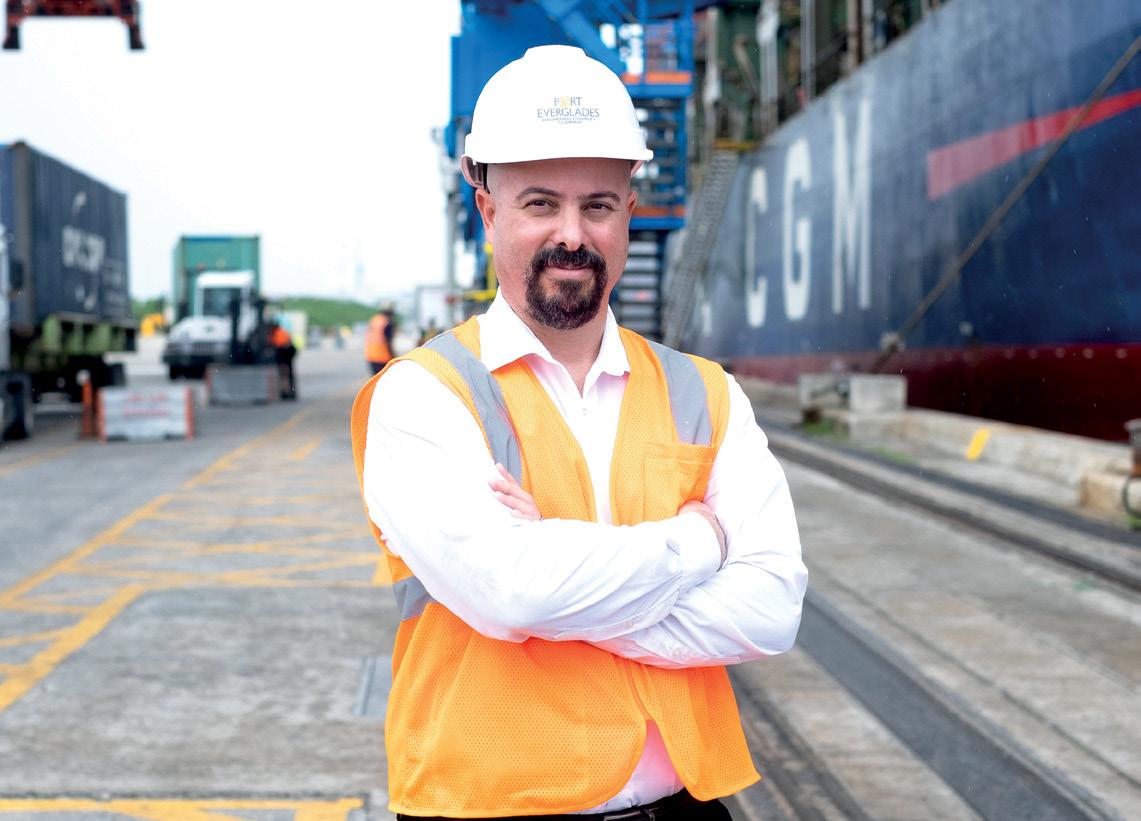
In addition to handling big cargo lines like the Mediterranean shipping line MSC, Port Everglades also works with smaller carriers, like Seacor and HLS, which have more niche routes to and from places like the Bahamas or the Dominican Republic. This is “essentially their only way of bringing goods for consumption into [those] countries,” says Hernández. “These are not countries that produce much of the goods they consume on a regular basis.”
Indeed, connectivity with Latin America, Central America, and the Caribbean remains one of the strong suits of the Miami Customs District. Villamil compares Miami’s trade capabilities to
This is essentially their only way of bringing goods for consumption into those countries. These are not countries that produce much of the goods they consume on a regular basis...
JORGE HERNÁNDEZ, DIRECTOR OF BUSINESS DEVELOPMENT, PORT EVERGLADESinternational gateways like Singapore and Dubai, referencing its “perfect location between two continents in the Americas.”
Manny Mencia, the newly instated chairman of the board of World Trade Center Miami and previous senior vice president of international trade and business development at Enterprise Florida, notes a key trend that has increased the value of the Miami District’s exports: the domination of high-value goods. “The products that lead Miami exports are things like aviation and technology, medical-related exports… These are all high-end, high-tech, high-value
The products that lead Miami exports are things like aviation and technology, medical-related exports... These are all high-end, hightech, high-value exports, and Miami seems to be doing very well as an exporter of those products.
MANNY MENCIA, CHAIRMAN OF THE BOARD, WORLD TRADE CENTER MIAMI
exports, and Miami seems to be doing very well as an exporter of those products,” Mencia says. Today, the top 10 commodities exported by the District are all high-value, whereas in the past Miami was known primarily for being an exporter of agricultural goods (think citrus). Essentially, Florida has diversified into new industries (something the pandemic accelerated), and as technology products are increasingly used in daily life across the globe, the District has become a top distributor of high-value merchandise like telephones ($4.82B) and computers ($3.91B).
Products like electronics are generally manufactured in China and then imported to Miami, which redistributes them to Latin America and the Caribbean. China is Miami’s top source of imports
1. CHINA
EXPORT VALUE: $7B
2. COLOMBIA
EXPORT VALUE: $4.24B
TOP COMMODITIES
1. TELEPHONES: $1.82B
2. COMPUTERS: $311M
3. INTEGRATED CIRCUITS: $288M
1. GOLD: $1.24B
2. CUT FLOWERS: $1.11B
3. ALUMINUM STRUCTURES: $438M
3. DOMINICAN REPUBLIC
EXPORT VALUE: $3.89B
1. ROLLED TOBACCO: $831M
2. MEDICAL INSTRUMENTS: $665M
3. LOW-VOLTAGE PROTECTION EQUIPMENT: $595M
4. BRAZIL
EXPORT VALUE: $3.02B
1. UNSPECIFIED COMMODITIES: $1.27B
2. PLANE/HELICOPTER/SPACECRAFT PARTS: $272M
3. HANDGUNS: $131M
5. FRANCE
EXPORT VALUE: $2.88B
1. GAS TURBINES: $466M
2. PERFUMES: $458M
3. HARD LIQUOR: $342M
6. CHILE
EXPORT VALUE: $2.83B
1. FISH FILLETS: $1.82B
2. UNSPECIFIED COMMODITIES: $340M
3. FRESH FISH: $130M
7. ITALY
EXPORT VALUE: $2.76B
1. RECREATIONAL BOATS: $522M
2. WINE: $197M
3. FURNITURE: $171M
8. HONDURAS
EXPORT VALUE: $2.7B
9. NICARAGUA
EXPORT VALUE: $2.38B
1. INSULATED WIRE: $576M
2. KNIT SWEATERS: $526M
3. KNIT T-SHIRTS: $319M
1. GOLD: $729M
2. KNIT T-SHIRTS: $346M
3. KNIT SWEATERS: $309M
EXPORT VALUE: $2.1B
1. INTEGRATED CIRCUITS: $592M
2. TELEPHONES: $530M
3. FURNITURE: $185M
and third-largest trade partner overall, with bilateral trade totaling $8.57 billion in 2022, $7 billion of which was imports. Despite the overall drop in U.S. imports from China (down 13.3 percent for the first four months of 2023), the Asian country is one of Miami’s top two partners outside of Latin America and the Caribbean, the other being the UK ($4.89B total trade 2022).

Pushed by the recent supply chain issues, Florida’s trade experts are challenging businesses and the state itself to move away from China as a primary source. “This just shows how tied we are to the supply chain with China,” says Villamil, “As we divest from China, and we invest more in other developing economies, I think Florida is going to continue to thrive because we’re so well positioned.”
With supply chain weaknesses revealed by the pandemic, companies are now reassessing their sourcing of parts and raw materials, with Latin America and the Caribbean in mind. “We’d be better off having a lot of these products manufactured in Latin America and letting [Miami] do distribution domestically and internationally,” says Mencia.
Take, for example, Embraer, a Brazilian multinational aerospace manufacturer that has its North American headquarters in Fort Lauderdale. Embraer is the largest importer of aviation exports from Florida, where aviation and aerospace are leading industries (aviation merchandise is the District’s number one export by dollar value, at $9.5 billion last year). Embraer buys large numbers of aviation and aerospace components that are manufactured in Florida, sends them to Latin America to be assembled, and then returns
them to the District as a finished product to be sold.
“We don’t think Asia is going away, but they certainly have some issues,” says PortMiami's Hecker. “But what we do see happening is an increasing of nearshoring, shifting back to the western hemisphere. Some will shift but not all, so the phrase is 'China plus one.'”
Although our neighbors to the south are Miami’s biggest strength when it comes to trade, experts caution about putting all of the District’s eggs into one basket. With most of Miami’s top trade partners located in Latin America and the Caribbean, concerns about economic decline and instability in the region are encouraging businesses to expand into new economies. “Latin America is, and will always be, the line of least resistance,” says Mencia. “It’s our backyard, it’s our natural turf. However, when your markets are so oriented to one part of the world, you run into the risk of what happens when you have a regional downturn or even a market-specific downturn. You are liable to take a harder hit if you aren’t more diversified.”
Nares notes that while MIA handles 83 percent of all air imports and 80 percent of all air exports between the U.S. and the LAC region, the airport is now looking to add freight services to African markets and to Asian markets outside of China. Currently, there is only one freighter airline operating from Africa and just a handful from Asia, yet “these are areas that hold the greatest opportunities for us to grow,” says Nares. “Growing our global network outside of Lat-
As one of the top ports in the world and located at the confluence of South Florida’s Atlantic shipping lanes, airways, railways and highways, we are your unrivaled connection to global markets.
We’ll take it from here. PortEverglades.net
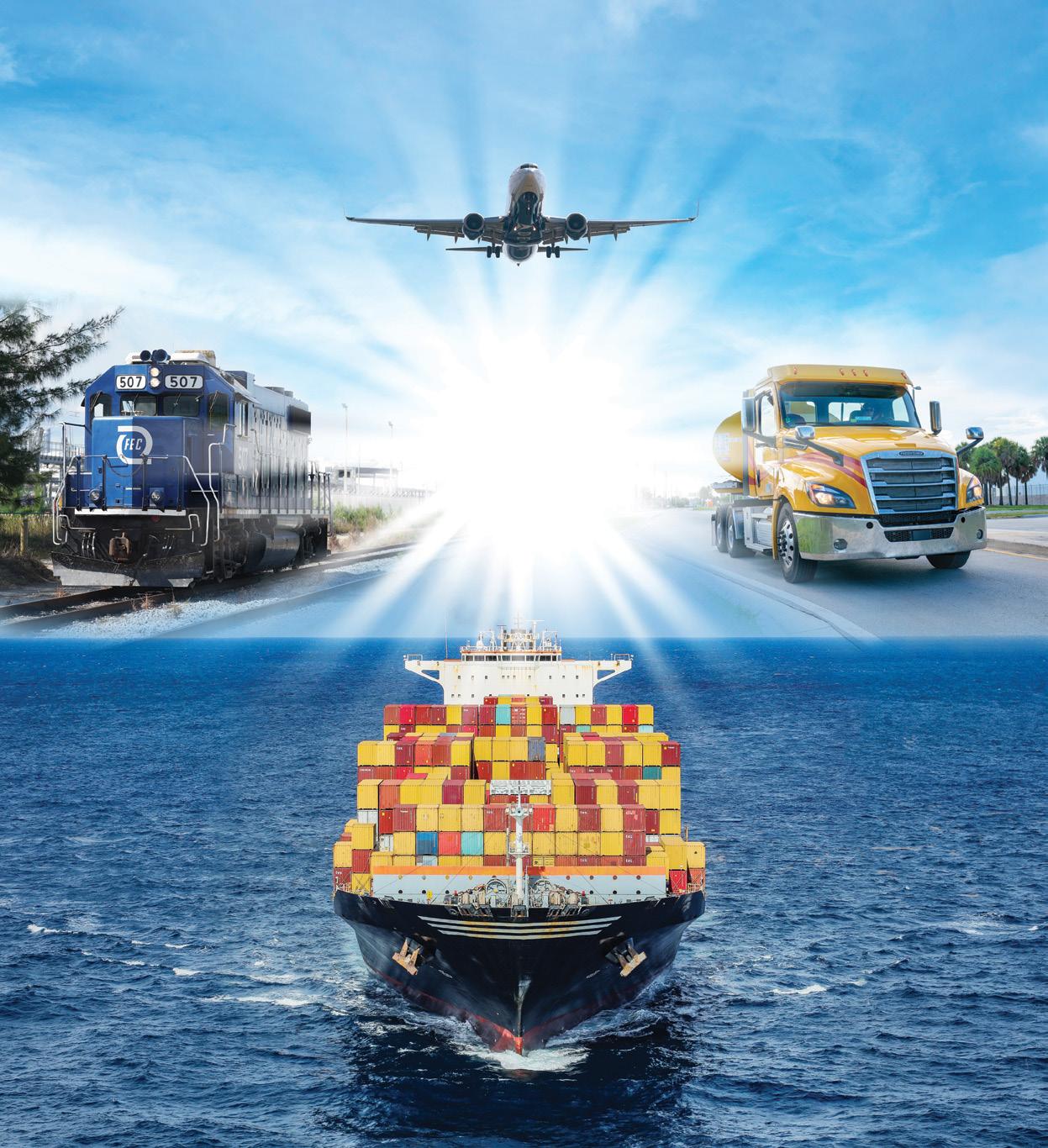
The same advantages that position Miami as an Americas hub also present opportunities for businesses in Sub-Saharan Africa seeking to enter Western Hemisphere markets. Miami is the closest U.S. city to mainland West Africa, about 4,110 miles away from Dakar, Senegal. A nonstop flight would take approximately eight and a half hours. Although this connection does not yet exist, it presents a lucrative opportunity for airlines and investors who want to facilitate both passenger and cargo transportation between the two continents. Likewise, says Hecker, PortMiami sees that “Africa is an opportunity and being on the East Coast of the U.S. gives us an advantage. We think that Africa is an untapped opportunity.” Enterprise Florida’s Villamil agrees: “As Sub-Saharan Africa grows, Florida is going to be poised to benefit, much like we benefited from the rise of South America and their economies.”
That’s not to say Miami should curtail trade with the LAC region – it is the District’s number one selling point, after all. “But I would love to see more of our European partners and sophisticated economies in Asia, like Japan, buy Florida products and services,” Villamil says.
In the meantime, Miami’s District is going to continue to see increased two-way trade with all the economies to the south. Brazil is Miami’s largest trading partner by far, accounting for nearly $17 billion out of the total $136 billion, with Chile, Colombia, Honduras, and the Dominican Republic all big contributors. “We recently started a new shipping line coming from Honduras, which is a business that wasn’t here before,” says Port Everglades’ Hernández. As for increased trade with Europe, both Hernández and PortMiami’s Hecker say that Florida’s pandemic-driven explosion in growth is attracting more trade by virtue of stronger domestic demand for goods from the continent. “What we continue to see is that, as the population in Florida continues to grow faster than the rest of the U.S., we continue to get more volumes across the board and more out of Europe,” says Hecker. “That is something that we are going to continue to see grow.”
So, what’s next? With new growth expected from nearshoring in LAC, new routes from Asia and Africa, and expanding trade with Europe, experts say capacity will be a key issue in the future. In the Miami Custom’s District, plans are afoot to deal with new demand.

Port Everglades is taking on initiatives like using new technology to be able to stack more containers on top of each other, freeing up land space. The port is also exploring alternatives with the Florida East Coast Railway to be able to use its intermodal container transfer facility more effectively, moving cargo more quickly. With limited land (surrounded by the city of Fort Lauderdale and its airport), “We have to think about how we densify the various cargo yards to be able to handle more cargo and to be able to provide space for new business opportunities,” says Hernández. “It doesn’t mean that there are no ways to expand, it just means that we have to think smarter.”
PortMiami, also landlocked, has focused on technology to accelerate services and therefore capacity without physical expansion (see story pg. 46). But it also has plans to create an inland facility in the Northwest corner of Miami-Dade County, linked by rail to the port, for the storage of TEUs and the location of other cargo facilities. MIA, meanwhile, is working on adding more cargo infrastructure by building up rather than out, with a planned multi-billion dollar Vertically Integrated Cargo Community. “The biggest challenge in the next five or 10 years will be to have adequate infrastructure at the airport to be able to accommodate the growth that we’re seeing, and also the forecasted growth that we’re expecting in years to come,” says Nares.
Overall, with the right leadership, policies, and infrastructure, the Miami Customs District is well-positioned to expand its international trade capabilities. There may be unforeseen global disruptions that could slow down the rate of growth, but “fluctuations on the downside tend to be mitigated because we are [increasingly] balanced in all regions,” says Hecker. “Right now, we are looking at a re-setting of the market, getting ready for the next growth cycle.” l

World Trade Center Miami, the largest and oldest trade association in Miami, is part of the World Trade Center Association global business network of 315 World Trade Centers in 92 countries with over two million members.


Whether your business is looking to find your next customer, expand to international markets or make global connections we have the resources, services and decades of expertise to successfully grow your bottom line.
• The annual Americas Food and Beverage Show now in its 27th year – the ideal meeting place for decision makers and buyers from all sectors of the global food and beverage industry.
• The Air Cargo Americas Show, now in its 17th year, held bi-annually, brings together top executives from all sectors of the aviation and logistics industry.
• The Supply Chain Americas Conference is held annually and in conjunction with the Air Cargo Americas Show is one of the leading events focused on innovation and resiliency in the global supply chain.

• Americas Food & Beverage Show: September 18-20, 2023 Miami Beach Convention Center
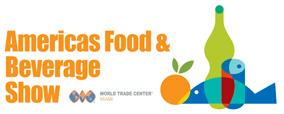
• Air Cargo Americas/Supply Chain Americas Show & Conference: October 31-November 2, 2023
• State of the Ports: November 2023

TAKING A CLOSER LOOK AT TRADE through the Miami Customs District, it becomes clear that each primary port has its own niche. Most high-value products, such as gold, electronics, and live animals, come through Miami International Airport. Most bulk products like fuel, agricultural products, heavy machinery, and automobiles come through Port Everglades and PortMiami.
PortMiami is known for handling containerized cargo carrying a diverse range of goods such as electronics, furniture, apparel, machinery, chemicals, and consumer goods – hence the nickname "Cargo Gateway of the Americas". It serves as a major hub for international trade with the Caribbean, Latin America, and the Asia-Pacific regions. It is the largest container port in Florida and ninth in the United States. In 2022, PortMiami recorded $32.9B in total trade.
Port Everglades, located in Fort Lauderdale, has historically handled bulk products such as coal, minerals, grains, and other raw materials. It is a major entry point for petroleum products, including
gasoline, diesel fuel, jet fuel, and other refined petroleum products for both the local market and regional distribution. These commodities are typically transported in bulk carriers and serve different industries such as power generation, construction, and agriculture. The port is also growing its capacity to handle perishables and containers. In 2022, Port Everglades recorded $28.62B in total trade. Miami International Airport is a major hub for perishable goods, particularly fruits, vegetables, flowers, and seafood, due to the need for temperature-controlled facilities and specialized handling to maintain freshness during transit. The airport plays a vital role in the transportation of pharmaceutical products and medical supplies, such as temperature-sensitive drugs and vaccines. The airport also handles cargo related to the aerospace industry, including aircraft parts, engines, and other aviation equipment, as well high-tech and electronic components (mostly from China) to be redistributed to Latin America and the Caribbean. In 2022, the airport recorded $73.8B in total trade.
Top 2022 Imports
Total: $62.4B
Top 2022 Exports
Total: $74.2B
Data Sources: Enterprise FL, The Observatory of Economic Complexity, United States Census Bureau USA Trade® Online.
Here is a closer look at South Florida’s top imported and exported products from 2022:
PARTNERS ARE ONE ASPECT OF TRADE, VOLUME ANOTHER. BUT PRODUCT TYPE IS KEY.



16. COSTA RICA TOTAL TRADE: $4.20B
EXPORT VALUE: $2.89B IMPORT VALUE: $1.13B
17. GUATEMALA TOTAL TRADE: $3.7B
EXPORT VALUE: $1.97B IMPORT VALUE: $1.82B
18. NICARAGUA TOTAL TRADE: $3.13B
EXPORT VALUE: $754M IMPORT VALUE: $2.38B
19. EL SALVADOR TOTAL TRADE: $2.64B
EXPORT VALUE: $1.36B IMPORT VALUE: $1.28B
20. MEXICO TOTAL TRADE: $2.5B
EXPORT VALUE: $1.19B IMPORT VALUE: $1.32B
21. PANAMA TOTAL TRADE: $2.3B
EXPORT VALUE: $2.06B IMPORT VALUE: $292M
22. BAHAMAS TOTAL TRADE: $2.1B
EXPORT VALUE: $1.82B IMPORT VALUE: $380M
23. TRINIDAD & TOBAGO TOTAL TRADE: $1.69B
EXPORT VALUE: $1.63B IMPORT VALUE: $62.1M
24. JAMAICA TOTAL TRADE: $1.3B
EXPORT VALUE: $873M IMPORT VALUE: $130M
25. HAITI TOTAL TRADE: $1.2B
EXPORT VALUE: $390M IMPORT VALUE: $822M
26. CANADA TOTAL TRADE: $712.4M
EXPORT VALUE: $59.4M IMPORT VALUE: $653M
27. CAYMAN ISLANDS TOTAL TRADE: $707.2M
EXPORT VALUE: $689M IMPORT VALUE: $18.2M
28. BARBADOS TOTAL TRADE: $490.7M
EXPORT VALUE: $399M IMPORT VALUE: $10.7M
TOTAL TRADE: $8.60B
EXPORT VALUE: $4.17B IMPORT VALUE: $3.89B
15. HONDURAS TOTAL TRADE: $4.97B
EXPORT VALUE: $2.27B IMPORT VALUE: $2.7B
29. ARUBA TOTAL TRADE: $331.8M
EXPORT VALUE: $327M IMPORT VALUE: $4.82M
30. TURKS & CAICOS TOTAL TRADE: $319.01M
EXPORT VALUE: $311M IMPORT VALUE: $8.51M
31. BELIZE TOTAL TRADE: $258.8M
EXPORT VALUE: $235M IMPORT VALUE: $23.8M
32. SAINT MAARTEN TOTAL TRADE: $256.8M
EXPORT VALUE: $242M IMPORT VALUE: $14.8M
33. CURAÇAO TOTAL TRADE: $203.47M
EXPORT VALUE: $196M IMPORT VALUE: $7.47M
34. ANTIGUA & BARBUDA TOTAL TRADE: $182.3M
EXPORT VALUE: $179M IMPORT VALUE: $3.31M
35. BRITISH VIRGIN ISLANDS TOTAL TRADE: $142.2M
EXPORT VALUE: $140M IMPORT VALUE: $2.2M
36. SAINT LUCIA TOTAL TRADE: $139.9M
EXPORT VALUE: $134M IMPORT VALUE: $5.92M
37. SAINT KITTS & NEVIS TOTAL TRADE: $117.4M
EXPORT VALUE: $98M IMPORT VALUE: $19.4M
38. GRENADA TOTAL TRADE: $82.1M
EXPORT VALUE: $69.9M IMPORT VALUE: $12.2M
39. ST VINCENT & THE GRENADINES TRADE: $68.5M
EXPORT VALUE: $60.9M IMPORT VALUE: $7.66M
40. ANGUILLA TOTAL TRADE: $50.77M
EXPORT VALUE: $45.8M IMPORT VALUE: $4.97M
41. DOMINICA TOTAL TRADE: $39.9M
EXPORT VALUE: $39.4M IMPORT VALUE: $554K
42. CUBA TOTAL TRADE: $36.4M
EXPORT VALUE: $32M IMPORT VALUE: $4.41M
43. MARTINIQUE TOTAL TRADE: $17.47M
EXPORT VALUE: $17.4M IMPORT VALUE: $78K
44. BERMUDA TOTAL TRADE: $13.18M
EXPORT VALUE: $13M IMPORT VALUE: $180K
45. MONTSERRAT TOTAL TRADE: $5.08M
EXPORT VALUE: $4.88M IMPORT VALUE: $209K
In today’s fast-paced market, the only way to close the gap with your trading partners is to improve the supply chain. To do this, you will need a group of dedicated, hardworking professionals with 40 years of experience in logistics and ocean transportation. You will need more than just excellent customer service. You will want to work with a company striving to be better and more innovative. At Seaboard Marine, your customers are closer because our customers are at the center of everything we do.
www.seaboardmarine.com

62. FINLAND TOTAL TRADE: $140.13M
EXPORT VALUE: $40.4M IMPORT VALUE: $101M
63. THE CZECH REPUBLIC TOTAL TRADE: $149.75M
EXPORT VALUE: $31.1M IMPORT VALUE: $118M
64. LUXEMBOURG TOTAL TRADE: $112.9M
EXPORT VALUE: $85.5M IMPORT VALUE: $27.4M
65. UKRAINE TOTAL TRADE: $96.7M
EXPORT VALUE: $61.2M IMPORT VALUE: $35.5M
66. GREECE TOTAL TOTAL TRADE: $85.8M
EXPORT VALUE: $38.4M IMPORT VALUE: $47.4M
67. LITHUANIA TOTAL TRADE: $76.4M EXPORT VALUE: $29.2M IMPORT VALUE: $47.2M
68. ICELAND TOTAL TRADE: $68.43M
EXPORT VALUE: $62.8M IMPORT VALUE: $5.63M
69. RUSSIA TOTAL TRADE: $68.3M
EXPORT VALUE: $29.7M IMPORT VALUE: $38.6M
70. ROMANIA TOTAL TRADE: $40M EXPORT VALUE: $13.6M IMPORT VALUE: $26.4M
71. BULGARIA TOTAL TRADE: $38.8M EXPORT VALUE: $6.91M IMPORT VALUE: $31.9M
72. SERBIA TOTAL TRADE: $37.14M EXPORT VALUE: $2.84M IMPORT VALUE: $34.3M
73. LATVIA TOTAL TRADE: $33.16M EXPORT VALUE: $7.66M IMPORT VALUE: $25.5M
74. ESTONIA TOTAL TRADE: $19.86M
EXPORT VALUE: $6.46M IMPORT VALUE: $13.4M
75. CROATIA TOTAL TRADE: $13.9M EXPORT VALUE: $7.22M IMPORT VALUE: $6.68M
76. SLOVAKIA TOTAL TRADE: $13.57M
EXPORT VALUE: $2.07M IMPORT VALUE: $11.5M
79. MONACO TOTAL TRADE: $6.32M
EXPORT VALUE: $2.14M IMPORT VALUE: $4.18M
80. BELARUS TOTAL TRADE: $5.1M
EXPORT VALUE: $2.03M IMPORT VALUE: $3.07M
81. MOLDOVA TOTAL TRADE: $3.35M
EXPORT VALUE: $1.74M IMPORT VALUE: $1.61M
82. BOSNIA & HERZEGOVINA TOTAL TRADE: $3M
EXPORT VALUE: $207K IMPORT VALUE: $2.8M
83. KOSOVO TOTAL TRADE: $1.74M
EXPORT VALUE: $855K IMPORT VALUE: $894K
84. ALBANIA TOTAL TRADE: $1.63M
EXPORT VALUE: $605K IMPORT VALUE: $1.03M
85. LIECHTENSTEIN TOTAL TRADE: $691K
EXPORT VALUE: $395K IMPORT VALUE: $296K
86. ANDORRA TOTAL TRADE: $534K
EXPORT VALUE: $115K IMPORT VALUE: $419K
87. GREENLAND TOTAL TRADE: $140.2K
EXPORT VALUE: $137K IMPORT VALUE: $3.2K
88. CHINA TOTAL TRADE: $8.57B
EXPORT VALUE: $1.57B IMPORT VALUE: $7B
89. VIETNAM TOTAL TRADE: $2.17B
EXPORT VALUE: $76.4M IMPORT VALUE: $2.1B
90. INDIA TOTAL TRADE: $1.45B
EXPORT VALUE: $373M IMPORT VALUE: $1.08B
91. TURKEY TOTAL TRADE: $1.24B
EXPORT VALUE: $205M IMPORT VALUE: $1.04B
92. UNITED ARAB EMIRATES TOTAL TRADE: $982M
EXPORT VALUE: $820M IMPORT VALUE: $162M
EXPORT VALUE: $50.4M IMPORT VALUE: $127M
60. HUNGARY TOTAL TRADE: $176.1M EXPORT VALUE: $89.3M IMPORT VALUE: $86.8M
61. DENMARK TOTAL TRADE: $159M EXPORT VALUE: $47M IMPORT VALUE: $112M
77. CYPRUS TOTAL TRADE: $11.06M
EXPORT VALUE: $7.26M IMPORT VALUE: $3.8M
78. MALTA TOTAL TRADE: $6.90M
EXPORT VALUE: $2.04M IMPORT VALUE: $4.05M
93. TAIWAN TOTAL TRADE: $982M
EXPORT VALUE: $186M IMPORT VALUE: $796M
94. MALAYSIA TOTAL TRADE: $945M
EXPORT VALUE: $207M IMPORT VALUE: $738M
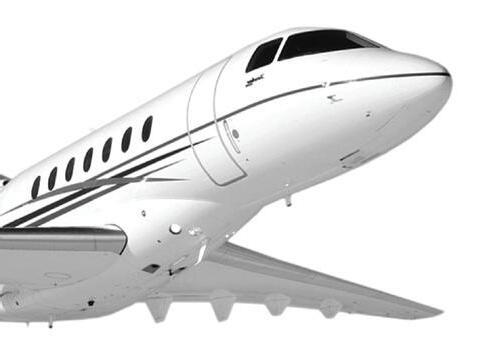

112. TAJIKISTAN TOTAL TRADE: $40.13M
VALUE: $40.1M IMPORT VALUE: $13.3K
114.
115.
116. LEBANON TOTAL TRADE: $23.53M EXPORT VALUE: $17.2M IMPORT VALUE: $6.33M
117. ARMENIA TOTAL TRADE: $22.86M EXPORT VALUE: $22.5M IMPORT VALUE: $361K
118. SRI LANKA TOTAL TRADE: $19.57M EXPORT VALUE: $3.07M IMPORT VALUE: $16.5M
119. MALDIVES TOTAL TRADE: $19.2M EXPORT VALUE: $15.3M IMPORT VALUE: $13.9M
120. IRAQ TOTAL TRADE: $15.1M EXPORT VALUE: $10.4M IMPORT VALUE: $4.7M
121. AZERBAIJAN TOTAL TRADE: $8.42M
VALUE: $5.12M IMPORT VALUE: $3.3M
122. BRUNEI TOTAL TRADE: $7.21M EXPORT VALUE: $5.91M IMPORT VALUE: $1.3M
123. NEPAL TOTAL TRADE: $5.82M
EXPORT VALUE: $2.62M IMPORT VALUE: $3.2M
124. KYRGYZSTAN TOTAL TRADE: $5.39M
EXPORT VALUE: $4.88M IMPORT VALUE: $515K
125. UZBEKISTAN TOTAL TRADE: $3M
EXPORT VALUE: $2.44M IMPORT VALUE:567K
126. IRAN TOTAL TRADE: $2.96M
EXPORT VALUE: $2.92M IMPORT VALUE: $44K
127. LAOS TOTAL TRADE: $990K
EXPORT VALUE: $153K IMPORT VALUE: $837K
128. MONGOLIA TOTAL TRADE: $951K
EXPORT VALUE: $908K IMPORT VALUE: $43K
129. YEMEN TOTAL TRADE: $457K
EXPORT VALUE: $296K IMPORT VALUE: $161K
130. AFGHANISTAN TOTAL TRADE: $426K
EXPORT VALUE: $426K
131. MYANMAR TOTAL TRADE: $309K
EXPORT VALUE: $309K
132. SOUTH AFRICA TOTAL TRADE: $233.8M
EXPORT VALUE: $69.8M IMPORT VALUE: $164M
133. NIGERIA TOTAL TRADE: $117.9M
EXPORT VALUE: $102M IMPORT VALUE: $15.9M
134. EGYPT TOTAL TRADE: $68.1M
EXPORT VALUE: $14M IMPORT VALUE: $54.1M
135. ETHIOPIA TOTAL TRADE: $55.84
EXPORT VALUE: $52.5M IMPORT VALUE: $3.34M
136. MOROCCO TOTAL TRADE: $48.2M
EXPORT VALUE: $15M IMPORT VALUE: $33.2M
137. ALGERIA TOTAL TRADE: $38M EXPORT VALUE: $6.7M IMPORT VALUE: $31.3M
138. ANGOLA TOTAL TRADE: $36.7M EXPORT VALUE: $10.3M IMPORT VALUE: $26.4M
139. KENYA TOTAL TRADE: $16.97M
EXPORT VALUE: $11.6M IMPORT VALUE: $5.37M
140. TUNISIA TOTAL TRADE: $15.5M
EXPORT VALUE: $12.3M IMPORT VALUE: $13.2M
141. GHANA TOTAL TRADE: $14.8M
EXPORT VALUE: $12.1M IMPORT VALUE: $2.7M
142. TOGO TOTAL TRADE: $10.68M
EXPORT VALUE: $480K IMPORT VALUE: $10.2M
143. CAMEROON TOTAL TRADE: $7.53M
EXPORT VALUE: $4.33M IMPORT VALUE: $3.2M
144. UGANDA TOTAL TRADE: $6.64M
EXPORT VALUE: $6.16M IMPORT VALUE: $484K




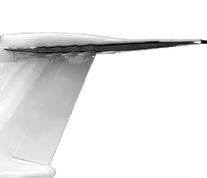

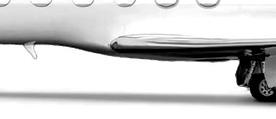


161. DJIBOUTI TOTAL TRADE: $1.88M EXPORT VALUE: $1.52M IMPORT VALUE: $366K
162. BENIN TOTAL TRADE: $1.69M EXPORT VALUE: $399K IMPORT VALUE: $1.3M
163. SIERRA LEONE TOTAL TRADE: $1.55M
EXPORT VALUE: $1.49M IMPORT VALUE: $63K

164. SEYCHELLES TOTAL TRADE: $1.27M
EXPORT VALUE: $840K IMPORT VALUE: $431K
165. ZAMBIA TOTAL TRADE: $1.23M
EXPORT VALUE: $1.19M IMPORT VALUE: $47K
166. MADAGASCAR TOTAL TRADE: $1.17M
EXPORT VALUE: $1.02M IMPORT VALUE: $1.15M
167. ESWATINI TOTAL TRADE: $1.13M
EXPORT VALUE: $987K IMPORT VALUE: $149K
168. GABON TOTAL TRADE: $1.1M
EXPORT VALUE: $565K IMPORT VALUE: $540K
169. SÃO TOMÉ & PRÍNCIPE TOTAL TRADE: $942.8K EXPORT VALUE: $877K IMPORT VALUE: $65.8K


170. MAURITANIA TOTAL TRADE: $923K
EXPORT VALUE: $879K IMPORT VALUE: $44K
171. CAPE VERDE TOTAL TRADE: $922K
EXPORT VALUE: $232K IMPORT VALUE: $690K
172. MALAWI TOTAL TRADE: $709K EXPORT VALUE: $524K IMPORT VALUE: $185K
173. GUINEA TOTAL TRADE: $681K EXPORT VALUE: $220K IMPORT VALUE: $461K
174. MALI TOTAL TRADE: $665K
EXPORT VALUE: $609K IMPORT VALUE: $56K
175. CHAD TOTAL TRADE: $631K
EXPORT VALUE: $464K IMPORT VALUE: $167K
176. SUDAN TOTAL TRADE: $557K EXPORT VALUE: $524K IMPORT VALUE: $33K
177. EQUATORIAL GUINEA TOTAL TRADE: $328K
EXPORT VALUE: $162K IMPORT VALUE: $166K
178. BOTSWANA TOTAL TRADE: $280.8K EXPORT VALUE: $276K IMPORT VALUE: $4.8K
179. SOUTH SUDAN TOTAL TRADE: $258K EXPORT VALUE: $258K
180. ERITREA TOTAL TRADE: $137K EXPORT VALUE: $115K IMPORT VALUE: $22K
181. BURUNDI TOTAL TRADE: $44.9K EXPORT VALUE: $44.9K IMPORT VALUE: $324

182. AUSTRALIA TOTAL TRADE: $414M EXPORT VALUE: $169M IMPORT VALUE: $245M

183. NEW ZEALAND TOTAL TRADE: $119.6M EXPORT VALUE: $23.1M IMPORT VALUE: $96.5M



184. GUADELOUPE TOTAL TRADE: $30.92M EXPORT VALUE: $30.5M IMPORT VALUE: $426K
185. FIJI TOTAL TRADE: $10.63M EXPORT VALUE: $137K IMPORT VALUE: $10.5M
186. FRENCH POLYNESIA TOTAL TRADE: $3.56M








































The financial payments system across the world is cracking, because it was developed with different generations of technology, and they’re being connected in ways that don’t fulfill end-customer demand for availability and accessibility anytime, anywhere.
ANABEL PEREZ, CEO OF NOVOPAYMENTPhoto by Rodolfo Benitez
With her shoulder-length bob hairstyle and shiny lipstick, Anabel Perez does not look like your typical tech CEO. Yet the Latina banker-turned-entrepreneur is shaking up the payments industry, earning global accolades and helping make Miami a center for financial technology – AKA fintech.
Perez started out nearly 20 years ago with a dream: to deploy tech to banks to offer services more broadly, especially to the tens of millions of residents in Latin America with no bank accounts. In 2007, she co-founded NovoPayment in Miami for easy access across the Americas, likening her work to trekking through a jungle, machete in hand, slashing away obstacles to modern banking.
Today, her pioneering venture offers a banking-as-a-service platform, operating in 15 countries and employing some 400 people. It links banks to software companies specialized in such tasks as opening a bank
account online. And it provides its own services, like compliance with banking laws in different nations.
Female-led companies receive less than three percent of venture capital worldwide, yet Perez last year managed to secure $19 million in funding for NovoPayment. That helped her earn “High Commendation” at the 2022 Banking Tech Awards in London, the latest of her CEO awards worldwide. And Perez says she’s just getting started, with fintech innovation still in its infancy.
“The financial payments system across the world is cracking, because it was developed with different generations of technology, and they’re being connected in ways that don’t fulfill end-customer demand for availability and accessibility anytime, anywhere,” Perez says. “For example, when you download the app for your bank and want to make a deposit to pay your credit card, it takes two days. That’s because the connecting systems don’t speak to each other in real-time.”
Perez’s success underscores Miami’s rise as a tech hub, especially for Latin America and fintech. The just-released 2023 Global Startup Ecosystem Report shows Miami jumped 10 spots to rank for the first time among the world’s top 25 hubs for emerging companies. That’s due partly to growing international links, diversity, and female leadership, analysts say. Last year, when South Florida reaped a record $5 billion-plus in venture capital, fintech received the largest share of that cash, says industry tracker Pitchbook.
The global fintech industry spans a wide range of companies and organizations, from those focused on banks like NovoPayment, to those helping immigrants send money back home, to those helping employers pay remote workers around the word. Some groups now help founders and funders unite.
The word was hardly in use when longtime banker Perez and fellow Venezuelan finance executive Oscar Garcia Mendoza co-founded their venture 16 years ago as a tech enabler. Back then, the duo saw opportunity in tools such as pre-paid debit cards, which could help Latin Americans slash reliance on cash as a form of payment.
Over time, as tech tools evolved, their concept did too. Now, they aim to digitize infrastructure for payments across the Americas. NovoPayment’s platform offers access to cloud-based software, interfaces, and services through subscriptions. It works not only with traditional banks or newer online ones but with payment-card companies like Visa and Mastercard, payroll processers, retailers, remittance firms, and other businesses, serving more than 10,000 corporate customers. In the U.S., for instance, it helps credit unions, many at risk because of banking consolidation, “to reach new audiences in ways they couldn’t before,” Perez says. It lets those small rivals add services by subscription without making big outlays to buy software outright or hire lots of in-house staff, she says.
For Perez, access to capital – not technology – has been the biggest challenge. As a Latina entreprenuer in Miami in the 2000s and 2010s, she found few paths to major funding. “A friend of mine in Silicon Valley
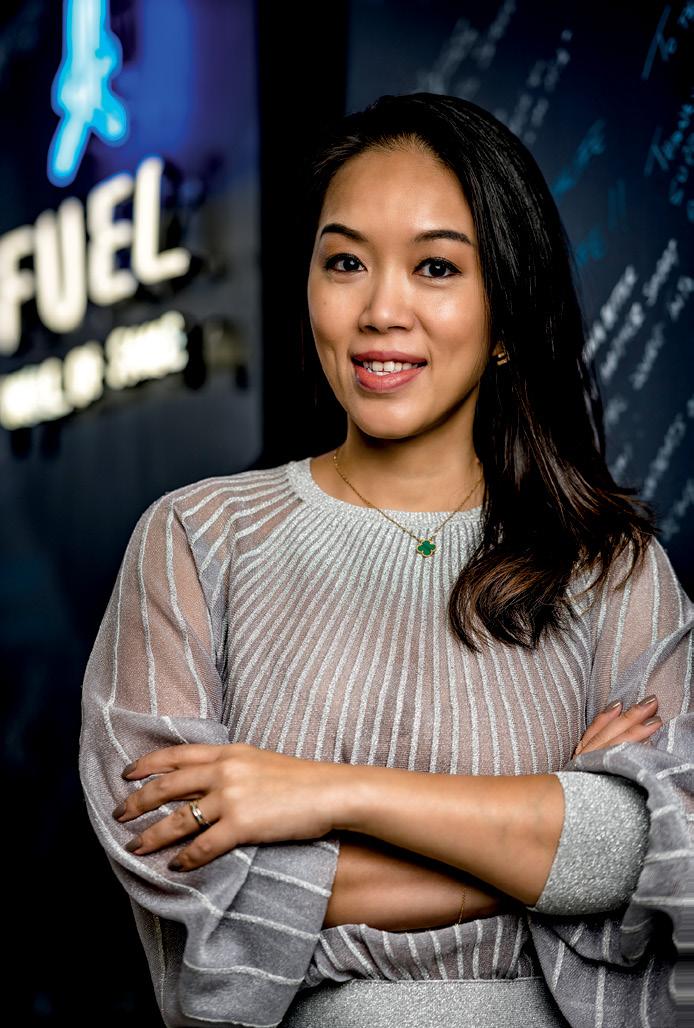
told me: VC for a fintech in Miami led by a woman? Almost impossible,” she recalls.
Still, she forged on. By steadily networking in Miami’s fast-growing tech community, especially with respected accelerators Endeavor and TheVentureCity, both led by women, she scored Series A funding last year from a Miami group also led by a woman, Fuel Venture Capital. That group’s managing partner, Vietnam-born Maggie Vo, arranged the $19 million deal, with co-investors IDC Ventures, Endeavor Catalyst, IDB Lab, and Visa’s venture arm – all groups active in Miami who had known Perez for years.
“Our funding round was the largest for
Few companies have the capabilities, breadth, and depth of services NovoPayment offers...
MAGGIE VO (ABOVE), MANAGING PARTNER, FUEL VENTURE CAPITAL
a fintech with a female CEO at that time, a JPMorgan report said. I think it’s still the largest one, and that’s a shame,” says Perez. While she celebrates women helping women, Perez wishes funding were more accessible to everyone from groups everywhere.
Vo says she backs NovoPayment because of “massive potential” in fintech. “Incumbent banks can no longer delay digital transformation, and non-financial companies [including retailers] are forced to incorporate financial services into their businesses,” she says. And she applauds “trailblazing” Perez for her two-decade experience in banking and tech, her “inclusive” leadership style, and her passion to build.
“Few companies have the capabilities, breadth, and depth of services NovoPayment offers,” says Vo, mentioning the venture’s multi-language and multi-currency strength, “leaving NovoPayment in a unique position to become the dominant player in fintech infrastructure in the Americas.”
The pandemic accelerated the shift to digital finance, and dozens of fintechs have followed Perez into Miami in recent years, offering a wide range of services both for banks, immigrants, and employers.
One newcomer from Europe: Majority, which helps migrants obtain a bank account, debit card, and no-fee international cash transfers. Members pay monthly fees starting at $6 in the U.S.
“We are living in a new era of immigration, with 300 million migrants around the world,” including 50 million first-generation immigrants in the U.S., says Majority’s CEO Magnus Larsson. Majority registers members in the U.S. with “only a government-issued ID from any country and proof of a U.S. address, such as a utility bill.” Members need not show a U.S. government- issued Social Security or taxpayer ID number, “allowing many migrants to open a bank account for the first time in their lives.”
Majority launched in Sweden in 2019 and then set up in two key U.S. cities for immigrants: Miami, which has the largest share of foreign-born residents of any major U.S. metro area, and Houston, which hosts the most diverse migrant population coming from Mexico, India, Vietnam, Nigeria, and beyond.
Today, Majority has some 20 employees in greater Miami and plans to expand, thanks to $9.75 million in new Series B
funding announced in June. That cash brings its total funding to $86 million. The infusion should also help grow its advisor program – including many immigrants – who assist Majority members as they open an account and settle into life in United States, says Larsson.
Meanwhile, two Colombian entrepreneurs launched Miami startup Ontop in 2020 to help companies pay employees or contractors overseas. Their payroll platform handles such complexities as invoices, taxes, cash transfers, and compliance with local regulations in different nations, charging fees for each transaction. It works directly with NovoPayment to obtain bank cards from Visa and others in varied nations, says Julian Torres, co-founder and chief operating officer. “We’re tapping important market trends: the explosion in remote work since COVID, rising costs for healthcare and benefits in the U.S., and cash-flow pressures on companies from inflation,” he says.
Ontop now employs some 20 people in Miami out of some 35 across the U.S., plus 80 in Colombia and others in Brazil, Mexico, and Peru. It helps employers transfer hundreds of millions of dollars yearly to workers in some 40 nations, with invoices largely handled in English. Most clients are U.S. or European companies sending payments mainly to software developers and other information-tech personnel in emerging markets, where talent is abundant and costs lower than in North America or Europe, says Torres.
“When we launched, Ontop served mainly venture capital-based startups, but

Members register in the U.S. with only a government-issued ID from any country and proof of a U.S. address, such as a utility bill, allowing many migrants to open a bank account for the first time in their lives.
now we’re onboarding more multinationals and public companies in the enterprise market,” says Torres. “Our software differentiates us, because we comply rigorously with local laws both in labor and finance.” He says the platform can save companies up to 15 percent on cross-border payments because of better exchange rates and smaller outlays on administration and other expenses.
So far, Ontop has raised roughly $35 million in funding from such investors as Tiger Global, Point72 Ventures, and Softbank’s SB Opportunity Fund. It’s also worked with Silicon Valley’s accelerator YCombinator and earned a spot on Endeavor’s Outliers list as one of that group’s top performers.
New fintech providers have also spawned related organizations and events in South Florida. Among the most active: Fintech Americas, a communications and marketing group that produces newsletters and other content. This May, its signature conference attracted a record 1,000 attendees from 28 countries to the Fontainebleau Hotel in Miami Beach, representing 172 banks and financial institutions, plus 116 software ventures, says co-founder and CEO Ray Ruga.
Ruga says his group builds on three linked trends: Miami’s longtime strength as a banking hub, ranking second in the U.S. for international banking, trailing only after New York; the city’s decades-old role as the de-facto business capital for the Americas; and the recent push by Miami Mayor Francis Suarez and other local leaders to make Miami a tech and finance hub for the Americas. “Our play historically, geographically, and culturally has been north-south for the Americas,” says Cuban-American Ruga.
He sees the fintech industry now converging, with banks and newer digital players no longer seeing each other as rivals but rather as “frenemies,” both needing the other to develop. “COVID was a great accelerator for banks accepting new tech platforms as a core way to do business,” Ruga says.
Longer-term, many see a bright future for fintech in South Florida. “When I lived in Miami 20 years ago, this city had two prominent categories of people – young and beautiful or retired and wealthy,” says
Majority’s Larsson. “With the changes the city has made, in addition to more startups and capital, Miami can attract great talent from all over the U.S. and worldwide. The combination of real diversity and the influx of talent creates a great opportunity to build truly innovative companies.”
Still, the area has weaknesses, such as “access to top talent specialized in fintech, as Miami’s fintech ecosystem is still in the early stages of development, compared to more mature fintech hubs like New York or San Francisco,” says Vo at Fuel Venture Capital. And South Florida needs to expand investment support from around the world. “The more institutional investors that are in Miami and are willing to invest in Miami’s fintech companies, the better it is for founders and our portfolio companies,” she says.
Miami also faces serious workforce challenges, especially sky-high costs for housing and limited public transport. To boost mass mobility, says Larsson, “I’ll give you my best suggestion – a new tram line going from Brickell up 7th Street, making a turn at 27th,
down 8th Street and back to Brickell.”
Then, there’s the need to boost diversity in funding, especially for women. “Whether you’re an investor expanding your portfolio or a founder seeking financial support, chances are that you are an Ivy League-educated male,” says Vo. Women face stereotypes that they lack technical knowledge and are less rational in decision-making than men, and find “very few mentors, women or men, willing to be role models,” Vo adds. “If women can find communities that welcome them, train them, and mentor them, then they will become more easily integrated into the world of fintech.”
That’s why Perez’s success stands out, says Claudia Duran, managing director for accelerator Endeavor Miami, who lauds Perez’s generosity in the selective Endeavor Entrepreneur global network and with other groups. “We ask our entrepreneurs to pay it forward, and Anabel collaborates and supports others through mentoring,” says Duran. “It’s an inspiration to see a strong woman like her representing fintech.” l

When we launched, Ontop served mainly venture capital-based startups, but now we’re onboarding more multinationals and public companies in the enterprise market...
JULIAN TORRES (RIGHT), CO-FOUNDER AND CHIEF OPERATING OFFICER OF ONTOP
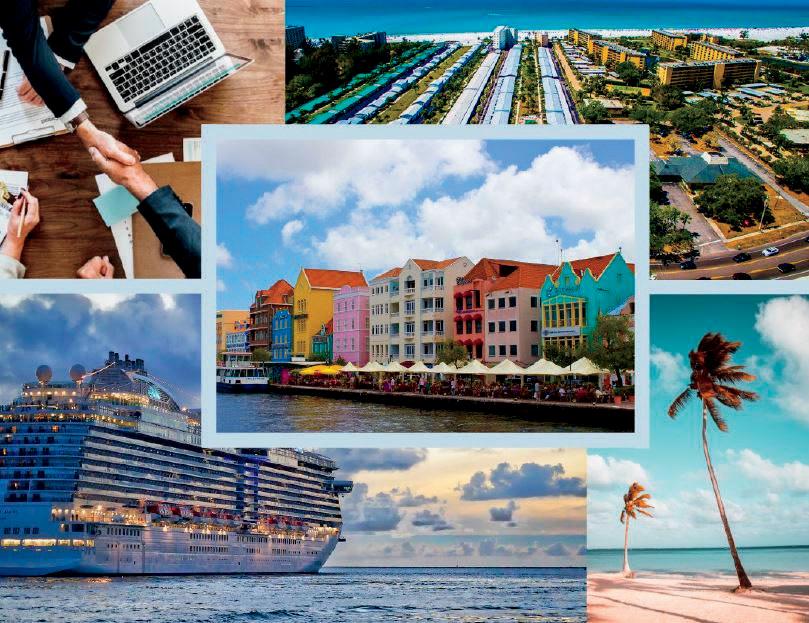




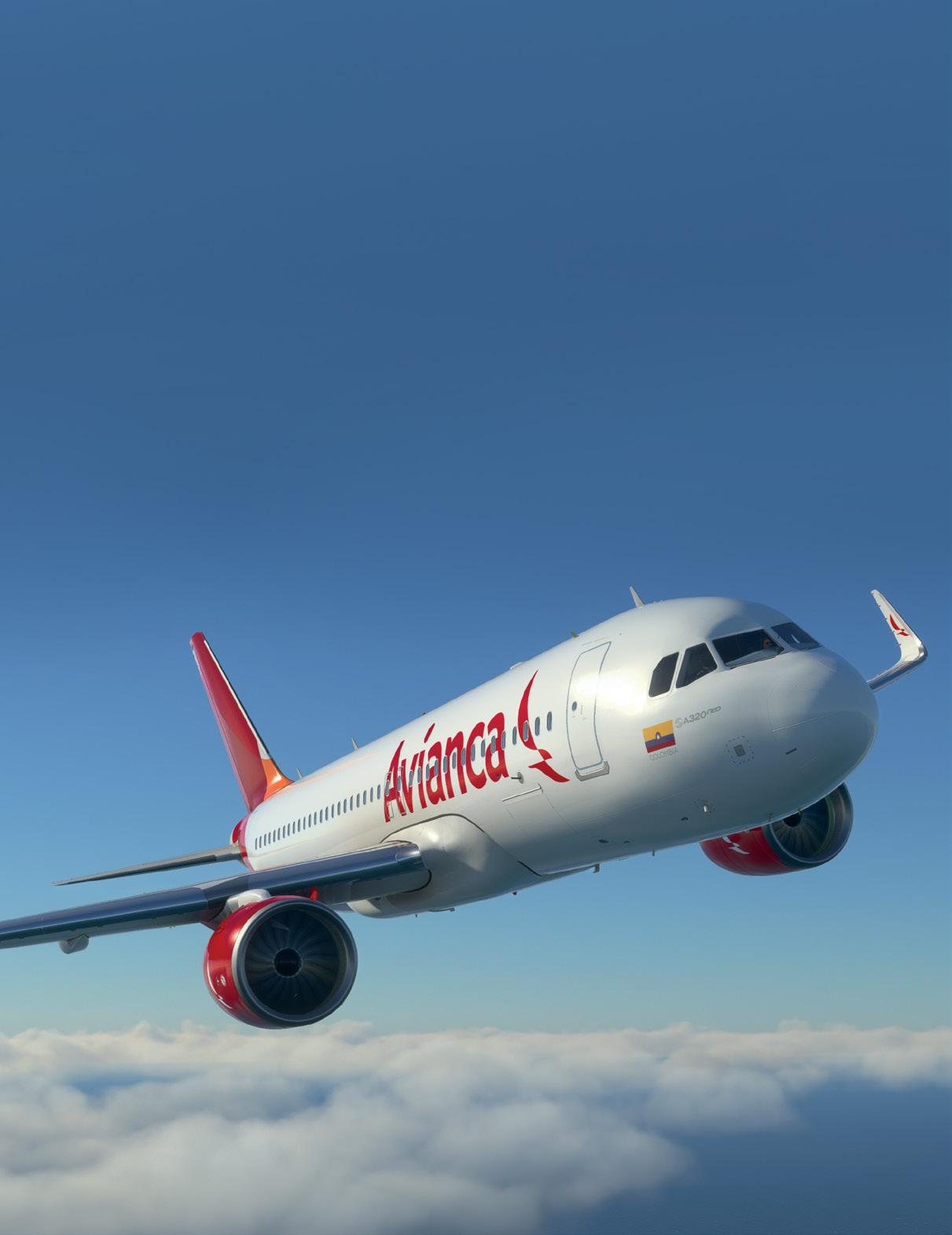
The most difficult area of post-pandemic recovery for airports worldwide has been in the international sector. Commercial flights took a huge dive over the last three years and are only now surpassing 2019 levels. International flights are taking even longer to recover. At Miami International Airport (MIA), however, rehabilitation is almost complete. According to MIA’s Director of Marketing and Air Service Development Emir Pineda, the international presence at MIA is back to about “95 or 96 percent” of what it was pre-COVID.
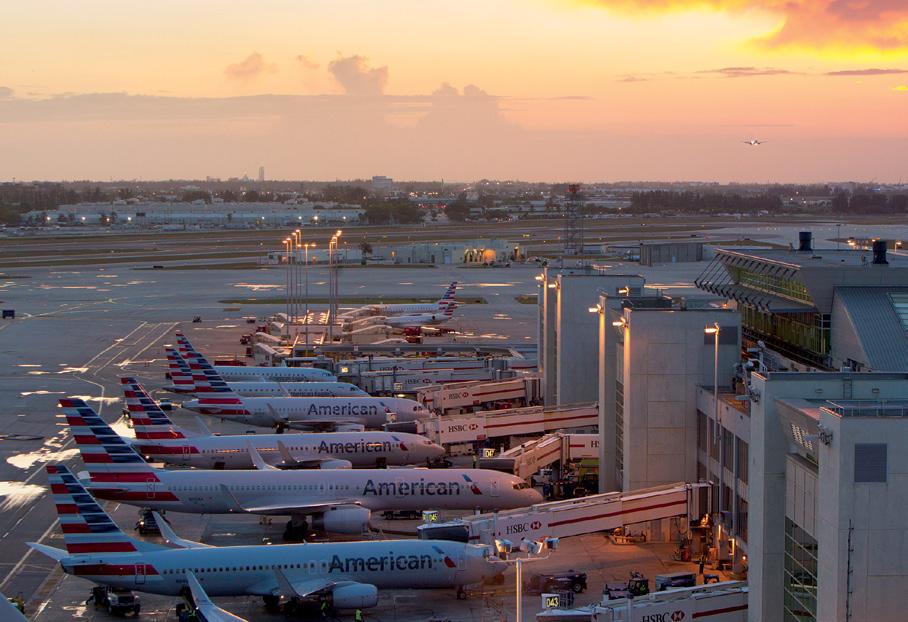
A large part of this resurgence is due to international carriers taking advantage of MIA’s connectivity to Europe and Latin America. Some, like Delta and American Airlines, are resuming flights cancelled during the pandemic, while some are bringing in new routes or expanding old ones for the summer. Others, like Ultra Air and ARCA Air, are waiting in the wings for their new flights to be approved.
Still others are being floated throughout the rumor mill as potential future carriers, with Japan Airlines, Air Serbia, and Qantas among the top contenders. Back in March, Japan Airlines landed its first flight ever at
MIA, a charter flight that included over 100 passengers, mostly players and staff from the Japan national baseball team, which was playing in the World Baseball Classic (and won). As Japan considers a regular transpacific flight, the success of that historic trip will hopefully loom large. Meanwhile, Air Serbia is considering a Miami-Belgrade route, and Qantas is planning ultra-long haul flights connecting MIA with Sydney and Melbourne, Australia – though nothing has been confirmed yet.
Even without these additional carriers, the coterie of new routes and the resumption of old ones halted by the pandemic propelled MIA to the number two position last year of all U.S. airports in international passenger count, losing only to New York’s JFK. As the airport continues to perform well in commercial categories (it ranked eighth in total passengers nationally in 2022, at 50 million passengers), airlines are taking notice. What follows are the new or resumed routes MIA has launched over the last year from both new and old international carriers.
AMERICAN AIRLINES
BEEF ISLAND. BRITISH VIRGIN ISLANDS
FRENCH BEE
PARIS, FRANCE
AVIANCA
PEREIRA, COLOMBIA
BUCARAMANGA, COLOMBIA
SANTA MARTA, COLOMBIA
AIR CANADA
VANCOUVER, CANADA
GOL LINHAS AEREAS
MANAUS, BRAZIL
FORTALEZA, BRAZIL
SKY HIGH
SANTA DOMINGO, DOMINICAN REPUBLIC
EASTERN AIRLINES
SANTA DOMINGO, DOMINICAN REPUBLIC
DELTA
HAVANA, CUBA
AER LINGUS
DUBLIN, IRELAND
VOLARIS EL SALVADOR
SAN SALVADOR, EL SALVADOR

Vacations to the British Virgin Islands just got a lot easier for Miamians, with American Airlines launching a new nonstop daily flight from MIA to Beef Island/Tortola (EIS) on June 1. The newest international route out of MIA eliminates the need for travelers to stop in Puerto Rico or St. Thomas on a relatively short three-hour flight. It is the first ever scheduled air service from the mainland U.S. to the Islands and will run throughout the summer before taking a brief hiatus mid-August and re-starting in November. The flight is estimated to bring in over 2,000 monthly visitors to the Islands, which have been working to expand accommodations for the expected new travelers. “As the first nonstop flight from the U.S. in decades, this is a monumental opportunity to bring more North American travelers to the crystal-clear waters of our beloved island destination,” said Clive McCoy, director of tourism for the British Virgin Islands Tourist Board & Film Commission.
In an equally surprising move, American decided to discontinue its route between Miami and Tel Aviv (TLV) in March, opting to rely on its other flight connecting Tel Aviv to the U.S. through New York (JFK). El Al is now the only carrier connecting Flori-

da and Israel. American's Tel Aviv service survived less than two years after being launched in June 2021 with four weekly flights. In October ’22, it was upgraded to a daily flight, but evidently that was not enough to spare the service. In a statement, American called the move a “difficult decision” inspired by the “continuous evaluation” of its network. The airline also cancelled service to Paramaribo, Suriname (PBM) in December after just 18 months operating that route, citing “soft demand.”
On the other hand, the airline has resumed international flights to Montevideo, Uruguay (MVD); Managua, Nicaragua (MGA); and five cities in Cuba (Santa Clara, Varadero, Holguin, Camaguey, and Santiago de Cuba) after halting them during the pandemic.
In December 2022, budget airline French bee began its first route from Miami to Paris Orly airport (ORY) with fares starting as low as $281 for one-way tickets. The low-cost carrier has made U.S. expansion a priority since 2018, when it launched its inaugural flight connecting Paris to San Francisco, and, by extension, Tahiti. Since then, it has also opened two other U.S. routes in New York (EWR) and Los Angeles (LAX), making the Miami route its fourth in the States.

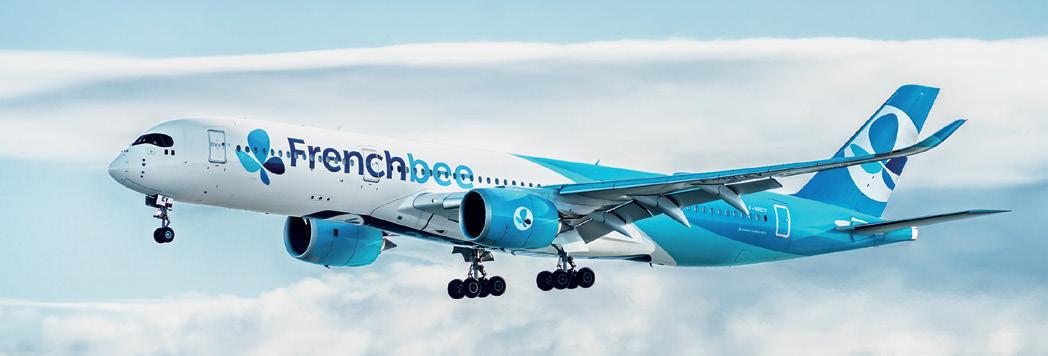
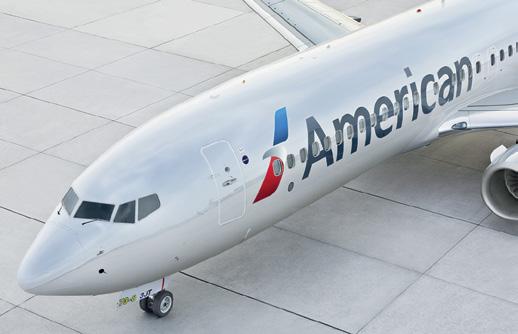
“With the addition of MIA to our network, we reinforce our positioning as a transatlantic specialized carrier with two gateways on the West Coast and two on the East Coast,” says Thomas Renault, director of sales for the U.S. “Miami being a gateway, it also benefits our business model by allowing us to optimize our aircraft planning in a market we already understand well. We’ve had an operations and sales team supporting the airline in the U.S. since 2018.” The airline was also incentivized to come to Miami due to the airport’s connectivity with the French Caribbean islands, says MIA’s Pineda.
French bee also partners with SNCF, France’s national stateowned railway operator, to offer packages combining train and air fares so that passengers can explore all of France, not just Paris. It also works with Alaska Airlines in the U.S., giving customers access to other cities in the States with the purchase of a single ticket.
The nonstop flights to and from MIA were operating thrice weekly before increasing in April to four times per week. “We saw a really good response from the market soon after launch, with good momentum for the summer that we think we can capitalize on,” Renault said, adding that they are focused on “strengthening roots” in the States before considering further expansions.
EMIRThe airline was also incentivized to come to Miami due to the airport’s connectivity with the French Caribbean islands...PINEDA, DIRECTOR OF MARKETING AND AIR SERVICE DEVELOPMENT AT MIA, ON FRENCH BEE Photo by Rodolfo Benitez
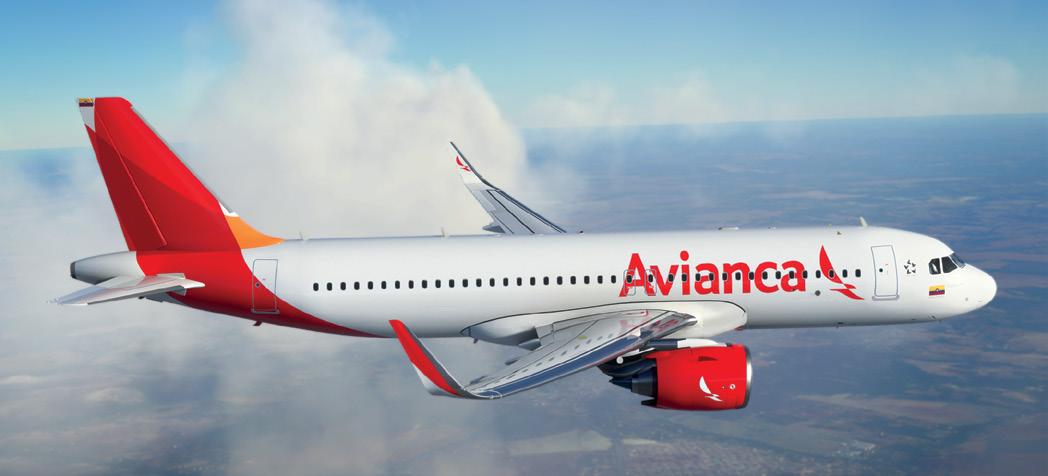
Colombian airline Avianca took major strides last December in expanding their portfolio of flights to and from Miami with three weekly flights to Bucaramanga (BGA), four weekly flights to Pereira (PEI), and two weekly flights to Santa Marta (SMR). While flights to Pereira are also available through American Airlines, both Bucaramanga and Santa Marta are completely new destinations for MIA. The Pereira route has since been downgraded to only once per week.
According to Cirium, Avianca now offers 21,384 weekly passenger seats to eight Colombian cities from Miami – an increase of 30.8 percent compared to pre-pandemic levels – at a time when trade between South Florida and Colombia is booming, especially in aircraft parts, which was Miami’s top export to Colombia last year. The increase in flights also makes Avianca the second-largest airline in the Colombian market behind only American Airlines, which just cut a pandemic-era route to San Andrés Island due to “soft demand.”
Last year, Avianca sought to combine forces with Viva Air Colombia, but the merger was blocked in November by Colombian regulator Aerocivil on competitive grounds. After an appeal, the merger was approved, but by then Avianca had decided to back down, citing “the conditions of [the] resolution” as making “rescuing Viva impossible.” Viva officially filed for Colombia’s version of bankruptcy protection in February. Avianca itself, with 12,000 employees and over 130 aircraft, has emerged from Chapter 11 bankruptcy, having restructured the company at the end of 2021.
Pre-pandemic, Colombia was MIA’s busiest international market with 1.5 million total passengers in 2019. In 2022, passenger traffic surpassed pre-pandemic numbers with 2.2 million total passengers, and the advent of the new routes from Avianca will continue to increase those numbers this year. As of April, Avianca was already up over 12 percent in total flights compared to April of 2022. In May and June, however, the U.S. State Department issued a travel advisory warning asking tourists to “reconsider” traveling to Colombia, especially to remote areas and near the border with Venezuela, due to recent increases crime and terrorism. How that will effect demand remains to be seen.

After an 18-year hiatus, Air Canada relaunched its route connecting Miami and Vancouver in December. It’s the only nonstop commercial flight that exists between the two cities as of now and will act as a strategic connection for Air Canada’s Pacific routes. Miamians wanting to go to Asia can use Vancouver as a layover stop for flights to Seoul, Shanghai, Tokyo, Hong Kong, and Bangkok, as well as Sydney and Brisbane in Australia and Auckland, New Zealand.
“We’re enabling traffic between those regions by adding the flight to Vancouver,” said Vincent Gautheir-Doré, senior director of U.S. sales, adding that, “[Vancouver] was the largest unserved market for nonstop service between Canada and Miami. [There was] a need to have a link that’s efficient, and that’s why the route will be a year-round service.”
Air Canada is the largest carrier serving the Canada-to-Miami market, serving MIA from Toronto (YYZ) and Montreal (YUL) with a total of 14,234 weekly seats. The Vancouver flight will operate thrice weekly in the winter and twice weekly in the summer. In early May, however, Air Canada ramped up the flight to five-times weekly due to the demand for the Formula 1 Miami Grand Prix.
Brazilian low-cost carrier GOL announced two direct routes connecting Brazil and Miami in December, one of which is completely new and the other of which is a resumption after a two-year COVID-induced hiatus. The new route is to Manaus (MAO), the largest city in the Amazon rainforest, and the resumed route is to Fortaleza (FOR), which connects northern Brazil to the U.S. via MIA. Miami now has five direct flights to Brazil, which was the city’s second-largest international market before the pandemic.
GOL, the largest Brazilian airline, also has a partnership with American Airlines, making MIA (where American has a large hub) an attractive option. “It makes more sense flying through Miami and making all the connections with co-shared flights,” said International Business Development Manager Luiz Teixeira. The two airlines share flights to 35 destinations in North America and “almost 95 percent of all Brazilian territory that [GOL] covers,” according to Teixeira.
Dominican airline Sky High is now offering four weekly flights connecting MIA with Santo Domingo (SDQ). The route is the carrier’s first in the U.S. and its fifteenth overall since its founding in 2012 and will allow passengers from Venezuela and the Caribbean islands to make connections through the D.R. to reach Miami. Pre-pandemic, the Dominican Republic was MIA’s sixth-busiest international market with about one million travelers in 2019.
In 2022, that number was up to over 1.6 million, with Santo Domingo itself far outpacing any other D.R. destination, with 837,135 passengers in 2022. Sky High will be the sixth passenger airline with a route connecting the country to Miami.

Not to be confused with the long defunct Eastern Air Lines, which was headquartered at Miami International Airport before its dissolution in 1991, Eastern Airlines first began as Dynamic Airways, which went bankrupt and then renamed itself in 2018.
The carrier announced a single monthly route connecting MIA with Santo Domingo’s Las Americas International Airport (SDQ) in December, its only regular flight after it was forced to cut all 12 of its other routes throughout the Americas due to a lack of demand. Despite this, the airline is still operating, mostly due to international charter flights that use its fleet of Boeing 767s.
Suspended during the pandemic in 2020, Delta Air Line’s service to Cuba resumed in April after a three-year hiatus. The Havana (HAV) route will operate twice daily, once in the morning and once in the afternoon, competing with American Airlines’ existing flights to the Cuban capital, which operate eight times a day excluding Saturdays. With the restart, Delta customers traveling from Havana to Miami will also have access to 10 U.S. airports through the airline.
After a two-year hiatus, Aer Lingus resumed its route connecting Dublin (DUB) and Miami in October of last year, offering service between the two cities three times per week on Wednesdays, Fridays, and Sundays. U.S. passengers can also use the route to connect to UK airports, including London Heathrow. Aer Lingus is the only carrier to operate direct flights between Miami and Ireland and is considering further expansion in North America. It will also resume several other U.S.-based flights this summer.
VOLARIS EL SALVADORA subsidiary of Mexico-based Volaris, Volaris El Salvador just launched a route connecting Miami with San Salvador (SAL) in March. The flight, which operates thrice weekly, is one of three new routes that connect El Salvador’s capital with the U.S., and includes a layover in Honduras. The low-cost carrier will now compete with Avianca and American Airlines, both of which serve the same route. “With this new flight, we are uniting three very dear countries,” said Regional Manager Rossana Hurtado. “We are sure that it will be a complete success.” In 2022, almost 260,000 passengers traveled between Miami and San Salvador.
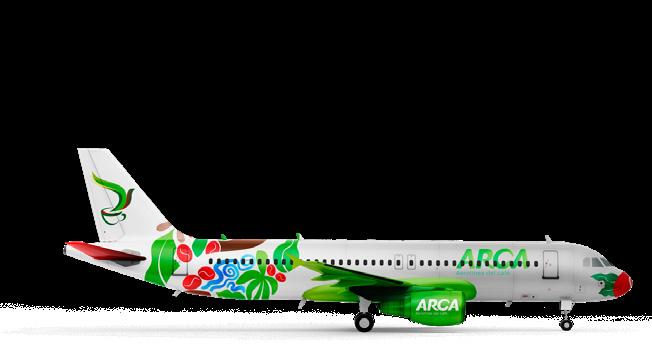
Having received approval from the Colombian authorities, new airline ARCA Air is looking to fly from Pereira to Miami three times weekly. Depending on the success of that route, ARCA may look into flights out of Palm Beach International Airport (PBI), north of MIA by some 70 miles. President Tony Guerra says he is hoping for a September start to the flights, which will operate on Mondays, Wednesdays, and Fridays.
“We’re looking right now at what’s happening with the market,” says Guerra, citing his concerns over the State Department’s recent announcement urging Americans to “reconsider travel” to Colombia. The travel advisory warns of increased violent crime in Colombia, in addition to terrorism and street protests – though noting that most of the danger lies close to the border with Venezuela and in certain remote areas, and that Americans are not being specifically targeted by terrorist groups. “It’s complicated for Americans to fly to Colombia right now,” Guerra said. “We don’t know what’s going to happen with the market.” As of publication, neither ARCA Air nor MIA had announced anything officially.
Despite State Department warnings about travel by tourists there, connectivity to Colombia is clearly on the rise, and Ultra Air is also looking to expand. The small low-cost Colombian carrier launched operations early in 2022 out of Medellín International Airport (MDE) and, in November, requested permission to operate 33 international routes from five cities in Colombia. Of those 33 routes, three would connect to MIA: Barranquilla (BAQ), Cartagena (CTG), and Cali (CLO). The airline is also looking to expand domestically with seven new routes within Colombia.
Juan Fernando Arango, vice president of operations, says that there is a “need” from both Colombians and foreigners “to have a friendly, affordable, and punctual alternative to make their travel plans a reality.” Indeed, so far Ultra Air has performed admirably with a punctuality rate of 98 percent in its first six months of operation, with over 5,361 domestic flights.
The aggressive expansion plans are notable since Ultra Air currently does not operate internationally. As of publication, MIA had not confirmed if the airline would begin operations out of Miami or not.
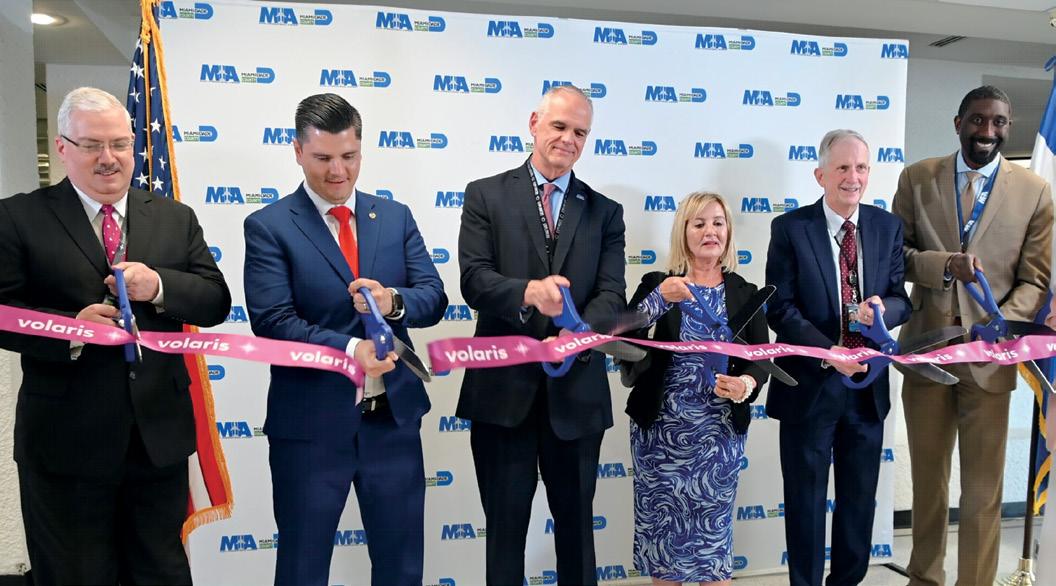

Miami’s global connections are not only financial but cultural as well, and supercharging this social scene is one of the city’s youngest art venues – El Espacio 23 in Allapattah, the western neighborhood where numerous galleries and museums (most notably the Rubel) have landed after fleeing more expensive venues in Wynwood and elsewhere.
El Espacio 23 is an endeavor of art-lover Jorge M. Pérez, chairman and CEO of the Related Group and a founding spirit and philanthropist of downtown’s eponymously named Pérez Art Museum Miami (PAMM). El Espacio 23 is casting a wide international net, with a pointed focus on contemporary African works. As it prepares for its fall show – the fourth since opening in 2019 – curators will call into conversation art from the African diaspora, particularly in Latin America and the U.S., with art and artists from the motherland.
While the treasure trove of art Pérez donated to the PAMM was rich in Latin American mid-century artists and connects to Pérez’s Cuban roots, the El Espacio 23 collection is different. Here, the emphasis is
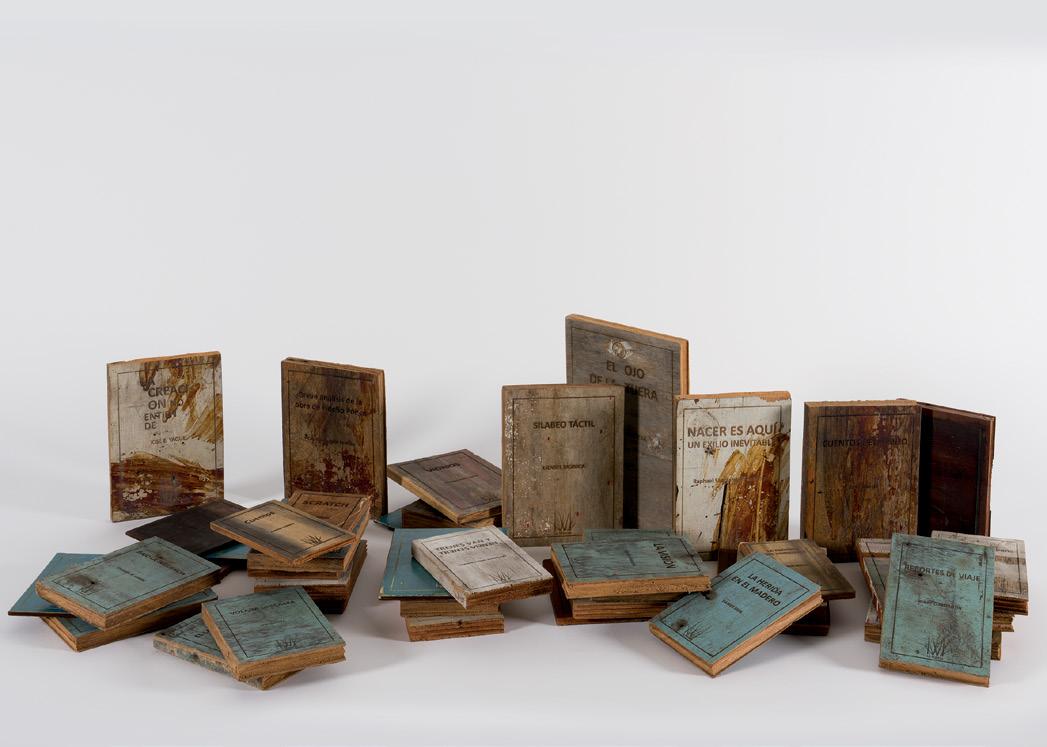
toward a more contemporary and international scope. While the works of older artists are not ignored, living artists are the focus.
El Espacio 23’s inaugural show, “Time for Change: Art and Social Unrest in the Jorge M. Pérez Collection,” displayed works by more than 80 artists from around the world. The space’s second exhibit, “WITNESS: Afro Perspectives from the Jorge M. Pérez Collection,” featured upwards of 100 works from African and African diaspora artists. The upcoming show, scheduled for November, will also feature contemporary African artists, and those with a connection to the continent.
Such links stood out when researching and collecting Cuban, Brazilian, and African American art, says Anelys Alvarez, assistant curator at El Espacio 23, the Jorge M Pérez Collection, and the Related Group. “For many artists, Africa ties together the different areas of concentration,” she says, creating a web of connections encompassing African American artists, Afro-Cuban artists, Afro-Brazilian artists, and others with cultural or ancestral ties to the continent.
One need not wait until after hurricane
season to visit El Espacio 23, however. It has a terrific show going on through the end of July. “You Know Who You Are, Recent Acquisitions of Cuban Art from the Jorge M. Pérez Collection,” is a sharp, wry, often painful look at the work of mostly contemporary Cuban artists.
El Espacio itself is two connected warehouses – high ceilinged and expansive, with a lively, energetic feel, and a conceptual approach both accessible and pointed. Upon entering the 28,000-square-foot venue, an inviting pair of couches bracket what at first appears like a typical coffee table covered with books. Yet a closer look reveals the books are wood. It’s the work of Lester Alvarez, who is speaking about censorship with “books” that were never published and are impossible to read anyway.
Other standouts among the treasure trove of “commentary” art, laced with aesthetic and intimate experience, are the

RIGHT:
“LOS HEROES NO PESAN" BY LUIS MANUEL OTERO ALCÁNTARA UNIQUE EXPLORATIONS OF THE CUBAN EXPERIENCE HAS GAINED HIM INTERNATIONAL ATTENTION. IMAGES COURTESY OF THE ARTIST AND CLAUDIA GENLUI
wooden sculptures of Luis Manuel Otero Alcántara. The table-top size figures are from the series “Los héroes no pesan” (Heroes do not carry weight) and demand attention. The rough-hewn human shapes, which seem to snarl with vulnerability, are created from reclaimed wood and reference, in part, Cuban veterans of the Angola War. Alcántara himself, who was named by Time magazine as one of the most influential people of 2021, was sentenced for his activism to a Cuban jail, where he remains. l



You’re a young entrepreneur who’s considering starting or moving your business to Miami. Maybe it’s a fintech company and you’re looking to join the new South Florida fintech hotspot, or maybe you’re a transplant from Silicon Valley looking to make a name for your company in Latin America. Whatever the case, you’ll need to visit Miami first, to figure out if the culture fits, where you’ll want to open your office, and maybe just to have a little fun. Look no further than the Arlo, the only hotel located in Miami’s Wynwood art and innovation district.
The Arlo is vibrant, joyful, and full of art and young people. It’s smack dab in the middle of Wynwood, with a plethora of restaurants, bars, galleries, and shops within walking distance. The hotel itself is home to a high-end restaurant, MaryGold’s, and two bars: Higher Ground, an indoor-outdoor cocktail bar located on the third floor, and a poolside bar with bites.
Despite being in a hotel, Higher Ground is something of a place to be on weekend nights, when the courtyard fills with tipsy tourists and loquacious locals looking for a handcrafted drink courtesy of Bar Lab, the company behind one of the top 50 bars in the world (Broken Shaker on Miami Beach). The bar has also recently expanded its offerings to include lunch and an extended happy hour, and there’s a barbecue station outside. (Pro tip: if you’re planning on partying here, get a room on the same floor so your stumble “home” will only take about 15 steps.)
The cocktails’ bases range from bourbon to gin to mezcal and everything in between, each enhanced by Higher Ground with a list of ingredients so long it’s surprising the bar isn’t bigger. Our favorite was “Above the Canopy,” which combines cucumber and mint vodka with St. Germain and Lustau Blanc Vermut, a liqueur made from botanicals and two kinds of sherries. As if that
BY KYLIE WANGTHE ARLO IS IN THE HEART OF WYNWOOD, MIAMI'S VIBRANT YOUNG NEIGHBORHOOD.
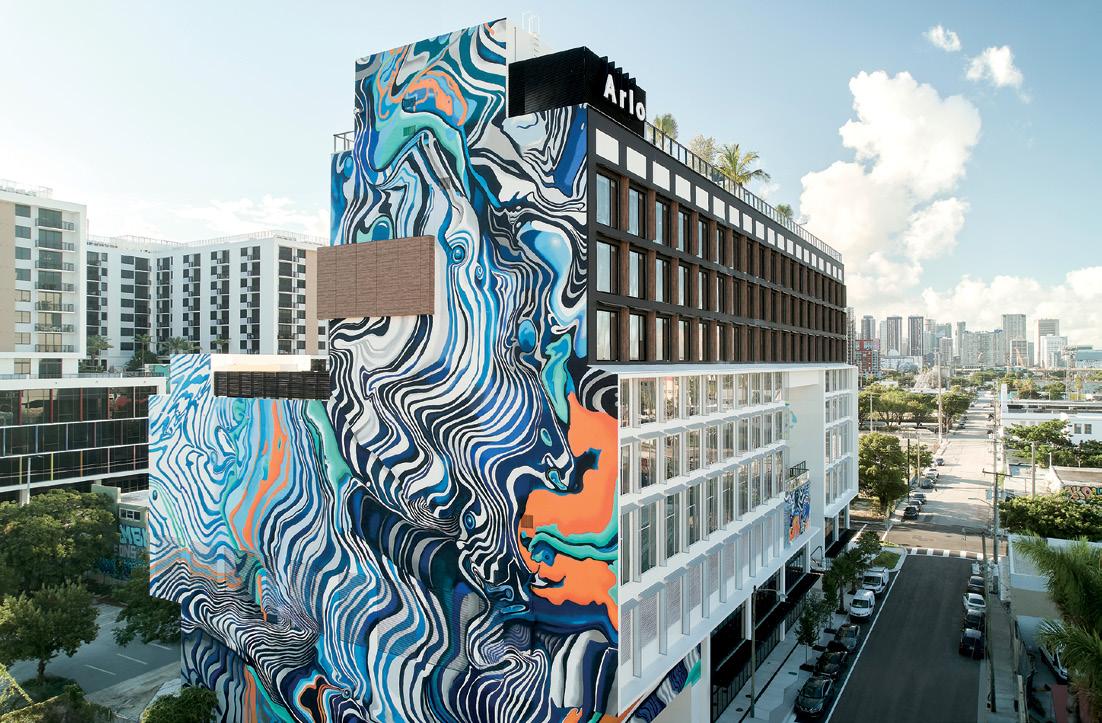
OPPOSITE:
1. THE SWIMMING POOL IS LINED WITH CABANAS AVAILABLE FOR RENT.
2. MARYGOLD'S RESTAURANT IN THE LOBBY SERVES INVENTIVE CUISINE.
3. THE HIGHER GROUND BAR ATTRACTS A CROWD ON THE WEEKENDS.
4. THE ARLO IS DECORATED IN THE WYN WOOD 'GRAFFITI' STYLE WITH VIBRANT COLORS.
5. ROOMS HAVE INDIVIDUAL BALCONIES TO RELAX AND TAKE IN THE SUN.
6. WITH SO MUCH TO DO, IT'S COMFORTING TO KNOW YOUR BEDROOM IS STEPS AWAY. ARLO WYNWOOD 2217 NW MIAMI CT 786.552.6600
ARLOHOTELS.COM
wasn’t quirky enough, it also has fresh aloe, eucalyptus, and cucumber soda. We spent quite a while questioning the sourcing –where the heck do you find cucumber soda? And if you’ve never heard of Lustau Blanc Vermut, you’re not alone.
The pool is heated to a refreshing 75 degrees with cabanas (complete with fans, TVs, and mini fridges) available for rent by the day, starting at $300 on weekdays and $600 on weekends. The bar on the deck offers drinks and bites, including an interesting watermelon dish, where the wedges are compressed and served with a citrus marinade and tajin. Odd, but also invigorating and juicy.
While the pool and Higher Ground might be more enjoyable, the fare pales in comparison to that of MaryGold’s, located in the lobby, where the cuisine is no less strange but wonderfully toothsome. From oxtail beignets to ricotta “pillows” to tortellini with escargot, the dishes from Chef Brad Kilgore are distinctive, inventive, and perfectly paired with a coterie of Bar Lab cocktails. We fell in love with the oxtail beignets ($20), which are a blend of savory and sweet, served with coconut-gouda cheese and green onion. Three to a plate, they’re easily shared and take the consumer on a culinary adventure. Also fantastic is the steak au poivre, a more traditional dish elevated not so much by out-of-the-box ingenuity as by the “extras” – spun mashed potatoes that are heavenly soft and delicately flavored, and a foie poivre sauce so delicious it led us to a Google search for similar recipes to make for ourselves. And around the corner in the lobby is MaryG’s, a grab-and-go-style café with coffee and snacks.

To work off all these extra calories, we recommend forsaking the Arlo’s gym (all the usual gear) and instead going for a walk in the neighborhood. The Arlo isn’t the only building decked out with art – almost all of Wynwood is covered in paint. Walking distance from the hotel is Wynwood Walls, where $12 grants you access to over 35 outdoor murals and two galleries. The Paradox Museum, less than a block away, will have you questioning your sanity with creative exhibits that seem impossible. Along NW Second Ave, you’ll find a litany of restaurants, galleries, and shops, including Wynwood Marketplace, which hosts garage-style eateries and boutiques. On the weekends, a visit to Smorgasburg, Wynwood’s open-air food market, is a must for tourists and locals alike.

With so much to do and the Arlo at the center of it all, you may end up spending more time on fun than work. But how else will you know if you want to move to Miami? l



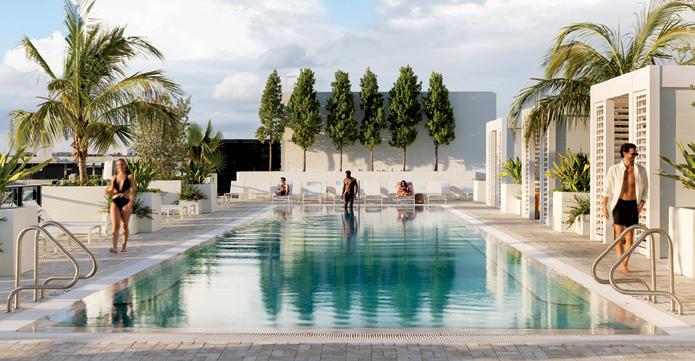
Miami-Dade County continues to set new records for prices in the housing market, bucking the nationwide trend of decreasing costs. The county’s median sales price in May reached $620,000 for a single-family home, up $20,000 from the month prior and up more than $45,000 from May of the previous year. On the
high end, there are now more than five dozen homes and condos on the market at prices of $10 million or more. We asked several Miami-based realtors for some of their recently sold listings in the more moderately priced $5 to $6 million range, an effort to showcase not only what’s on the market, but what it’s being sold for.
Grove at Grand Bay is a new landmark in the highend neighborhood of Coconut Grove. Offering amenities like a spa, gym, restaurant, ground and roof-top pools, as well as valet and concierge services, this res-
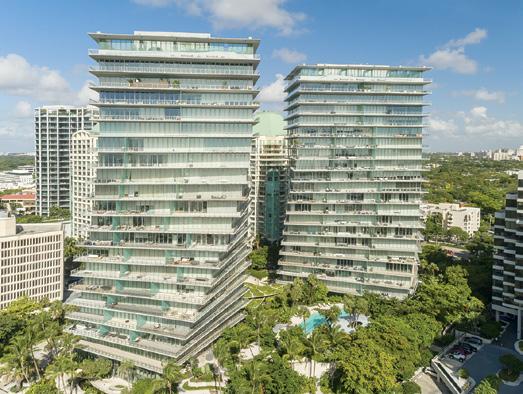
idence comes with a private elevator and lots of natural light from the wrap-around terrace and 12-foot tall sliding doors. Listing Agent: Tere Shelton Bernace (Shelton and Stewart Realtors), 305.607.7212
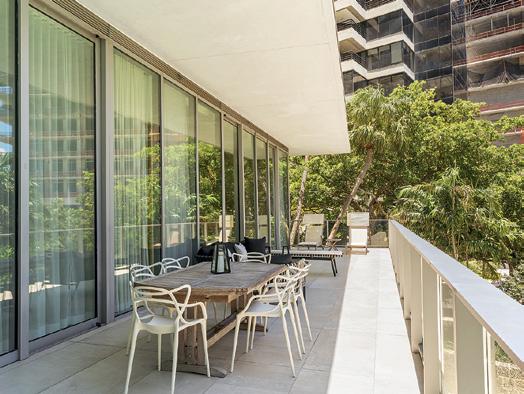
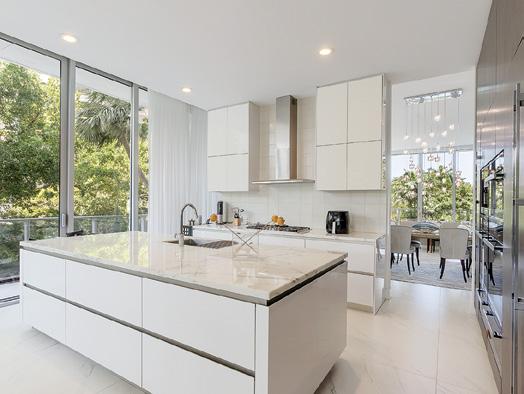
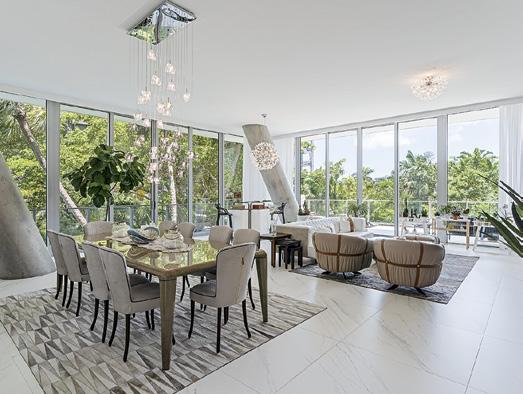
This new waterfront home in the gated Kings Bay community is replete with sunny, open-plan living spaces, entertainment-ready outdoor areas, and thoughtful design features. Set against incredible views of Deer-
ing Bay Marina, which can be seen from almost every room, the 13,649-square-foot lot has 117-feet on the water. Listing Agent: Ashley Cusack (Berkshire Hathaway HomeServices EWM Realty), 305.798.8685.
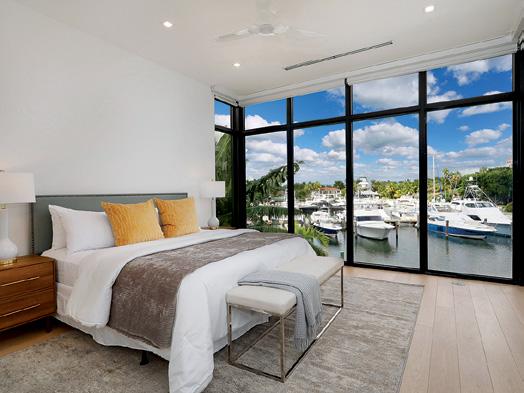
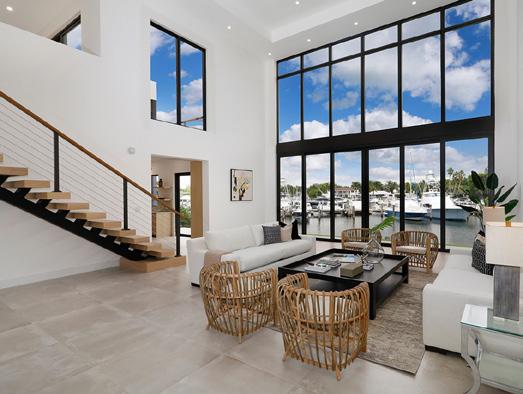
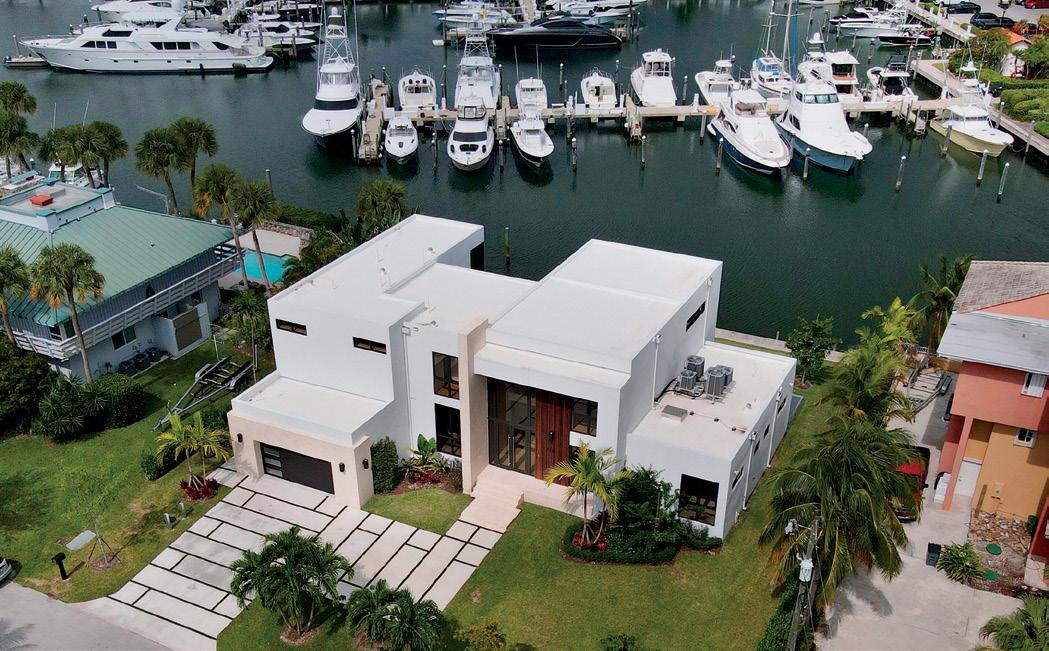
LISTING PRICE: $7.15M SOLD FOR: $6.6M

This exemplary one-story transitional gem is located in the prestigious Cocoplum neighborhood, a perfect blend of artistry and sophistication. Newly renovated with superlative design and luxurious el-
ements. A brilliant integration of indoor and outdoor living and grand scale entertaining. Listing Agent: Josie Wang (Brown Harris Stevens), 305.666.9759.


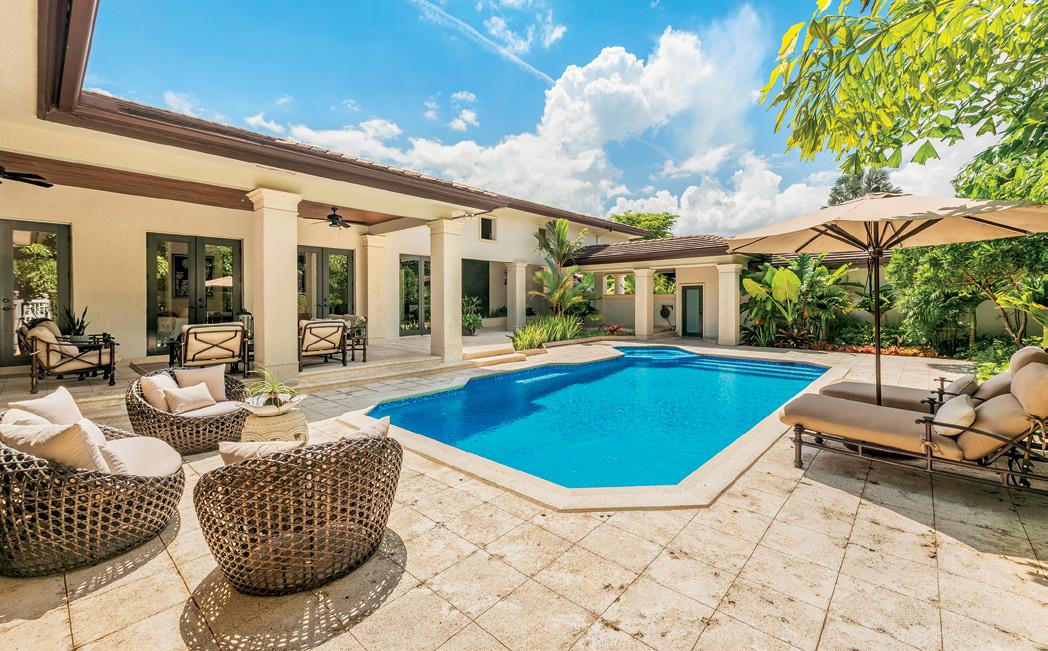



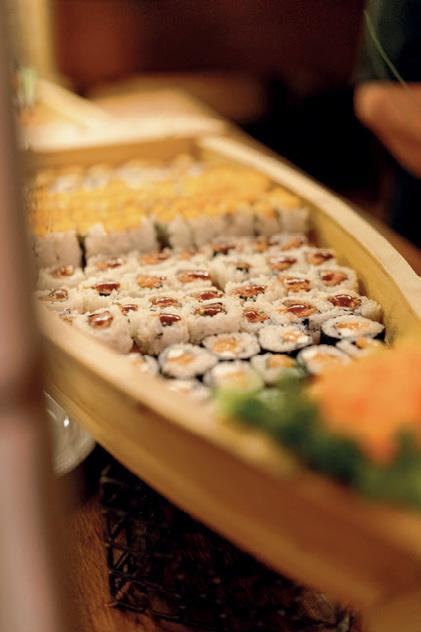
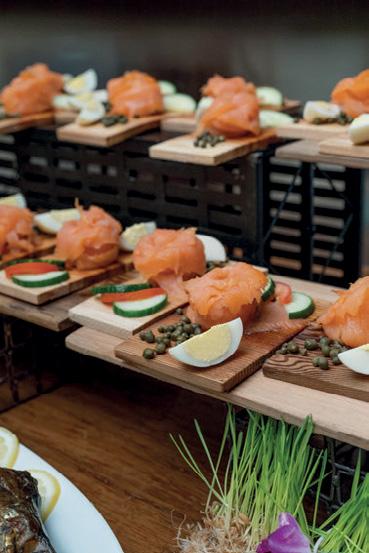

There is something both modern and turn of the century about Brasserie Laurel, chef/owner Michael Beltran’s hip French entry into the downtown eating scene. It may be the juxtaposition of 21st century high rises all around, contrasting the warm, interior design elements of curves and circles, which feel Art Nouveau, like a subway entrance in Paris. Or, it may just be the timeless quality you get in any good French café, where urban chic meets a menu replete with Francophile classics like escargot and foie gras.
Brasserie Laurel is now eight months old, the first fine dining establishment to plant its flag in the $5 billion WorldCenter project, 27 acres of mixed-use skyscrapers and pedestrian malls that are creating a glamorously modern neighborhood on the northern edge of the old downtown. Buildings are still rising around Brasserie, a restaurant destined to become a reservations-only hotspot in this new world. So now is the best time to experience this WorldCenter pioneer before it is fully discovered and overrun.
The first thing you’ll notice about Brasserie is attention to detail. They easily win the best cutlery award in Miami, with fluted butter knives and streamlined forks, special for each dish, and delicate glassware. The seating is either in an outdoor garden setting or inside, at one of the many curved booths that line the tall glass windows, enhanced by a terrazzo floor that continues the circle-within-a-circle visual theme. The music, at perfect volume, is a kind of French African house jazz – very cool.
If you measure a restaurant by its bread, Brasserie scores another win. What better prelude to dinner than hot rolls, theirs served with ice cold butter and anchovies, something unique in Miami. The cocktails are also lovely, concocted in the gold, blue, and marble bar that centers the restaurant. We tried the Monte Carlo, a sophisticated blend of rye, bitters, and French herbal liqueur, which came with one giant ice cube, and the Garçon’s Sharpener, a refreshing mix of gin, cognac, lemon, orange, bitters, and soda.
We ordered two appetizer salads, the first a tasty tuna crudo with green beans, olives, egg, and tomato, a kind of crudo tuna niçoise, a clever mix of crunch and saltiness. The second was their chicory salad, which includes endive, Bosc pear, lumps of Shropshire blue cheese, and castelfranco (an Italian purple veined lettuce). This was a real wow, with the expected edge of endive bitterness balanced by the sweetness of sliced pear and the saltiness of the cheese, a beautiful taste combination.
We also tried the escargot, which was not served in the traditional cupped plate but ensconced in a tureen of light pastry, which absorbed the herb butter nicely. Then came the foie gras, which did not appear in its usual guise of sliced grey goose liver but came embedded with cocoa nibs and green onion bits, accompanied by a canelé pasty, all glazed in a raspberry gastrique sauce. Simply gor-
TOP: EXECUTIVE CHEF ASHLEY MONCADA, WHO TRANSITIONED TO BRASSERIE LAUREL FROM ANOTHER RESTAURANT OF OWNER BELTRAN’S ARIETE HOSPITALITY GROUP.
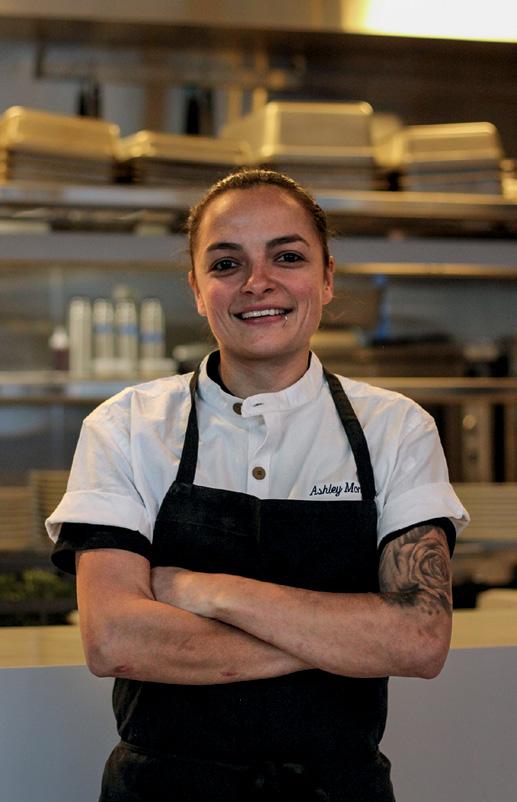
ABOVE: IMPECCABLE SERVICE AND ATTENTION TO DETAIL IN THE DINING ROOM
OPPOSITE:
TOP LEFT: TUNA CRUDO SALAD
TOP RIGHT: ESCARGOT IN PASTRY
BOTTOM LEFT: LOBSTER IN A BISQUE
BOTTOM RIGHT: VENISON IN SAUCE AU POIVRE
BRASSERIE LAUREL
698 NE 1ST AVE. 305.330.9048

geous in appearance and taste.
Nor did the entrees at Brasserie Laurel disappoint. Having been too cowardly to try the frogs’ legs, we stretched our palates with lobster in a bisque served with veal sweetbreads (yes, organ meat!) and venison, the latter served in a pool of sauce au poivre, with a flat, fried potato rosti. Both flavors were at the edge of the known, with the creamy sweetbreads and the sweet and slightly gamey – in a good way – venison. We balanced these with the slam-drunk burger au poivre on brioche, with gruyere cheese and caramelized onions, and a lamb chop special. We did not try the signature Boeuf en Croûte which, at $150, is a beef fillet wrapped in puff pastry that can easily feed four.
Overseeing the kitchen at Brasserie Laurel is Executive Chef Ashley Moncada, who transitioned from her role as chef de cuisine
of Ariete in Coconut Grove, another of the creations of Beltran’s Ariete Hospitality Group (which includes Chug’s Cuban Diner, The Taurus, The ScapeGoat, and El Vecino.) A veteran of kitchens in France, Australia, New Zealand, the UK, and Africa, Chef Ashley brings an inventive touch to haute French cooking, adding to the sense of the Brasserie being both a classic French restaurant and a cutting-edge modern Parisian café with a dash of Miami modernism.
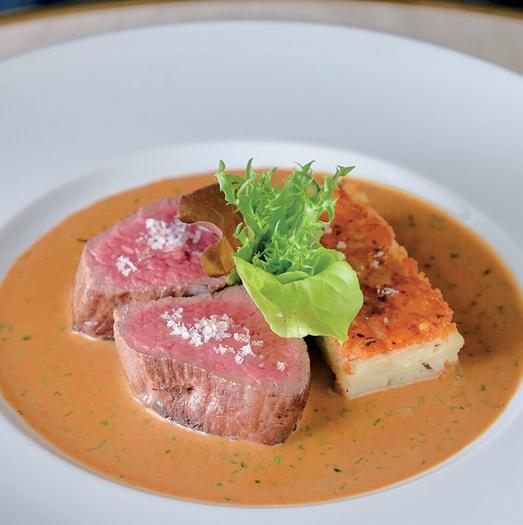

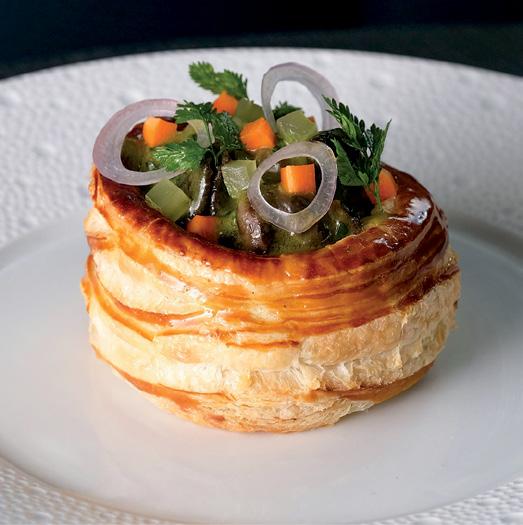
There is a feeling here that every detail has been attended to, from the comfortable seating to the curvilinear sconces. Brasserie exudes a confidence and competence, a kind of comfortable hipness, where the service is attentive without being noticed, and the sense of being very French is neither strained or staid. You feel like you’ve gone to someplace far away, and happily so. l

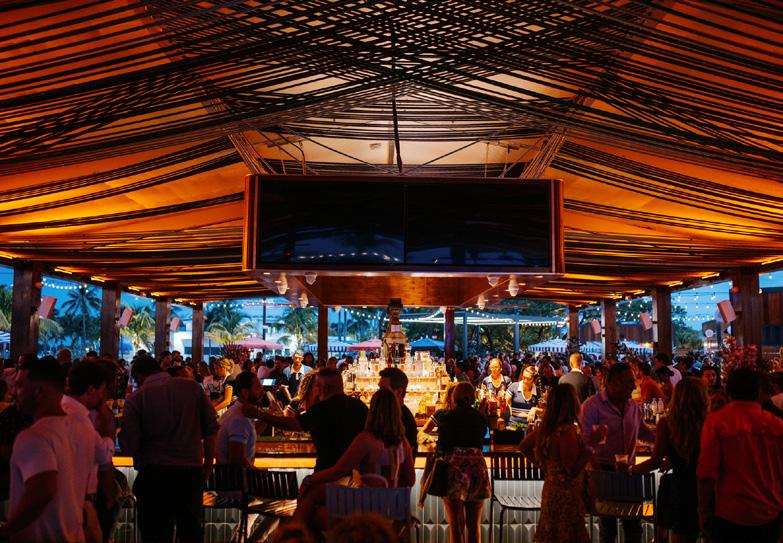
 BY KYLIE WANG
BY KYLIE WANG
If something’s not broken, you don’t try to fix it. Which is why Breakwater Hospitality took one look at the success they’d had with their previous open-air, waterfront gathering spots and pressed “copy.” Then, they headed down to Biscayne Bay in Coconut Grove and pressed “paste.”
Don’t misunderstand – Regatta Grove has unique elements that make it, in our opinion, the must triumphant success of Breakwater’s similarly constructed properties. But if you’ve ever visited either of The Wharf locations in Miami or Fort Lauderdale, you’ve definitely seen a version of this before.
The biggest difference here is Regatta’s dining options. The culinary lineup is like something out of a foodie’s daydream, with three James Beard semi-finalists (Chefs Jose Mendin, Jeff McInnis, and Janine Booth), one Michelin-starred chef (Jeremy Ford), and one Top Chef finalist (Kenny Gilbert). Together, the five have set up small, openair eateries at Regatta, operating out of refurbished TEU containers that surround a playful green area set up with picnic tables.
Sunny Side Up Aussie Bites by Booth (of Stiltsville Fish & Bar, Root & Bone, and Mitalia fame) serves up exactly that, with sausage rolls, avocado toast, and “bubble waffles,” which come packed with ice cream and unusual toppings (pocky sticks, anybody?). McInnis (of Gigi and Yardbird) does things more Florida-style at his Tackle Box fish shack, with fresh-caught local seafood ranging from lobster rolls to crab cakes and the catch of the day.
Gilbert (author of "Southern Cooking, Global Flavors"), meanwhile, offers up deep
TOP: THE THEME OF REGATTA GROVE IS OPEN-AIR AND FUN! THE FOOD IS
BOTTOM: AN OPEN-AIR BAR COMPLEMENTS THE FOOD
OPPOSITE: CHEF KENNY GILBERT OF HOUSE OF BIRDS & BISCUITS SERVES UP CLASSIC SOUTHERN DISHES, INCLUDING FRIED CHICKEN (MIDDLE) AND BARBECUE CHICKEN (BOTTOM).
REGATTA COCONUT GROVE
3415 PAN AMERICAN DRIVE OPEN THURSDAY - SUNDAY
South comfort food at the House of Birds & Biscuits, where you can choose from a variety of fried chicken sandwiches or try lighter sides like the kimchi watermelon rind. Mendin (of Nobu, Mosaico, Mercadito, and Sushisamba) keeps it simpler with The Piefather, a traditional pizza spot with a house-made specialty sauce and an interesting blend of toppings. And Ford (Stubborn Seed, Beauty & the Butcher) goes all out with his JJ’s Guilty Pleasures, where the menu consists of all the fast-food items you love to regret later: burgers, tacos, onion rings, and fries. Yum.



Of course, there are drinks aplenty as well. We counted five bars at Regatta, two on the smaller side, and another three featuring a full coterie of spirits, wine, and beer, in addition to the venue’s own tropical cocktails.
On a weekend when Regatta stays open all day and night from noon until 3 am (the location is only open Thursday through Sunday), the scene ranges from an upbeat brunch with lawn games and sports on the TVs lining the main bar to a real Miami nightlife experience with partiers ranging from 21 to 60-years-old stumbling past views of the marina, cocktails in hand, and music from a live DJ pumping throughout the space. But no matter when you go, it will certainly be fun – barring a little Miami rainstorm, of course. l
 BY AARON ROSEN
BY AARON ROSEN
Across the U.S., Asian-Americans make up about seven percent of the total population. In metropolitan areas such as Washington, D.C., New York, Seattle, and San Francisco, those numbers rise to between 12 percent and 30 percent, respectively. In Miami-Dade County, Asian-Americans form less than two percent of the population.
Currently, only Japanese and Taiwanese officials enjoy a full-time diplomatic presence in Miami. Some Asian states, like South Korea and Singapore, have designated notable Miamians as Honorary Consuls. Others, like India and China – which together have roughly 40 percent of the global population – have no representation here whatsoever. Why does this matter? Without these professional diplomats in our community, Miamians miss out on cultural, economic, political, and academic ties to the Pacific, enjoyed by our peers in other leading U.S. cities.
Luckily, Miami’s civil society is building bridges. This spring, the newly arrived Ambassador of Thailand visited Miami to learn about our community and explore opportunities for engagement. Florida International University’s Jack D. Gordon Institute for Public Policy and the World Affairs Council of Miami organized an information exchange between community representatives and the visiting ambassador on trade, security, and the geopolitics of Southeast Asia. Through the visit, the ambassador was able to learn about Miami’s current boom and explore how Thailand could connect.
The exchange with the ambassador was supported by Miami-Dade County’s Asian American Advisory Board (AAAB), which recently celebrated 25 years of advising local leaders on Asia-related matters. The AAAB also promotes the annual Asian Culture Festival, Miami’s largest reoccurring gathering showcasing pan-Asian culture.
A stronger relationship with Japan
is also beginning to blossom. The Japan-America Society recently inaugurated a Miami/South Florida chapter, not long after notable Miamians, including Mayor Levine Cava, gathered at the residence of the Japanese Consul General to call for deeper engagement. One action item was a permanent aviation link between Miami and Tokyo. Notably, a Japan Airlines flight made history this spring as the first ever to fly non-stop between Asia and South Florida.
Also of note is Taiwan. Its diplomats enjoy a welcome in anti-communist Miami, not to mention strong support in Tallahassee, where, in May, the Florida House of Representatives passed a resolution commemorating the 31st anniversary of sister-state relations. A few weeks earlier, I was invited to join a U.S. delegation to Taiwan. Together with a bipartisan group of U.S. legislators, civil society leaders, and city officials from across the country, I learned how cities and states from across America are developing ties with one of the world’s most advanced and strategically critical economies.
These civil society-led meetings, festivals, cultural associations, and delegations are critical for advancing people-to-people ties. But to fully engage Asia, Miami needs a comprehensive, strategic vision – something like the way the community worked to cultivate a booming tech sector where, a few short years ago, hardly any existed.
Whether in relation to mass-transit, climate resilience, urban planning, or workforce training, Miamians are hungry for new ideas. Seoul and Tokyo are home to some of the world’s most efficient public transport systems. South and Southeast Asia are on the frontlines in the battle against sea level rise. Singapore has mastered the integration of green and recreational spaces into densely populated living. Taiwanese science parks advance industry and produce dynamic jobs in emerging fields.
Sister-city relationships at the county and city level should be used to explore these and other practices from abroad. In doing so, we develop import-export networks of ideas that enrich not just our community, but those who look to learn from us as well. l
CIVIL SOCIETY IS FORGING CONNECTIONS ACROSS THE PACIFIC, BUT A STRATEGIC VISION IS NEEDED
